Last week I had the great honor of giving a lecture to a group of enthusiastic students at the Orenburg State University in Russia.

The full title was Photography and Blogging as Tools to Promote Biodiversity Conservation and Sustainable Wildlife Tourism. I certainly gave my translator Oleg Krikotov a good challenge and I thank him heartily for his hard work conveying it to the students in Russian. Oleg is the director of International Programs at Orenburg University and a really great guy.
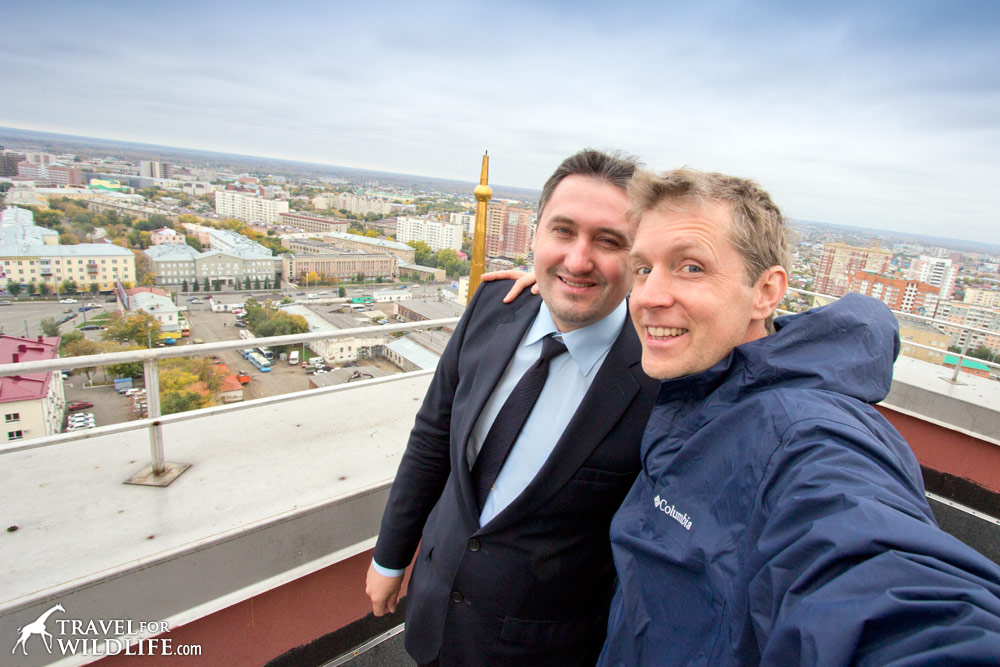
I was invited to travel to Russia by the Dersu Uzala ecotourism initiative to visit the critically endangered Przewalski’s Horses that were just released into the Preduralskaya Reserve (which was awesome!)
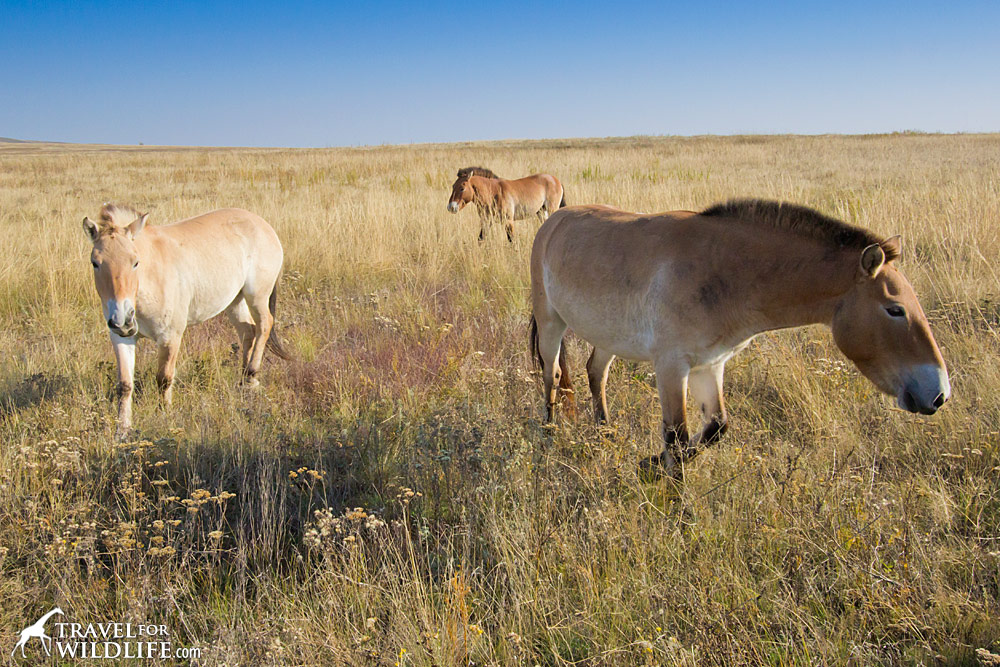
and along the way I had a chance to talk to these ecotourism students. They even published this short news article about my visit on the OSU website. (Turn on google translate to get an idea what it says in English!)
To help them share it among other students and universities, I decided to post the full transcript here, along with the slides I used. (All photos copyright © Hal Brindley, Travel For Wildlife.com)
Many thanks to Elena Bazhenova for organizing my trip, to Irina Polyakova for arranging the lecture, and to Nastya Lukinskaya for being my great translator and friend.
Enjoy!
Photography and Blogging as Tools to Promote Biodiversity Conservation and Sustainable Wildlife Tourism.
That’s a really long boring title. What we’re really talking about today is how two little things, photos and words, can change the course of life on Earth.
Why is this important?
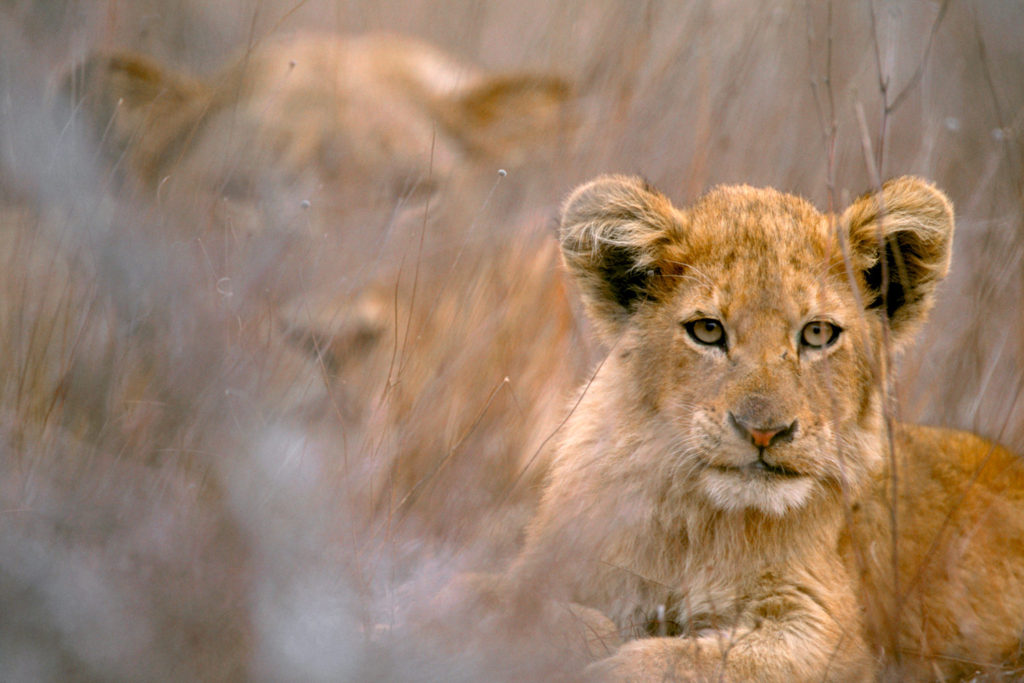 In my opinion life is the single most amazing thing that has ever happened in the Universe. I admit we haven’t seen a lot of the universe yet, but as far as we know, life is the greatest show that ever existed.
In my opinion life is the single most amazing thing that has ever happened in the Universe. I admit we haven’t seen a lot of the universe yet, but as far as we know, life is the greatest show that ever existed. 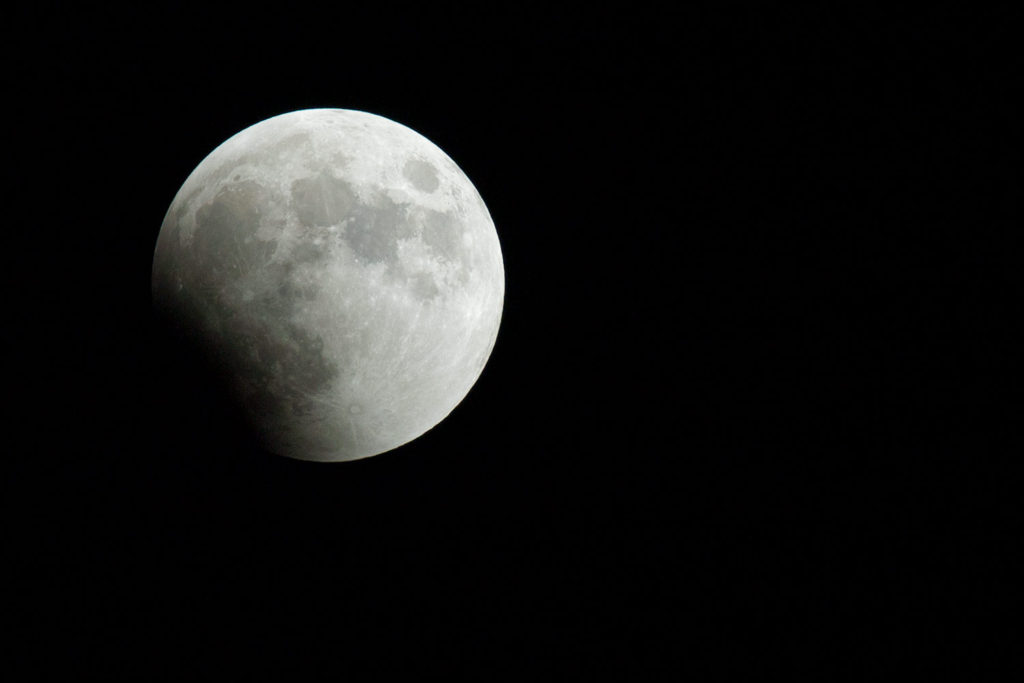 The universe is just a handful of basic elements swirling around and combining into interesting things like dust clouds and moons and planets and stars and galaxies. Each of them with a very interesting set of physical properties and fascinating dynamic behaviors. But none of these things even come close
The universe is just a handful of basic elements swirling around and combining into interesting things like dust clouds and moons and planets and stars and galaxies. Each of them with a very interesting set of physical properties and fascinating dynamic behaviors. But none of these things even come close 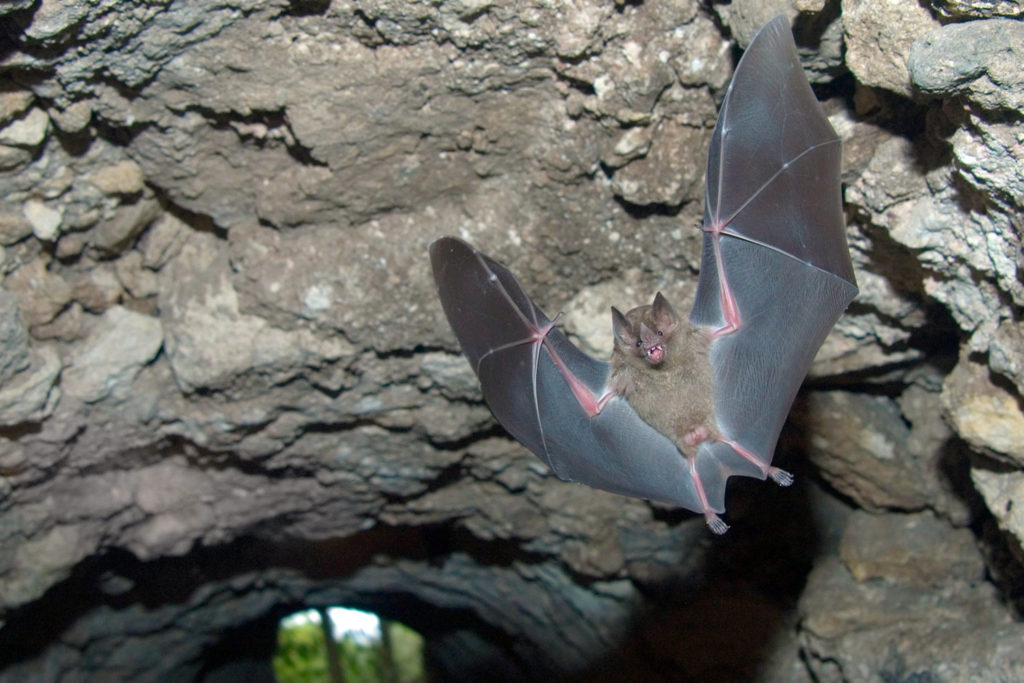 to the staggering complexity of what those same basic elements are doing right here on Planet Earth. They are assembling themselves into mind-boggling complex systems. Systems within systems within systems. Atoms within molecules
to the staggering complexity of what those same basic elements are doing right here on Planet Earth. They are assembling themselves into mind-boggling complex systems. Systems within systems within systems. Atoms within molecules 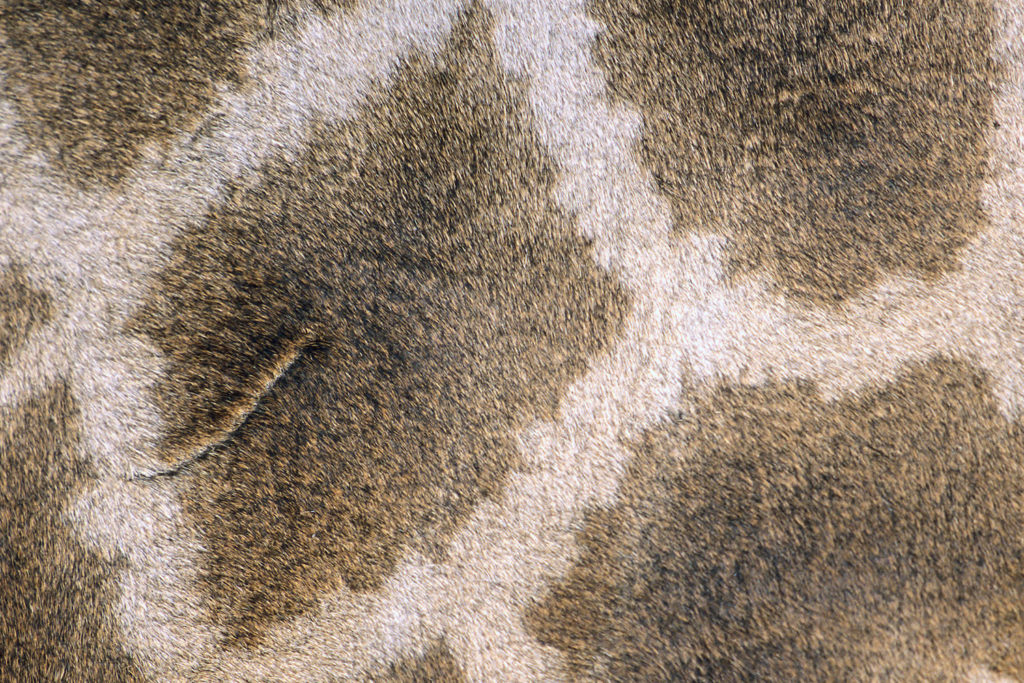 within cells within tissues
within cells within tissues 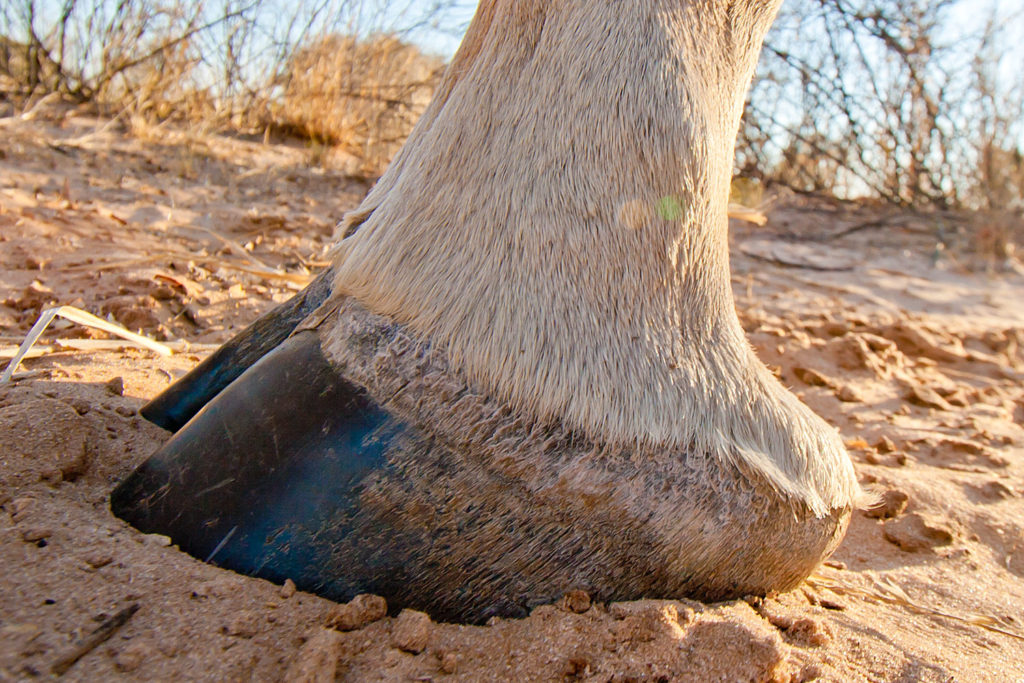 within organs
within organs 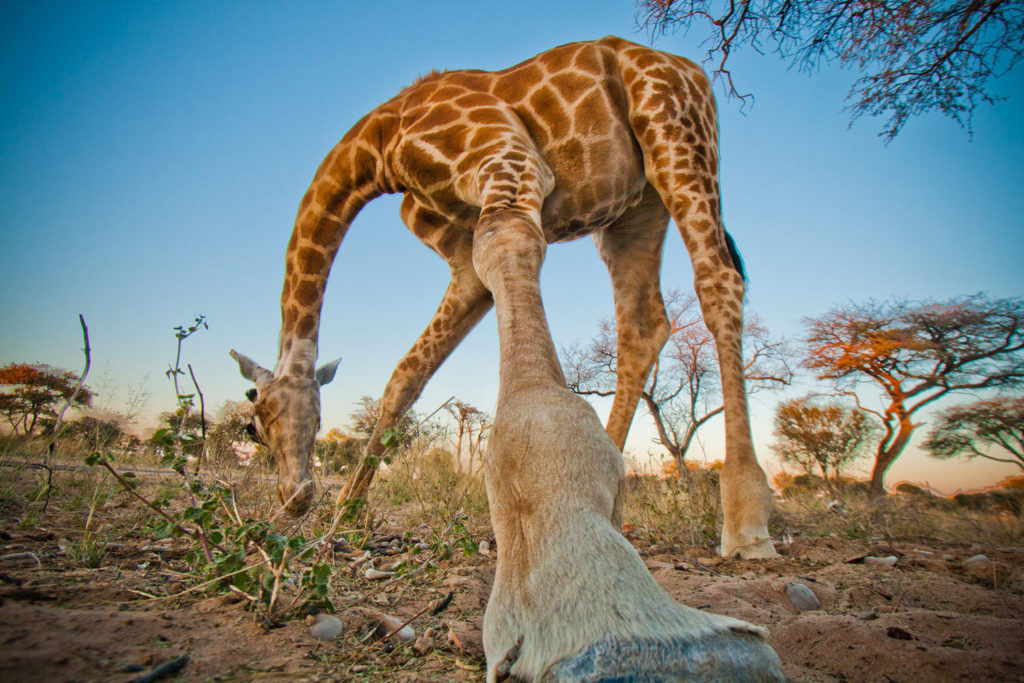 within bodies.
within bodies. 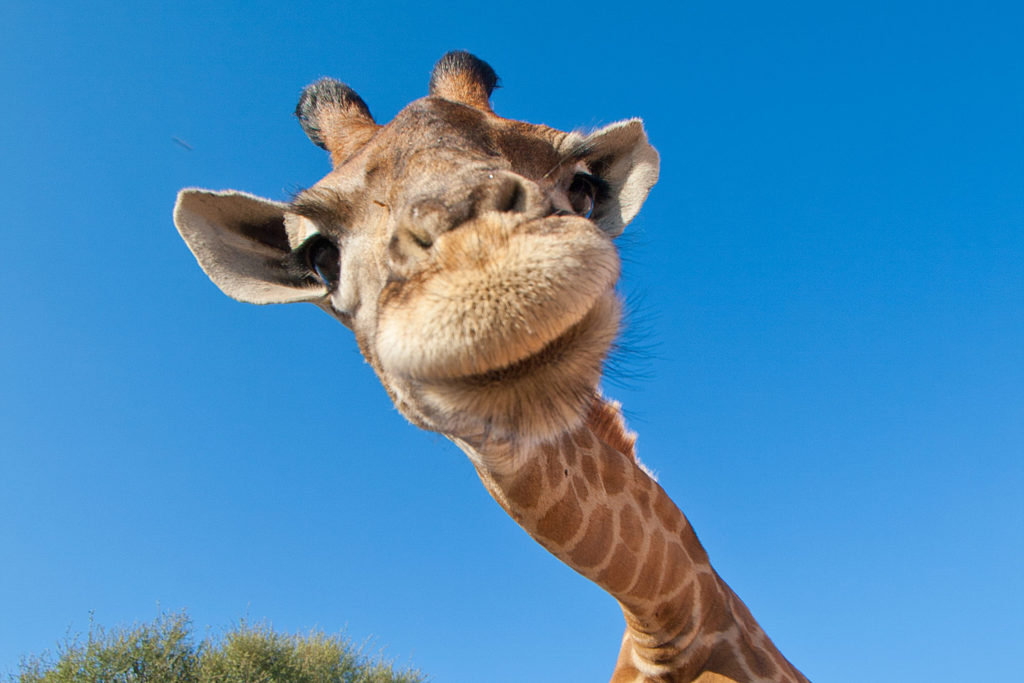 Trillions upon trillions of atoms working together in perfect harmony, to create a single entity that can get up and walk and swim and fly and, if all goes well,
Trillions upon trillions of atoms working together in perfect harmony, to create a single entity that can get up and walk and swim and fly and, if all goes well, 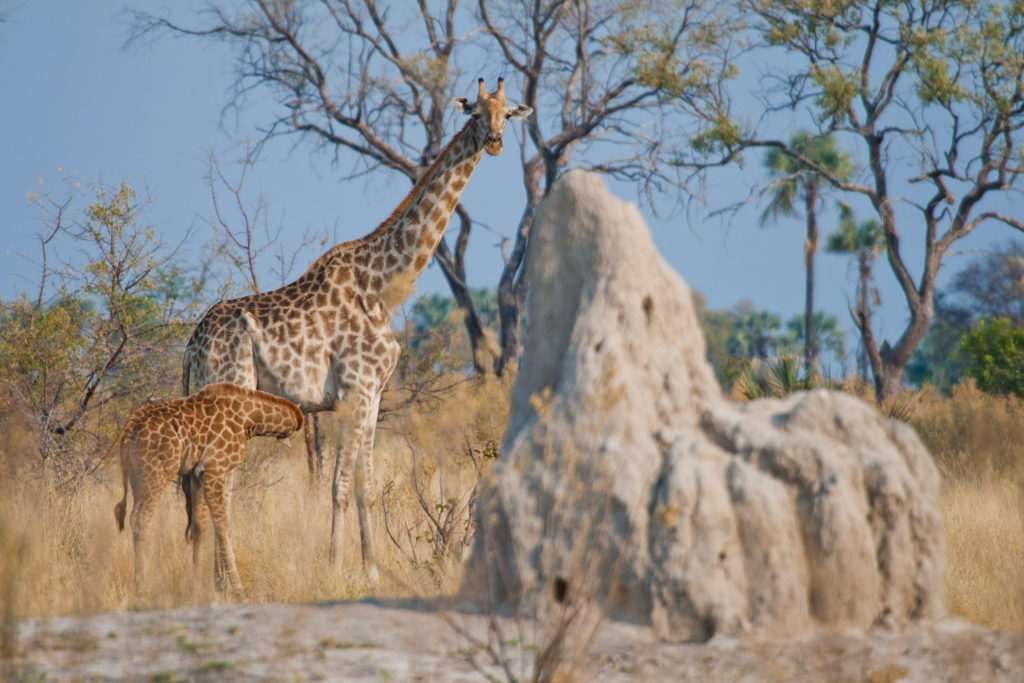 mate and start the whole process all over again. And they do this in endlessly fascinating and beautiful ways. It’s been happening for billions of years and will hopefully happen for billions more.
mate and start the whole process all over again. And they do this in endlessly fascinating and beautiful ways. It’s been happening for billions of years and will hopefully happen for billions more.
Even more amazing still is that every single living thing,
every kangaroo 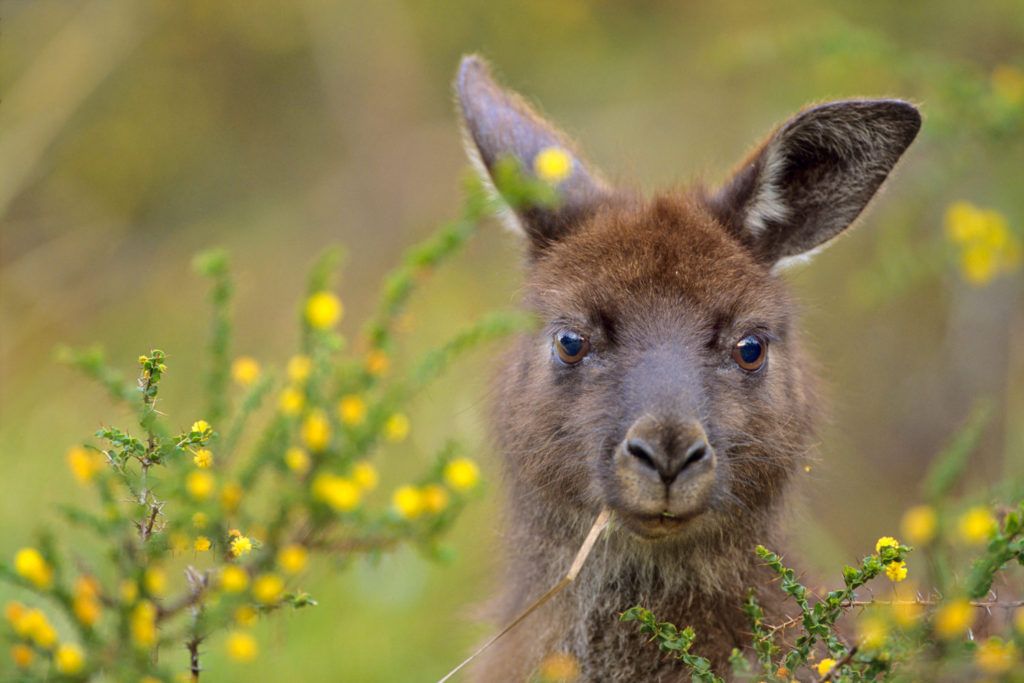 and every cactus,
and every cactus, 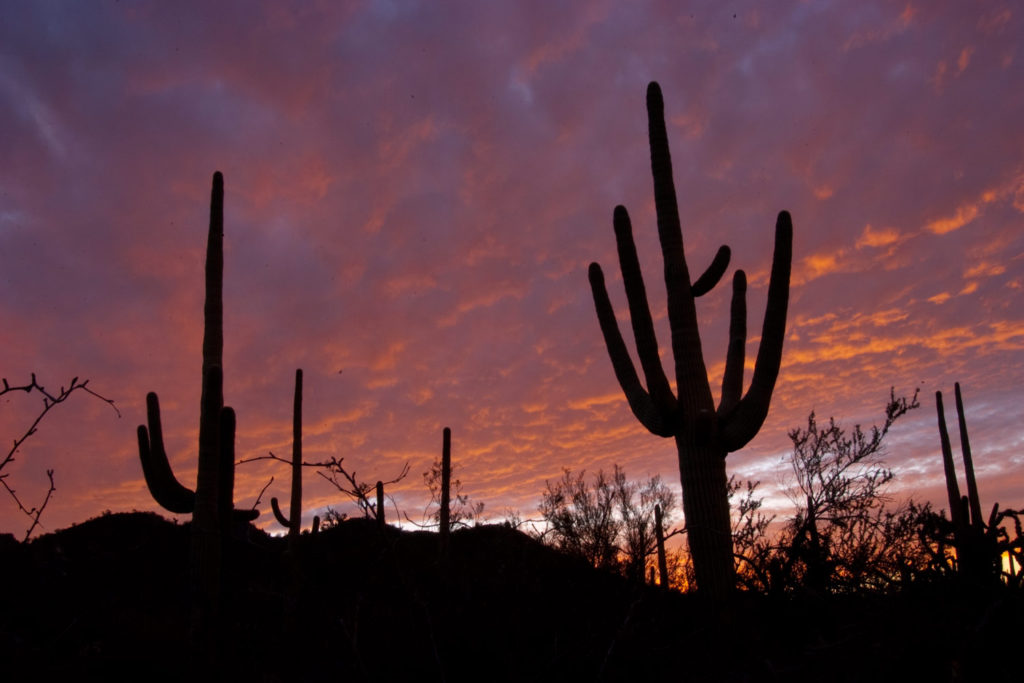 every walrus
every walrus 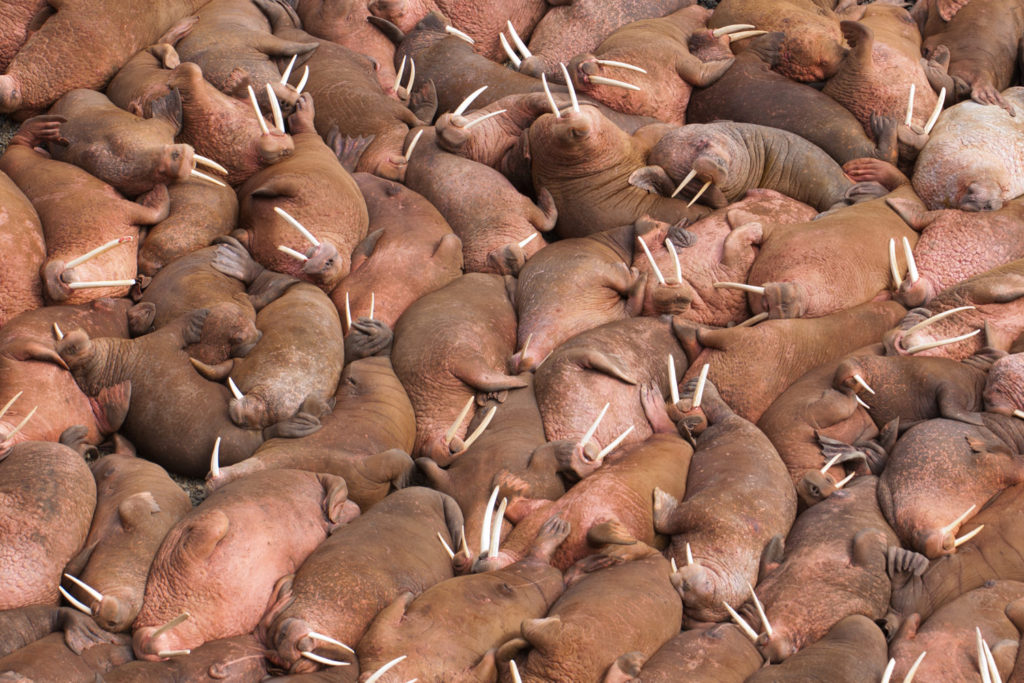 and every baobab tree,
and every baobab tree,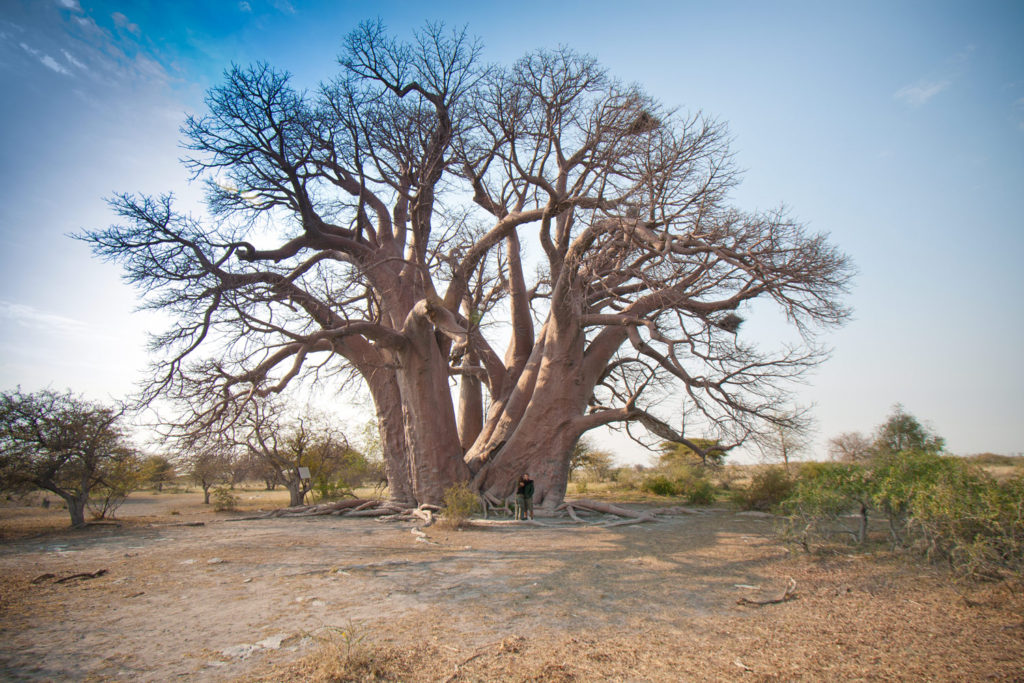 every flower and every frog,
every flower and every frog, 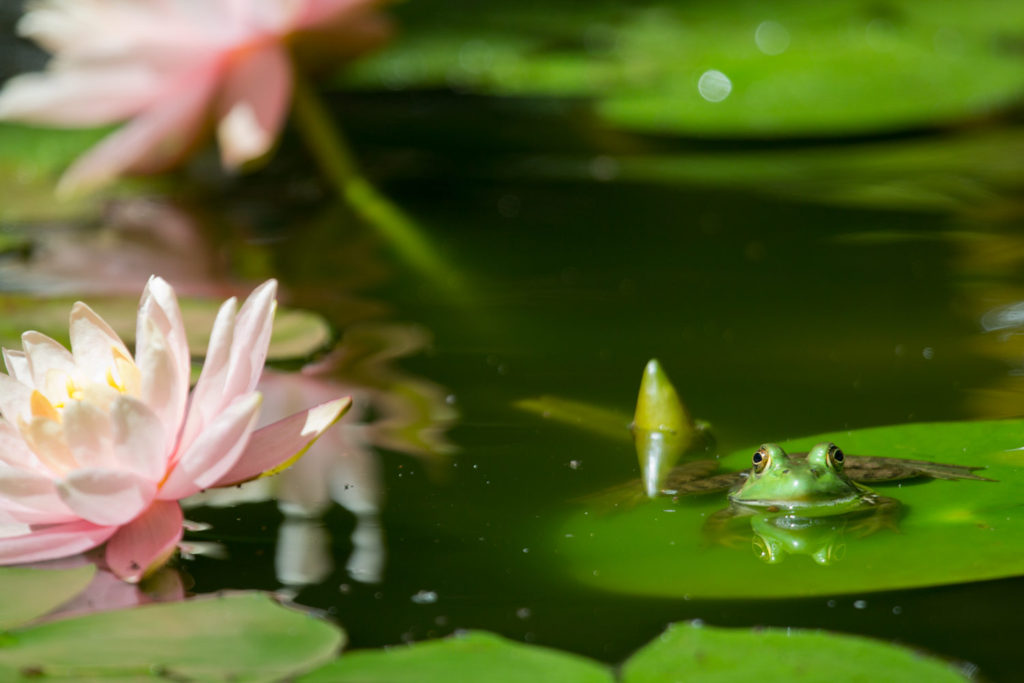 every fish and every whale,
every fish and every whale, 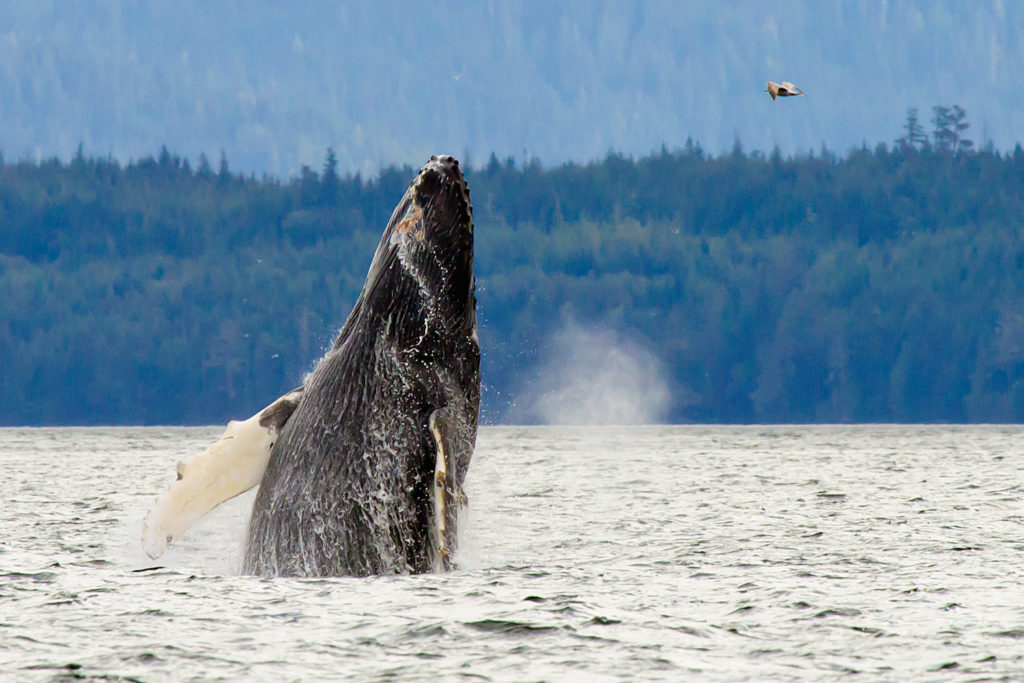 every dinosaur and every microscopic bacteria that has ever existed,
every dinosaur and every microscopic bacteria that has ever existed, 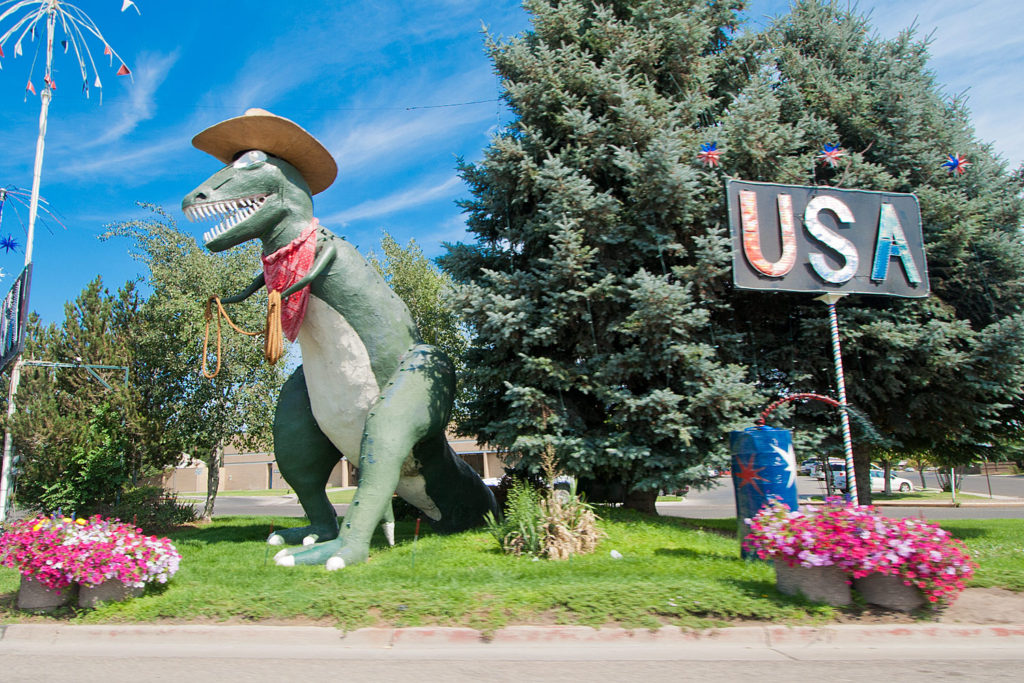 and of course every human being,
and of course every human being,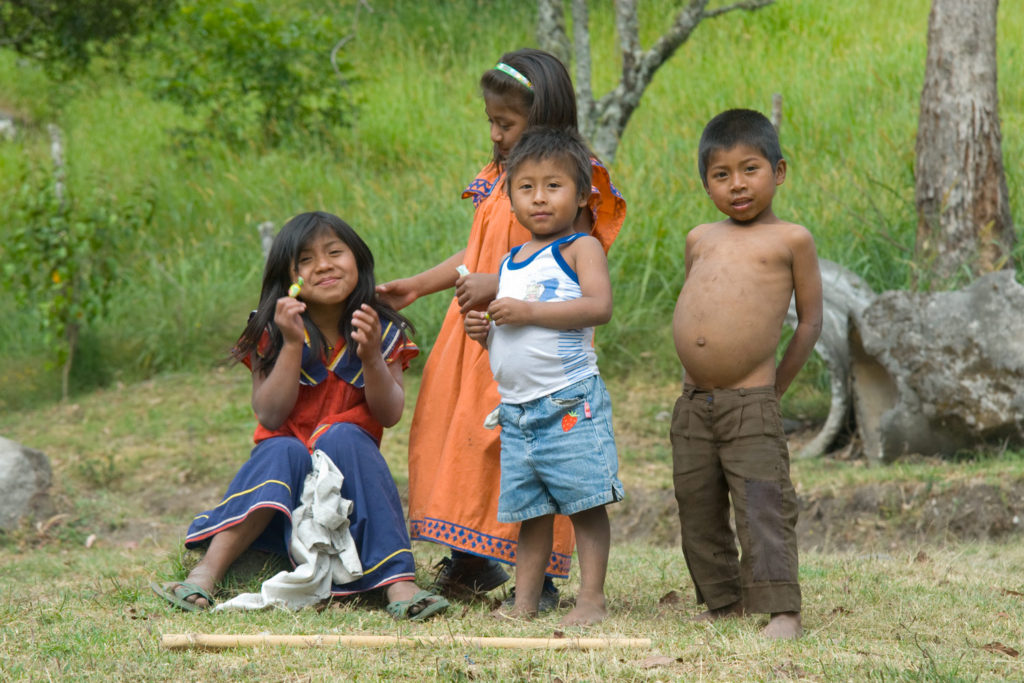 is related.
is related.
We are all, quite literally, one family.
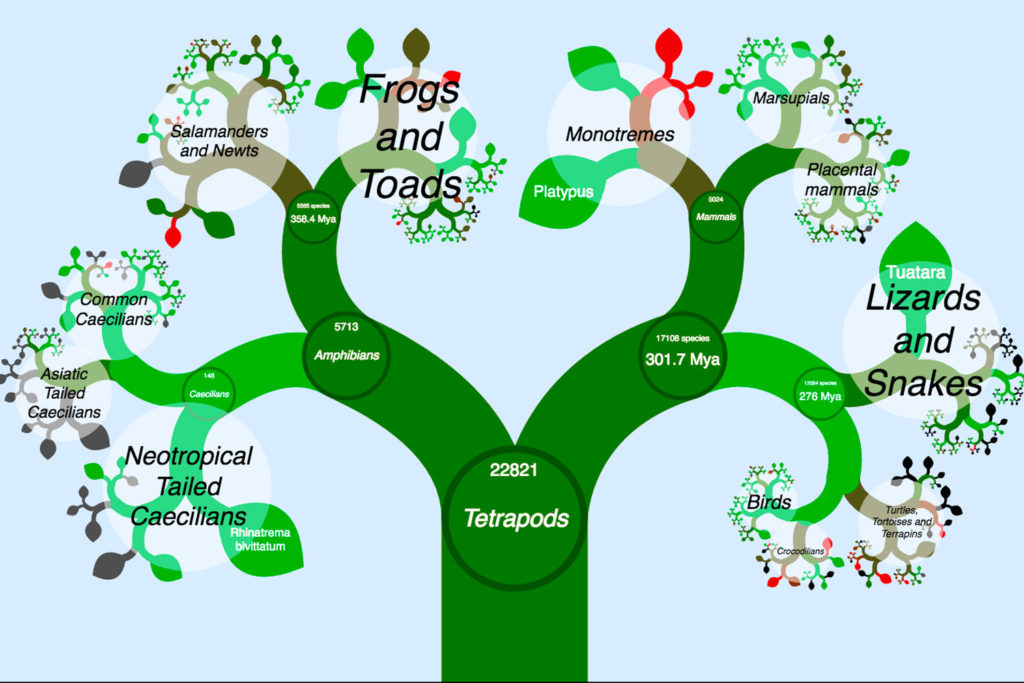
This single family stretches back through time to a common ancestor and forever moves forward, branching into endless forms, each one more incredible than the last. 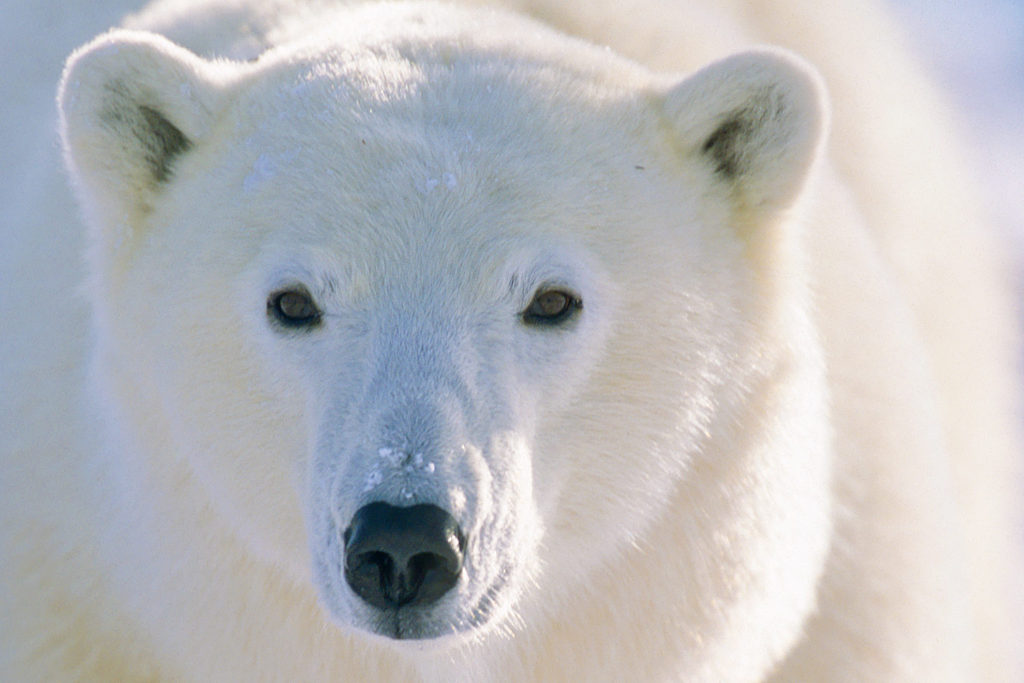 This is a proven fact, thanks to our now-extensive understanding of DNA, the blueprints of life. Yet, strangely, as many as 50% of the people living in the United States today, still deny the fact of evolution. These people are generally devout Christians who are pressured into taking the stories of the bible literally and believe that they would be denying their faith by accepting this basic truth.
This is a proven fact, thanks to our now-extensive understanding of DNA, the blueprints of life. Yet, strangely, as many as 50% of the people living in the United States today, still deny the fact of evolution. These people are generally devout Christians who are pressured into taking the stories of the bible literally and believe that they would be denying their faith by accepting this basic truth.
But I say the story of life is the greatest story ever told. And I believe that everyone can embrace this awe-inspiring truth alongside his or her own faith.
And I’ll say again that I think life is the most amazing thing that has ever happened in the Universe.
That’s why I care, and that’s why I’m here talking about this today. Because I think life is worth keeping around.
So what do we mean by conservation and biodiversity?
Next we’ll go over a few quick definitions. Biodiversity refers to having a wide array of species present in an ecosystem. 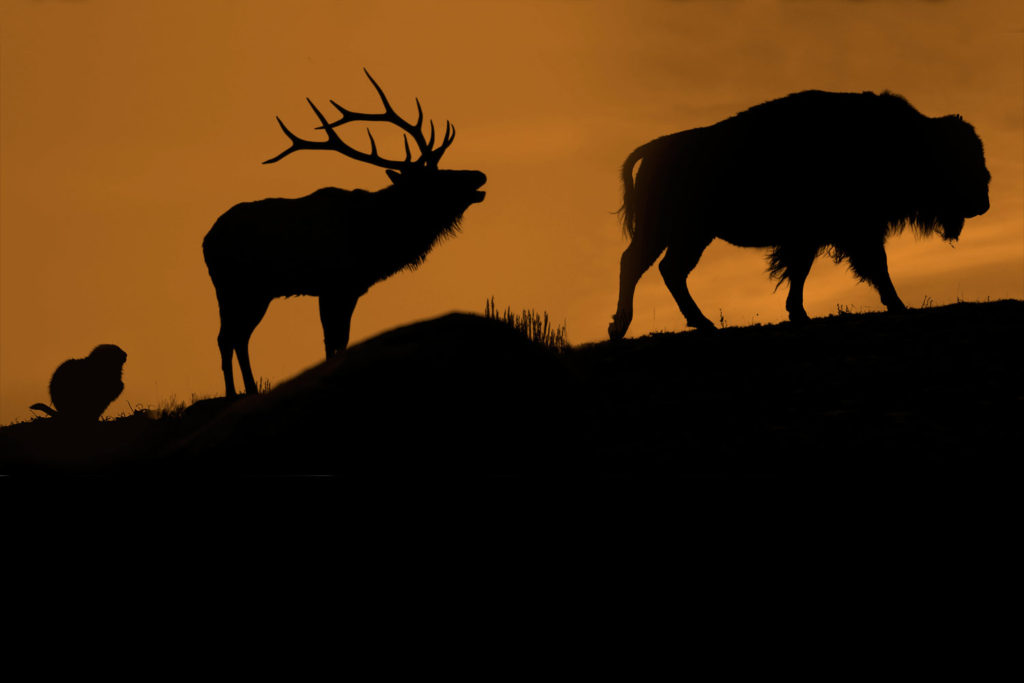 It’s the idea that every species matters and plays a role within that system, and that a diverse system is a healthy system.
It’s the idea that every species matters and plays a role within that system, and that a diverse system is a healthy system. 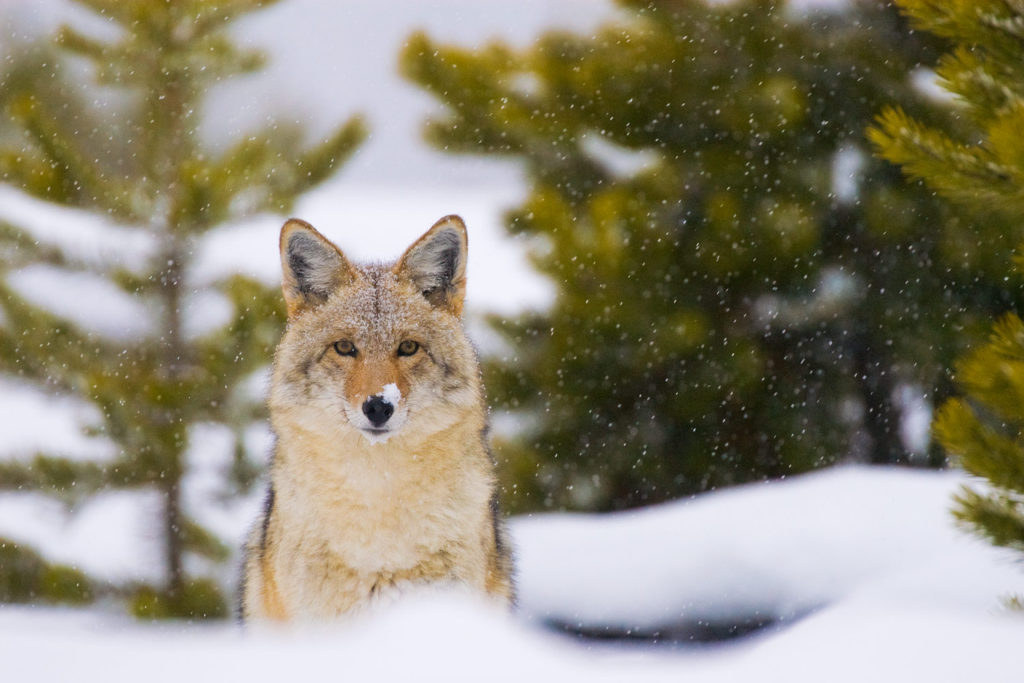 The world right now is a very diverse place with an estimated eight million different species running around.
The world right now is a very diverse place with an estimated eight million different species running around. 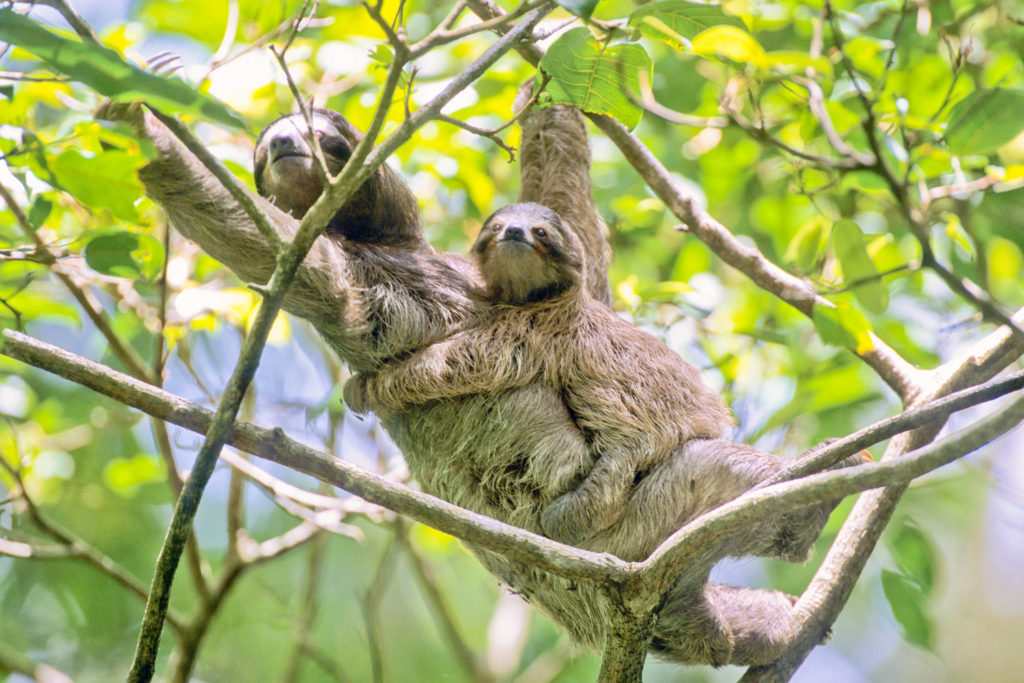 There doesn’t seem to be any fear that we will extinguish all of life in its entirety, but it’s certainly possible that we could end up in a world where our dominant wildlife is rats and cockroaches, and the only plants we see are the grass in our lawns and genetically modified corn. This isn’t really the kind of world we want to live in.
There doesn’t seem to be any fear that we will extinguish all of life in its entirety, but it’s certainly possible that we could end up in a world where our dominant wildlife is rats and cockroaches, and the only plants we see are the grass in our lawns and genetically modified corn. This isn’t really the kind of world we want to live in.
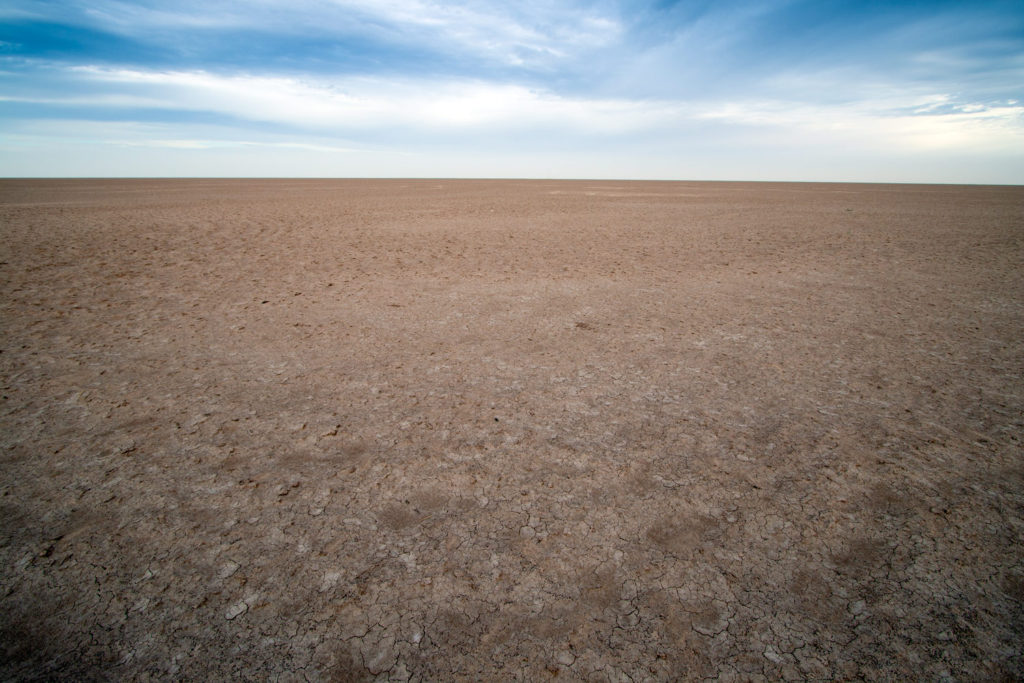
Biodiversity is not only far more interesting and beautiful, it also allows ecosystems to flourish and therefore sustain us.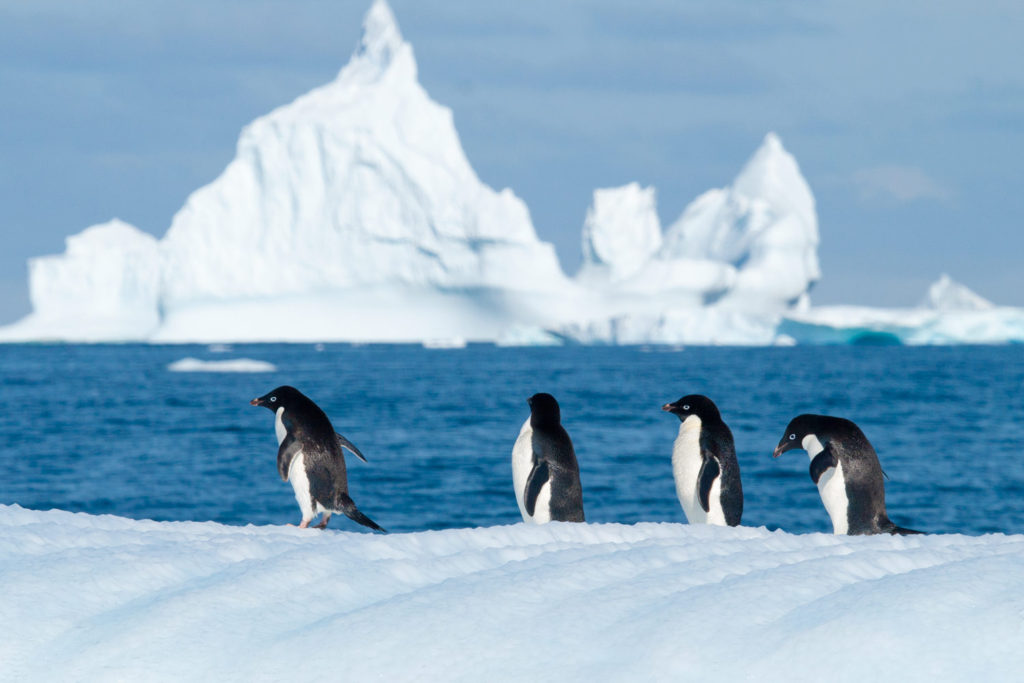
Now conservation on the other hand, is a human problem.
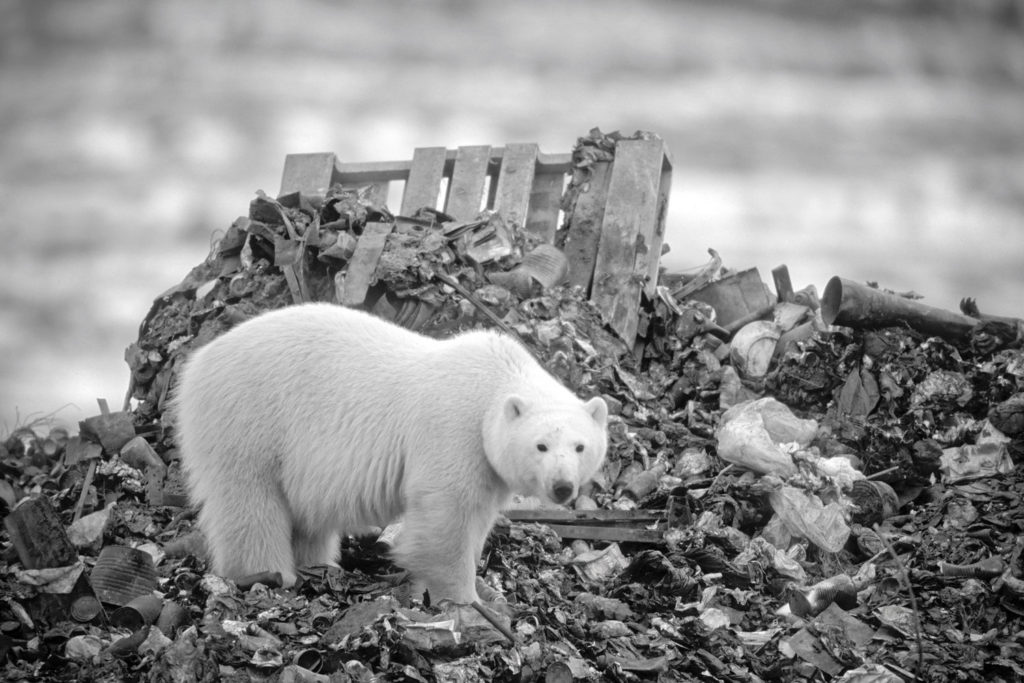 I don’t mean that humans are the only ones that can save Earth’s biodiversity.
I don’t mean that humans are the only ones that can save Earth’s biodiversity. 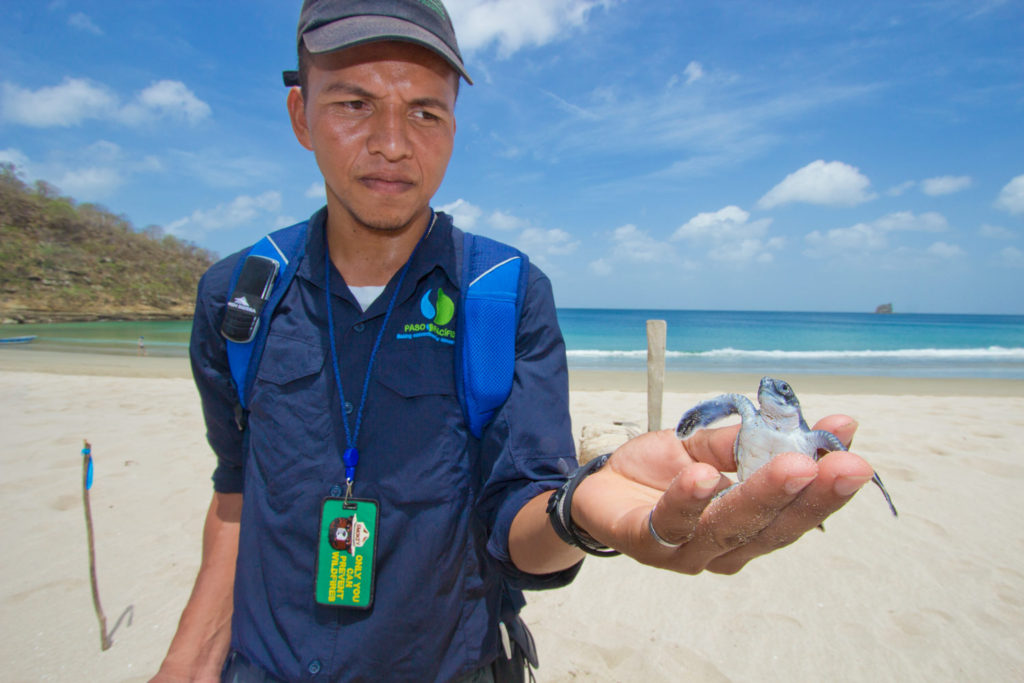 If humans disappeared today, the other eight million species of living things would do just fine.
If humans disappeared today, the other eight million species of living things would do just fine.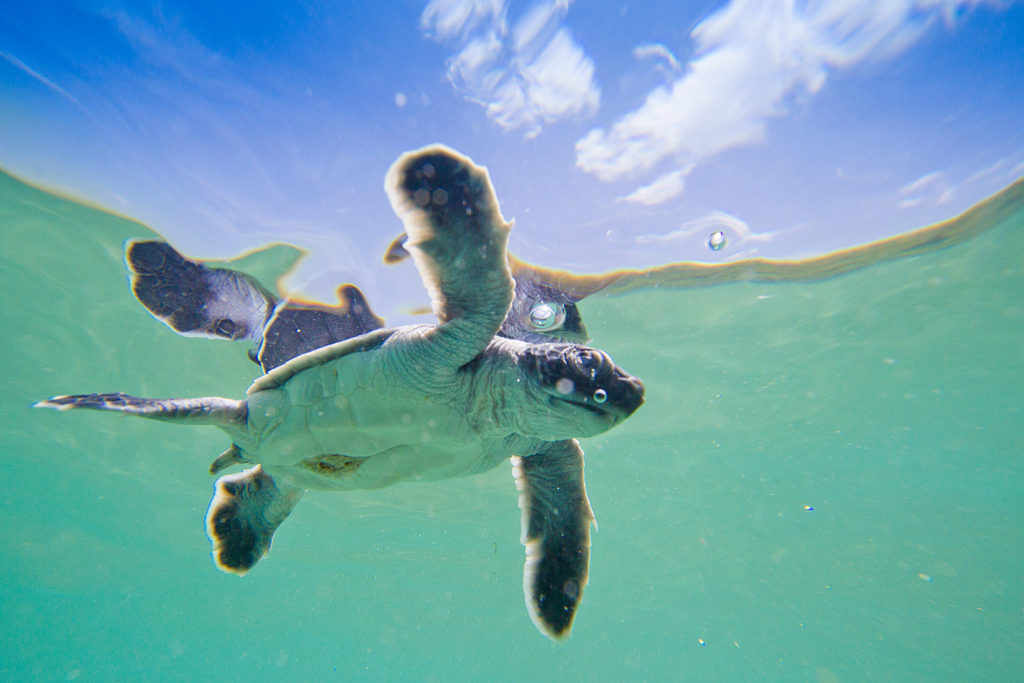 What I mean is that, generally speaking, we humans are the problem.
What I mean is that, generally speaking, we humans are the problem.
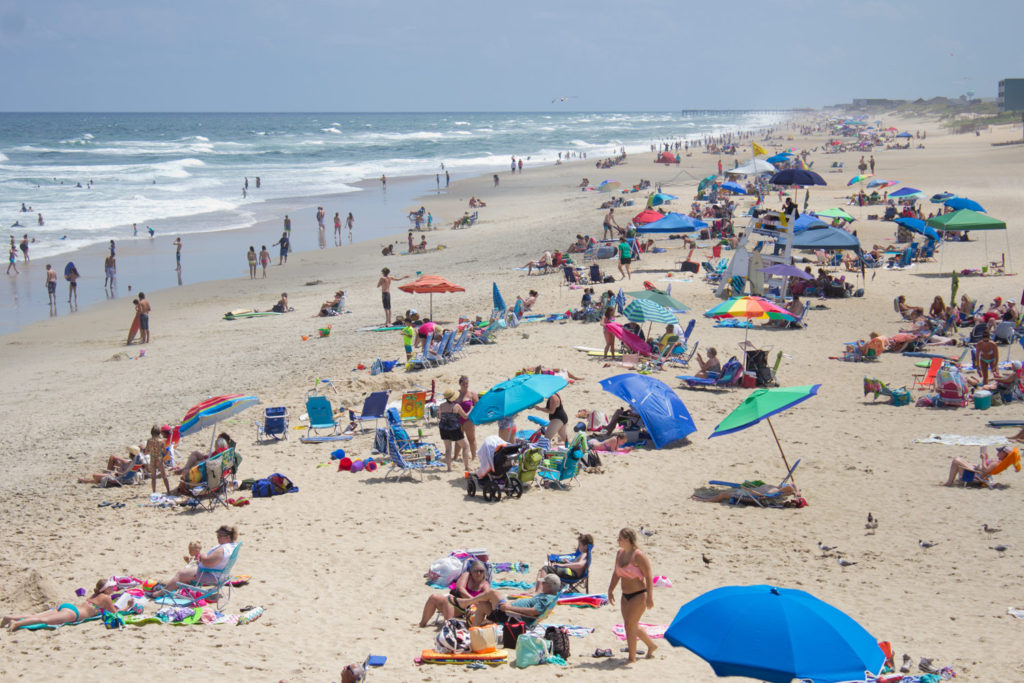 When we talk about conserving Earth’s biodiversity, what we’re really talking about is managing humans. We’re talking about managing our beliefs and our behaviors so that the rest of life on Earth can carry on with its business unhindered.
When we talk about conserving Earth’s biodiversity, what we’re really talking about is managing humans. We’re talking about managing our beliefs and our behaviors so that the rest of life on Earth can carry on with its business unhindered.
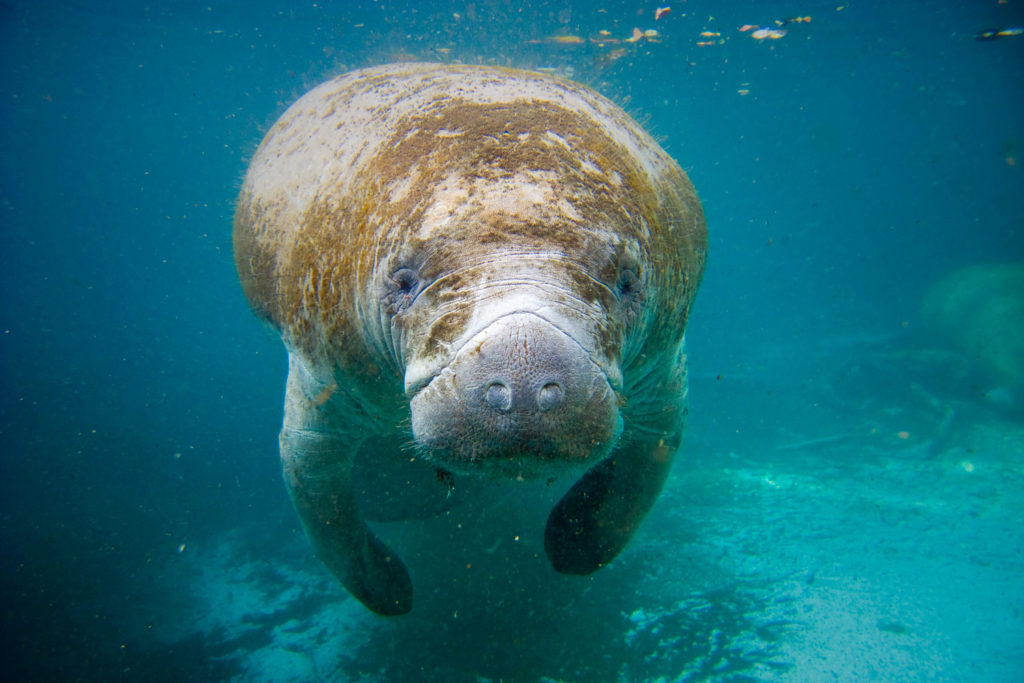 In my opinion, conservation should not necessarily mean trying to “conserve” what is already here or even trying to return things to a state they were in before humans started messing things up. This is still a very human-centric way of thinking about conservation because it requires us to manage species and ecosystems into our view of how they are “supposed to be”.
In my opinion, conservation should not necessarily mean trying to “conserve” what is already here or even trying to return things to a state they were in before humans started messing things up. This is still a very human-centric way of thinking about conservation because it requires us to manage species and ecosystems into our view of how they are “supposed to be”. 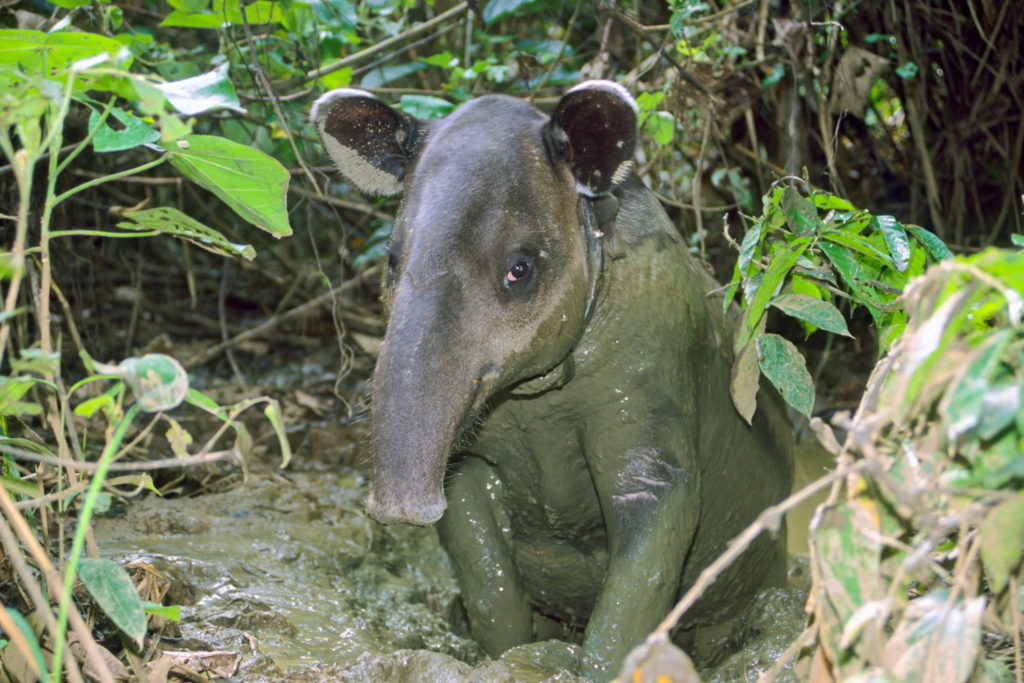 Nature is not static. It is always changing. Ecosystems and species change over time. I believe what conservation should aim to do is to allow nature to be self-willed again.
Nature is not static. It is always changing. Ecosystems and species change over time. I believe what conservation should aim to do is to allow nature to be self-willed again.
Yes, we should work hard to undo some of the damage we’ve done. Yes, we should work hard to save species that we have pushed to the brink of extinction.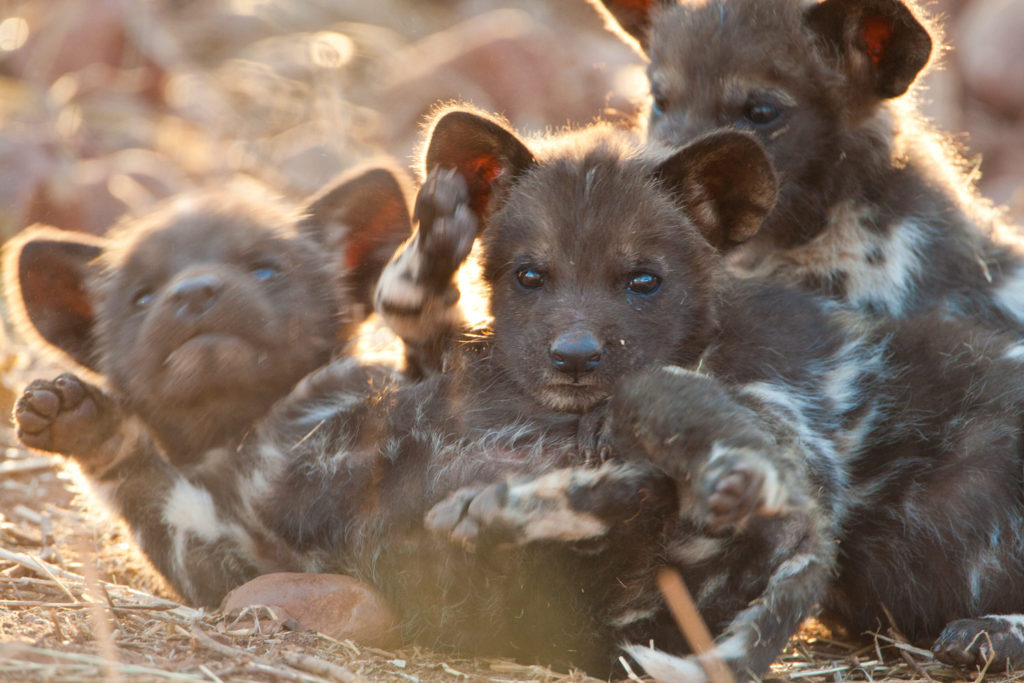
Yes, we should do everything we can to re-wild the habitats that we have strangled. 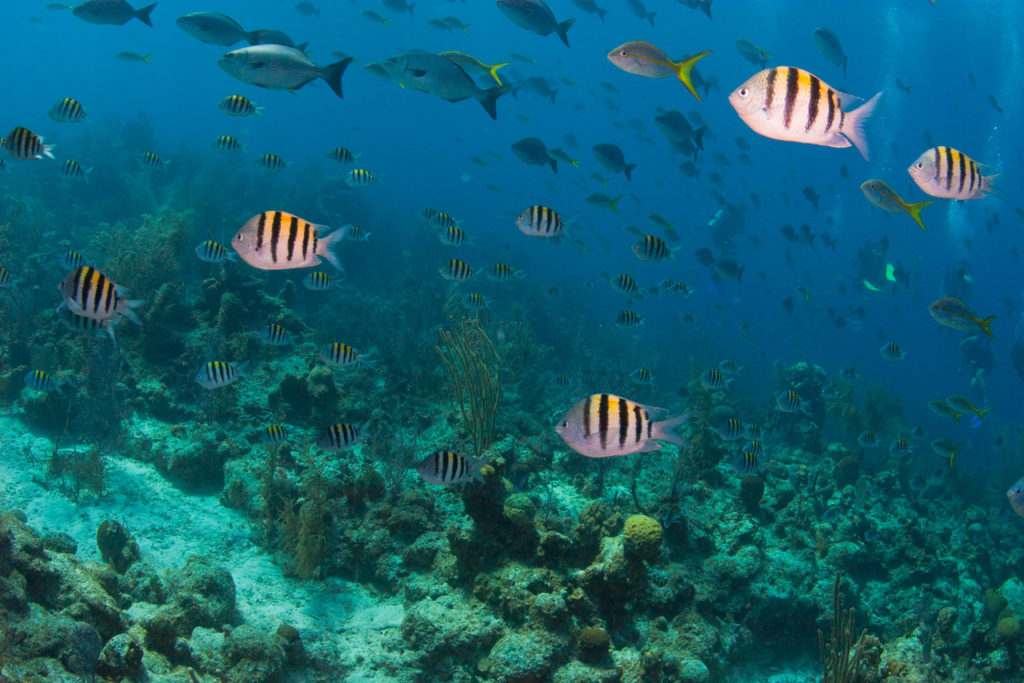 This type of conservation is treating the symptoms and it is absolutely necessary. But we also have to work hard at treating the disease itself, the root cause of these problems; our core beliefs and values that led to this mess in the first place.
This type of conservation is treating the symptoms and it is absolutely necessary. But we also have to work hard at treating the disease itself, the root cause of these problems; our core beliefs and values that led to this mess in the first place.
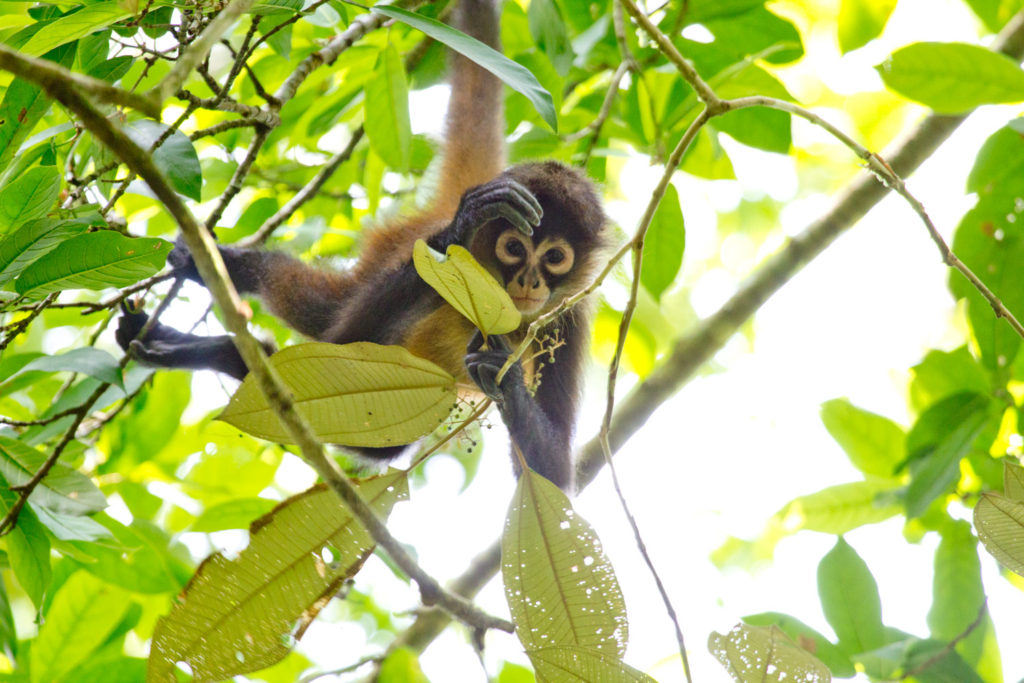 We know that humans are directly responsible for the extinction of hundreds of species and more likely thousands upon thousands of species.
We know that humans are directly responsible for the extinction of hundreds of species and more likely thousands upon thousands of species.
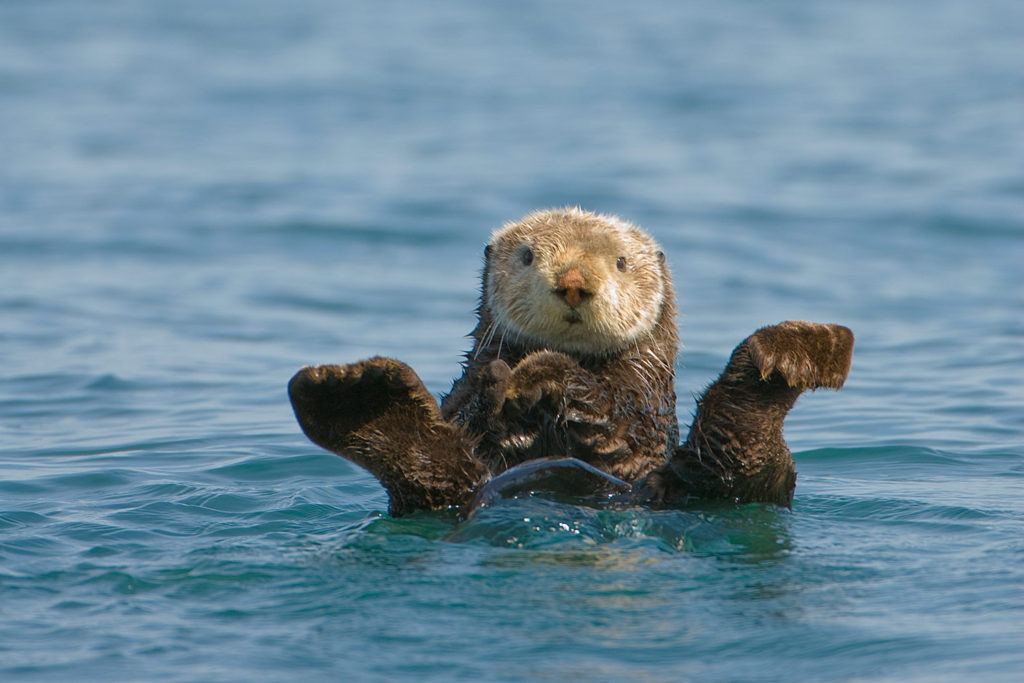
And yet, most of us don’t wake up in the morning and think to ourselves, “I hate animals and plants and I’m going to make sure I do something today that will directly lead to their mass extinction.”
So how does this happen?
I believe there are two basic reasons:
- We don’t know the consequences of our actions, or, if we do know…
- We don’t care enough to change them.
I’m here to talk about how two simple little things like photos and words can help address these fundamental problems in conservation by changing what we care about and therefore changing our behaviors.
Where do we get our ideas and values?
First we have to figure out where we get our ideas. In the old days we got our ideas and information from direct observation and we learned them from family and friends. 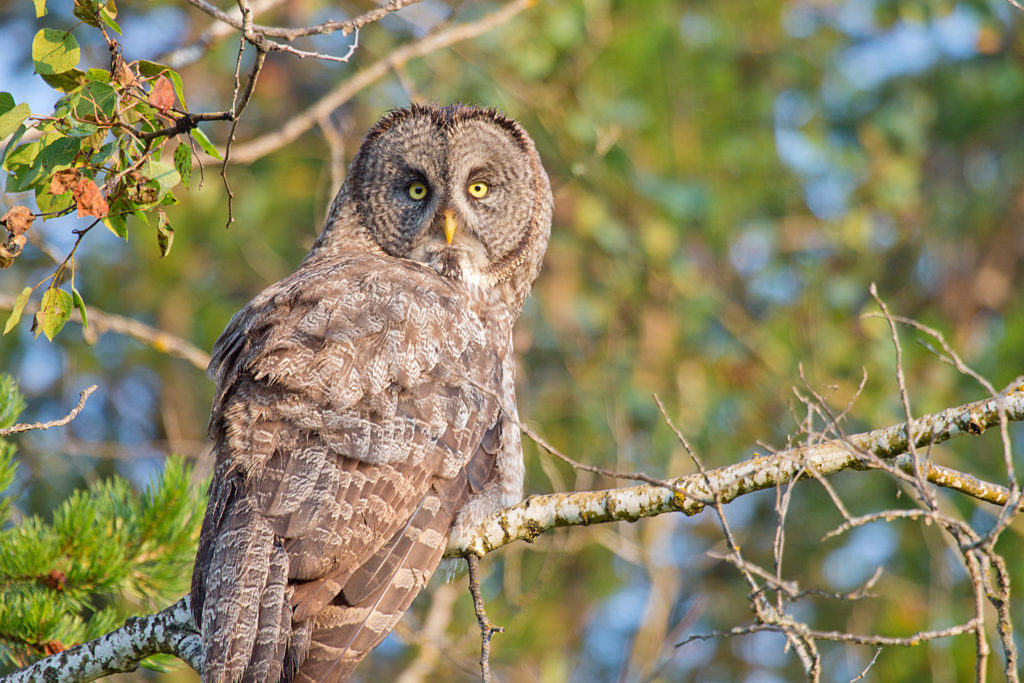 Generally we absorbed our value system from the people in our immediate community.
Generally we absorbed our value system from the people in our immediate community.
Then along came the book. Suddenly people could absorb ideas and values from someone who was physically removed from them. Suddenly a single person could influence the thoughts and beliefs of thousands of other people without ever meeting them. That’s when mass media was born.
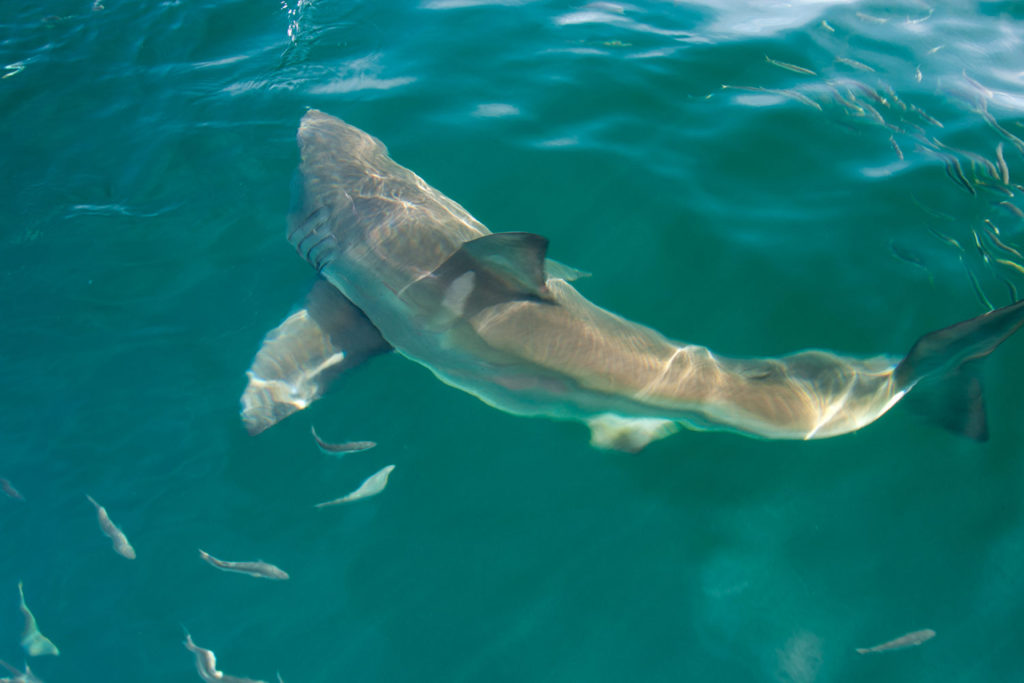 Soon came newspapers and magazines, recorded music, radio, movies, and television. We were being bombarded with ideas and information from around the globe. With the rise of leisure came the rise of entertainment. And while we were being entertained our ideas were constantly re-forming. Amid the barrage of advertisements our values were being shaped.
Soon came newspapers and magazines, recorded music, radio, movies, and television. We were being bombarded with ideas and information from around the globe. With the rise of leisure came the rise of entertainment. And while we were being entertained our ideas were constantly re-forming. Amid the barrage of advertisements our values were being shaped.
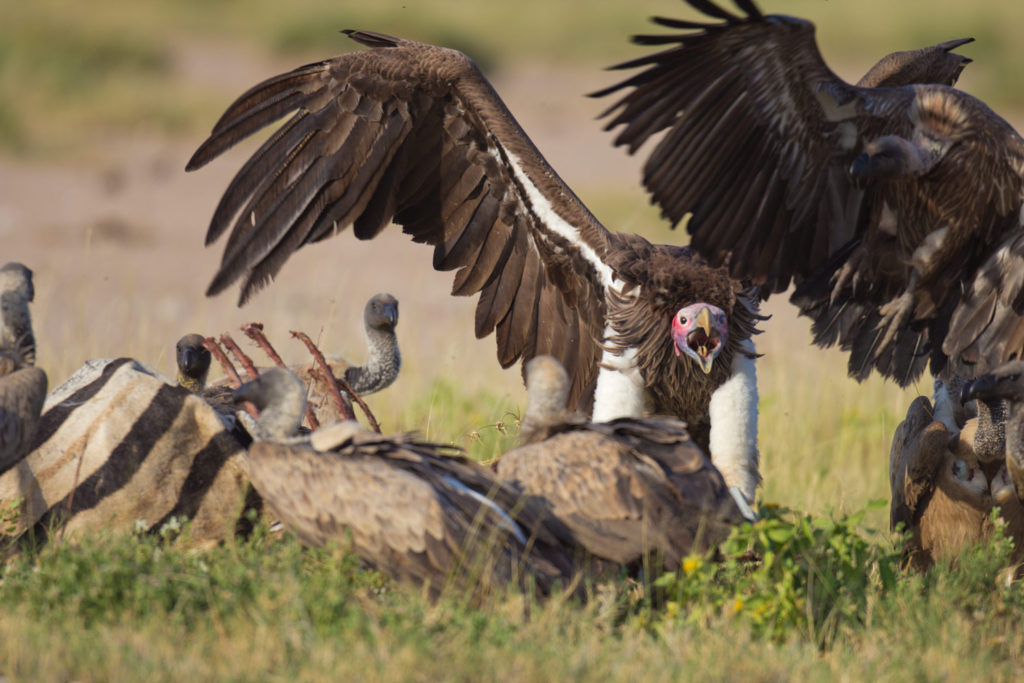 And then, a mere 20 years ago, everything changed again and the digital era was upon us. Now we can barely tear our eyes away from our little screens. Our laptops, our phones, our tablets. Now we get our information online. Now ideas spread like a virus. Now the common person can put their opinion online and influence millions if their content goes viral.
And then, a mere 20 years ago, everything changed again and the digital era was upon us. Now we can barely tear our eyes away from our little screens. Our laptops, our phones, our tablets. Now we get our information online. Now ideas spread like a virus. Now the common person can put their opinion online and influence millions if their content goes viral.
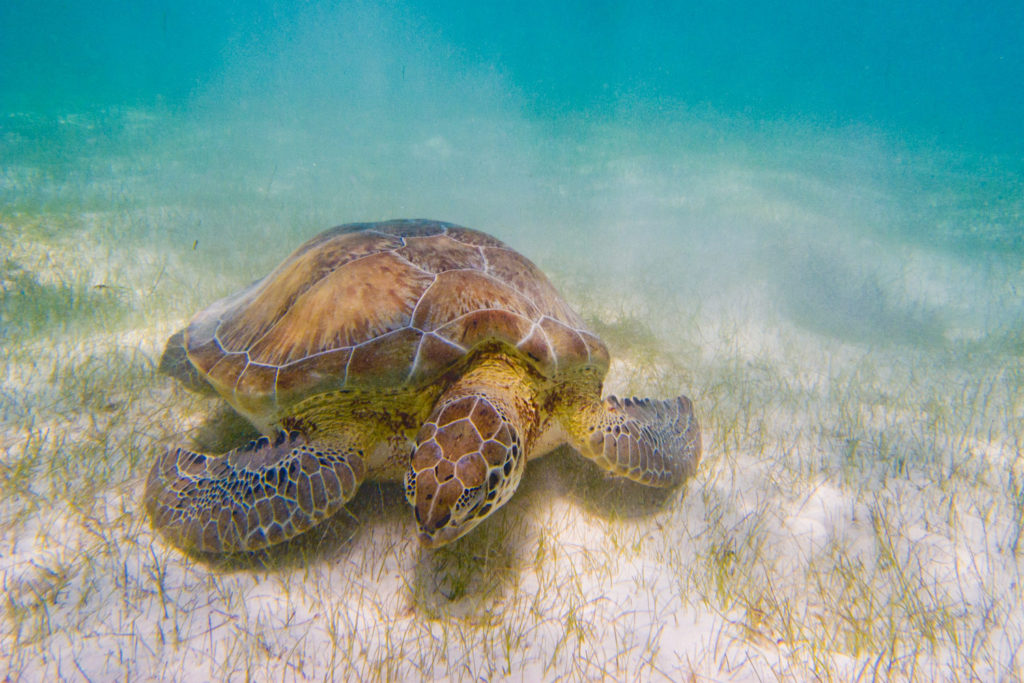 Today, if you want to reach people, your information has to be digital and accessible to the masses.
Today, if you want to reach people, your information has to be digital and accessible to the masses.
When I have a question about something I type it into Google and see what pops up. What pops up is a list of websites, photos, and videos.
For example, when I found out I was coming to Russia to see the reintroduction of the Przewalski’s Horse into the Orenburg Reserves, I did a google search for wild horse and Russia. What I got, obviously, was a photo of the president of Russia riding shirtless on a horse. Then of course I had to google “Putin shirtless” and found a hundred more fake photos of him riding bare-chested on a bear, on an eagle, on a great white shark, on a tiger, on a rocket, on a kitten, on a meteoroid, and on an astronaut. Then I completely forgot what I was searching for. But eventually I got back on target and I found a website that had a story about the Przewalski’s Horse in Russia.
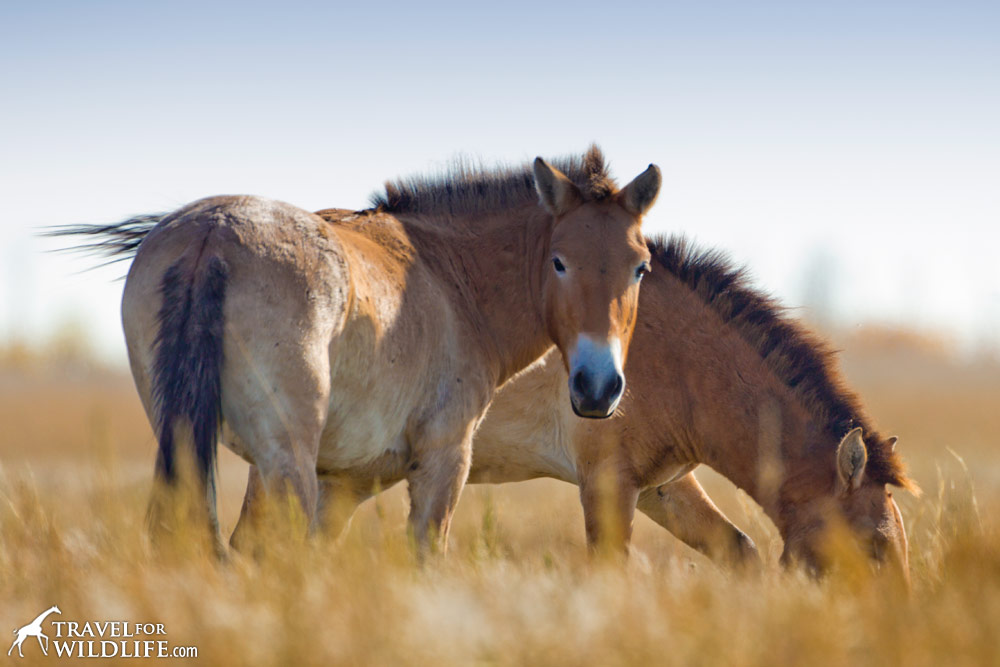 This is where our ideas and information come from today and this is how we find it.
This is where our ideas and information come from today and this is how we find it.
What the heck is blogging?
First of all, let me say I hate the word blog. It makes my skin crawl. It is a contraction of “web log” meaning a log or journal posted on the web. So a blog is a website. And that’s what I’d rather call it. But since I’ve been asked to give a lecture about photography and blogging we’ll call it a blog for now.
Blogging is big. To get a sense of how big, think about the population of Russia. Imagine that every single man woman and child in the country, all 150 million of them, each had their own blog. That’s roughly how many blogs are on the internet at any one time.
There’s a website that allows you to see a real time estimate of how many blog posts have been posted on the internet so far that day. When I last looked at it, the count for that particular day was over 3 million blog posts and rising rapidly. That was at 4 o’clock in the afternoon.
The major difference between traditional journalism and a blog is that blogs tend to be created by a single person. There is no oversight by an editor or a fact checker or a legal team, like at a newspaper. Therefore a blogger can basically spew out whatever they want onto the internet and there’s nobody to stop them.
As a result, you may think that blogs would have a reputation for being unreliable or inaccurate. But in reality, studies show that most people (80 – 98% depending on the study) trust the information they read in blogs and use it to make their daily decisions.
That’s because there is one area where blogs really excel and that is in the realm of personal experience and opinion. Bloggers can talk about literally anything in the world; music, cars, food, fashion, toilets, anything you can imagine. But virtually all of them talk about their personal experiences with these subjects.
For example, when I want to learn about a travel destination, I want to read a first-hand account of someone’s experience, and I want to know her opinion of what it was like. 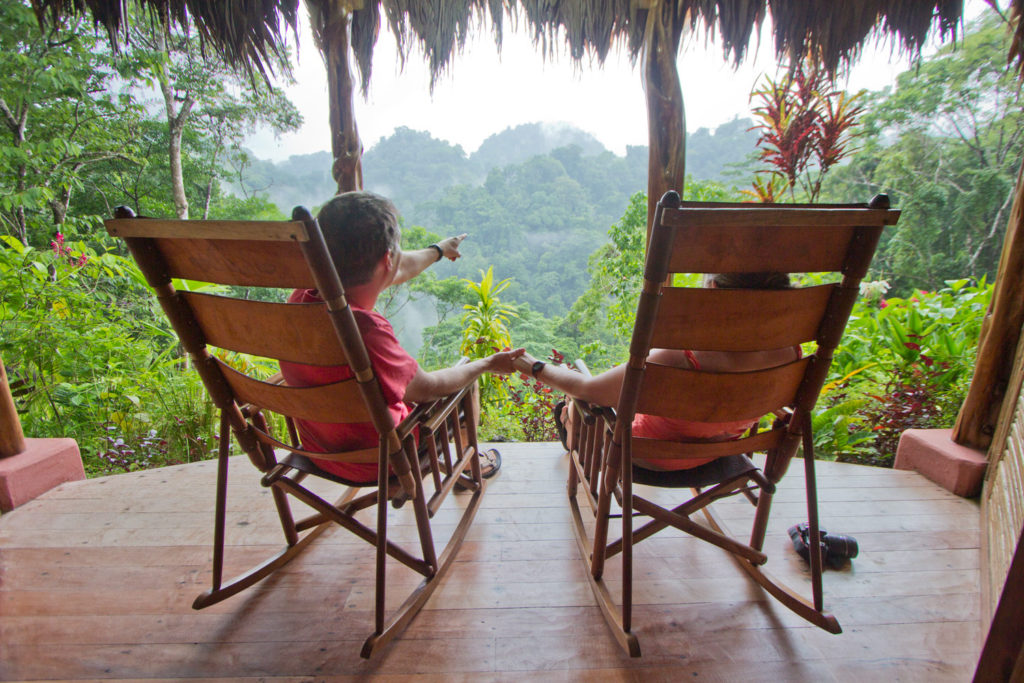 Sure I’ll read the company’s official website talking about how amazing their lodge is or how wonderful the national park is. But then I want to hear from someone who doesn’t have a vested interest. And that’s why people trust bloggers, because they seemingly provide an unbiased opinion.
Sure I’ll read the company’s official website talking about how amazing their lodge is or how wonderful the national park is. But then I want to hear from someone who doesn’t have a vested interest. And that’s why people trust bloggers, because they seemingly provide an unbiased opinion.
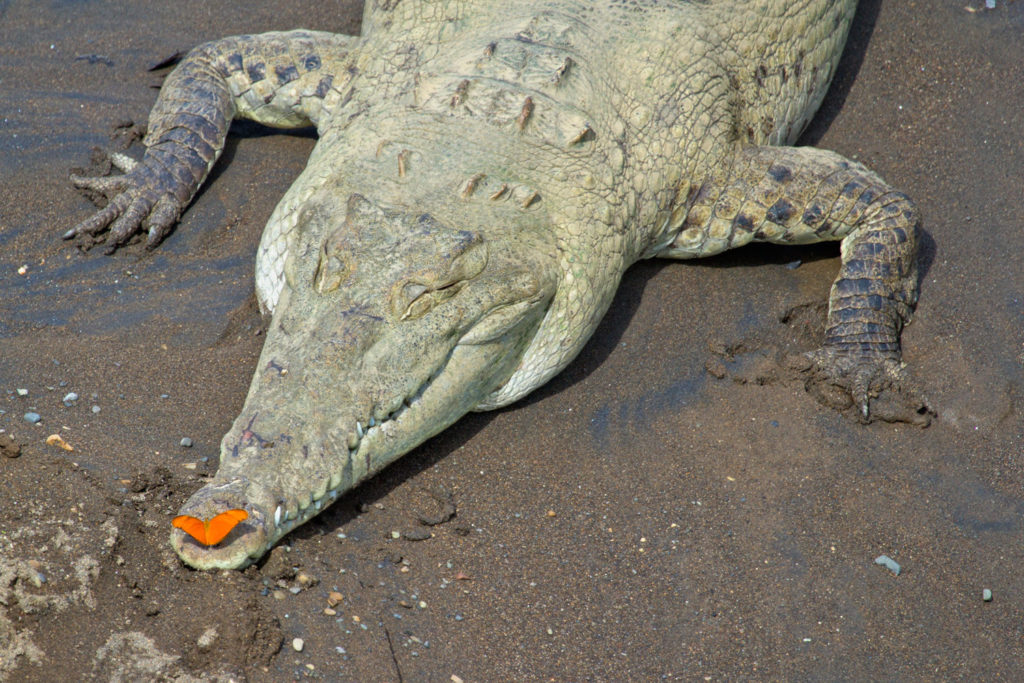 I say “seemingly” because, of course, bloggers can be biased. Many bloggers receive free travel or payment in exchange for promoting a destination. This can make them very hesitant to write negatively about the subject, especially if they hope to continue getting paid to travel.
I say “seemingly” because, of course, bloggers can be biased. Many bloggers receive free travel or payment in exchange for promoting a destination. This can make them very hesitant to write negatively about the subject, especially if they hope to continue getting paid to travel.
So there are limitations to the credibility of bloggers. Anyone who does get paid to travel will insist vehemently that everything they write is unbiased and entirely their own opinion. Including me. But this is one of the pitfalls we have to watch out for when we talk about how blogging can actually hurt conservation. We’ll get to that later.
First lets talk about some of the ways that blogging and nature photography can really help the conservation of biodiversity.
How can blogging and nature photography help conservation?
Personal Influence.
One of the most important impacts that nature photography can have upon conservation is also one of the most overlooked. The personal connection it gives us with nature and wildlife. 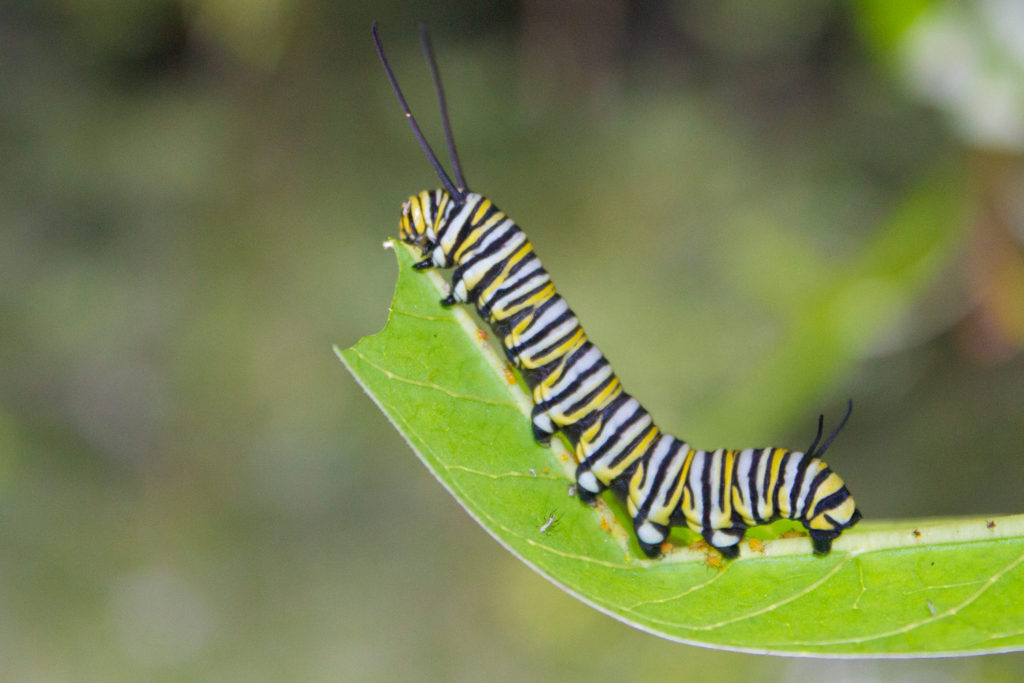 I think everybody should take up nature photography as a hobby right now. Even if nobody ever sees a single photo you take, the impact that it will have upon you personally is staggering. Number one, when you decide to take photos of living things, it forces you to get outside and away from your screen.
I think everybody should take up nature photography as a hobby right now. Even if nobody ever sees a single photo you take, the impact that it will have upon you personally is staggering. Number one, when you decide to take photos of living things, it forces you to get outside and away from your screen. 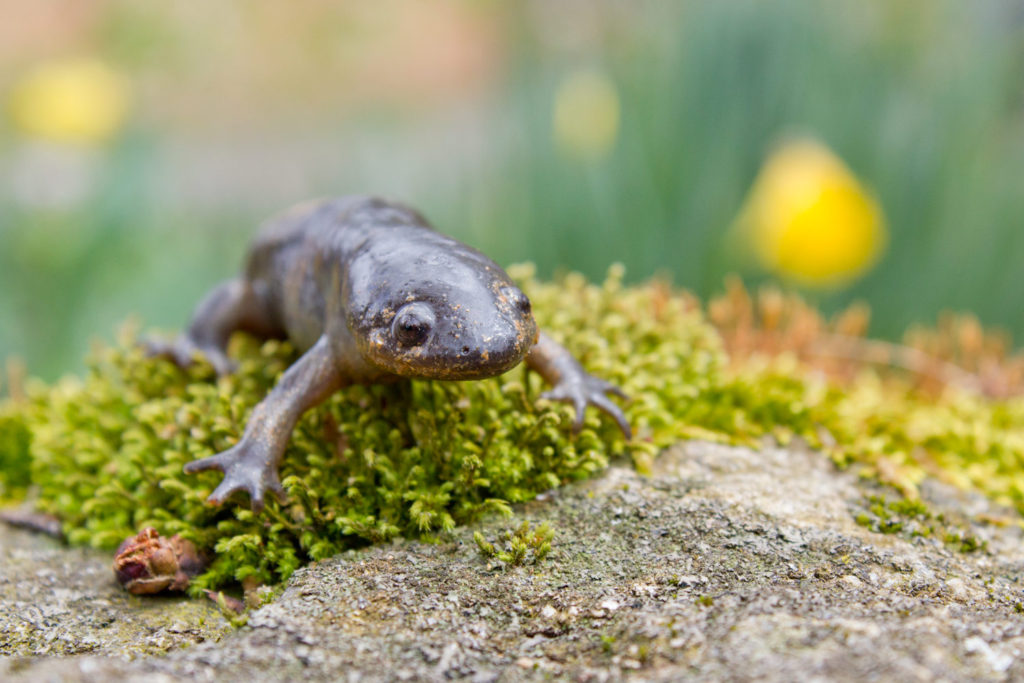 You get out into the real world. You experience your own local habitats first hand. You start to realize that life is everywhere, right in your own back yard. You reconnect with the natural world on a visceral level.
You get out into the real world. You experience your own local habitats first hand. You start to realize that life is everywhere, right in your own back yard. You reconnect with the natural world on a visceral level. 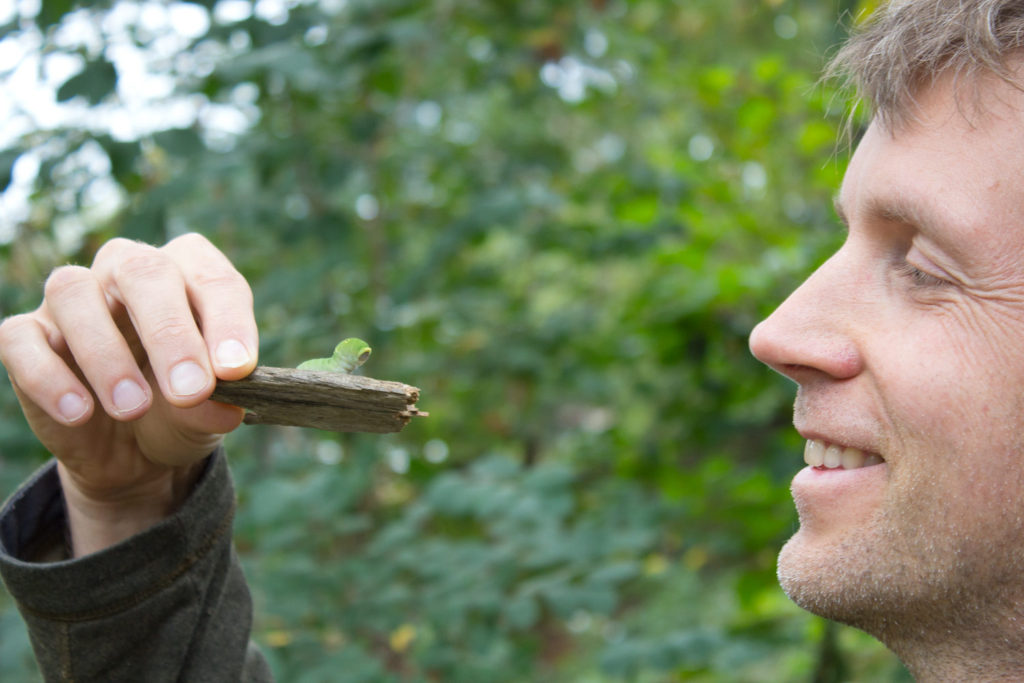 You start to remember that you are a part of nature and you are an animal just like any other. I think that this, above all other things, is the most important effect that wildlife photography can have upon conservation.
You start to remember that you are a part of nature and you are an animal just like any other. I think that this, above all other things, is the most important effect that wildlife photography can have upon conservation. 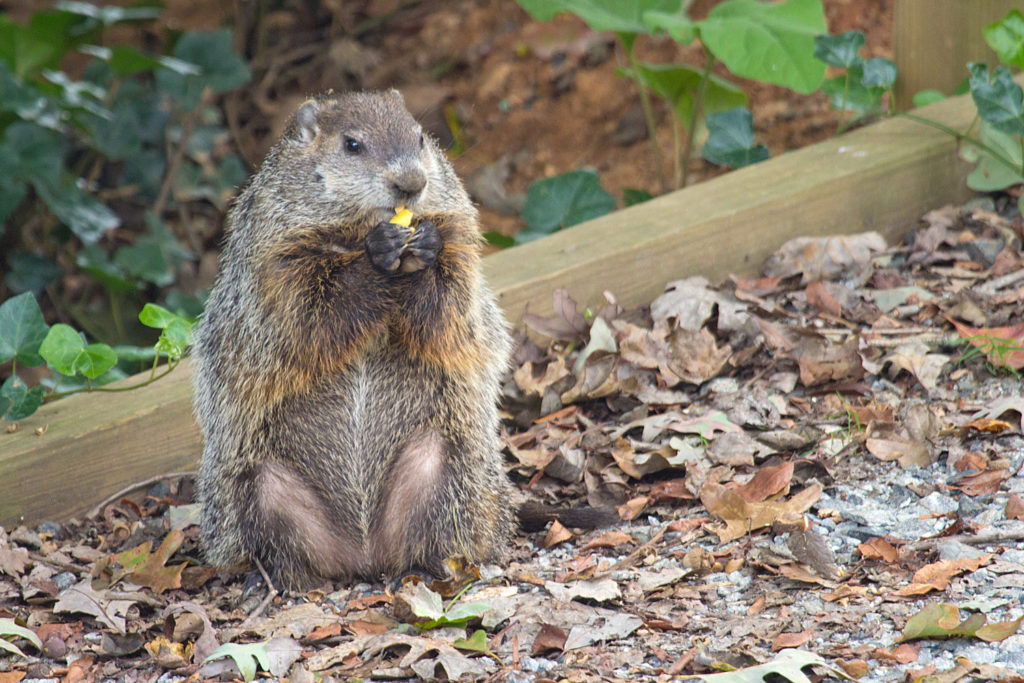 It can begin to eliminate the “Us vs. Them” attitude that modern humans seem to have toward nature and wildlife. It can take a huge step toward fixing the massive disconnect we feel with the rest of life on Earth.
It can begin to eliminate the “Us vs. Them” attitude that modern humans seem to have toward nature and wildlife. It can take a huge step toward fixing the massive disconnect we feel with the rest of life on Earth.
How does this happen? Because when you take a photo of an animal or a plant, you instinctively want to know what it is and what it’s doing. 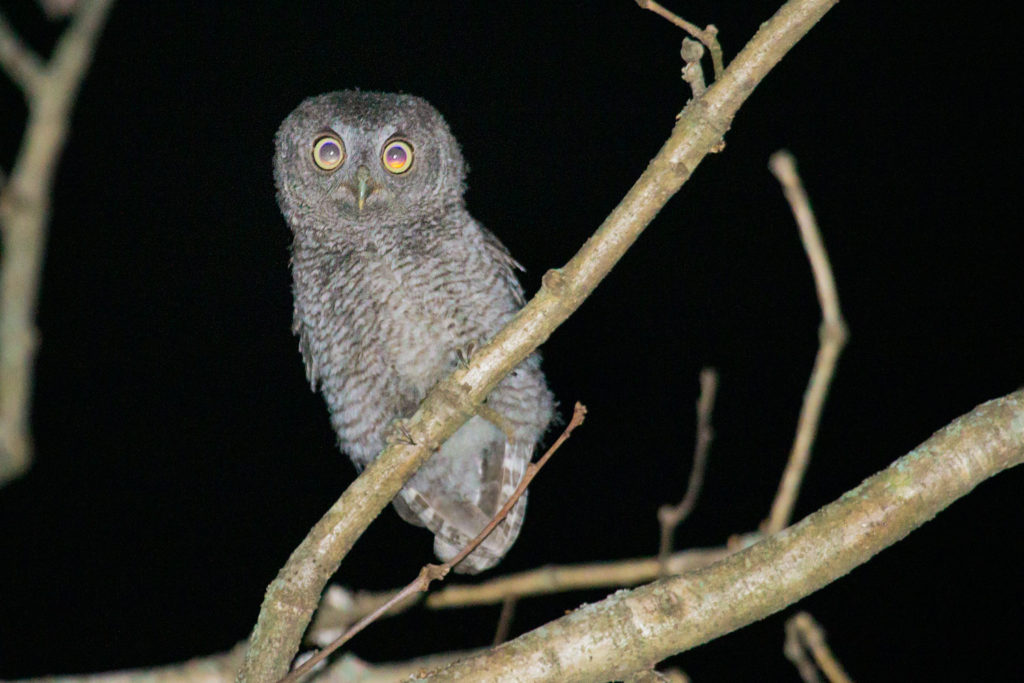 You take that photo home and you study it. You look at a field guide or you search online to figure out what it is. When you do track it down, you suddenly find yourself reading about it and learning some amazing fact. Then you’re hooked. Suddenly, you care.
You take that photo home and you study it. You look at a field guide or you search online to figure out what it is. When you do track it down, you suddenly find yourself reading about it and learning some amazing fact. Then you’re hooked. Suddenly, you care.
Once you care, you are inclined to help that animal. You’re less likely to cut down the tree it lives in. You’re less likely to spray a pesticide in your yard because you don’t want to kill it. You’re less likely to buy a hat made with its feathers. You’re less likely to bulldoze that empty lot next door to build another house. You’re less likely to support a business or industry that is destroying its habitat. Then, suddenly, you realize you care about its habitat.
When you begin to care about an animal and its habitat, then you begin to make decisions that protect that habitat. You’re more likely to vote for leaders that protect habitats. And suddenly, you find yourself wanting to create more habitat right in your own yard and neighborhood. You realize that the sterile green lawn in your yard is devoid of life and instead, you begin to plant native plants, 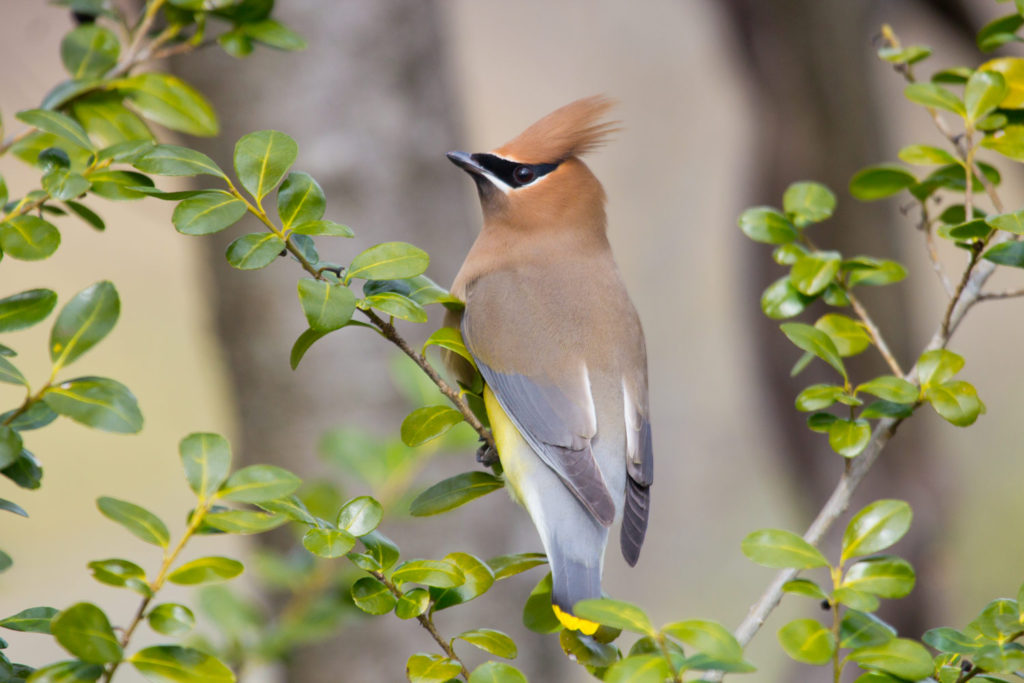 and create stick piles for shelter
and create stick piles for shelter 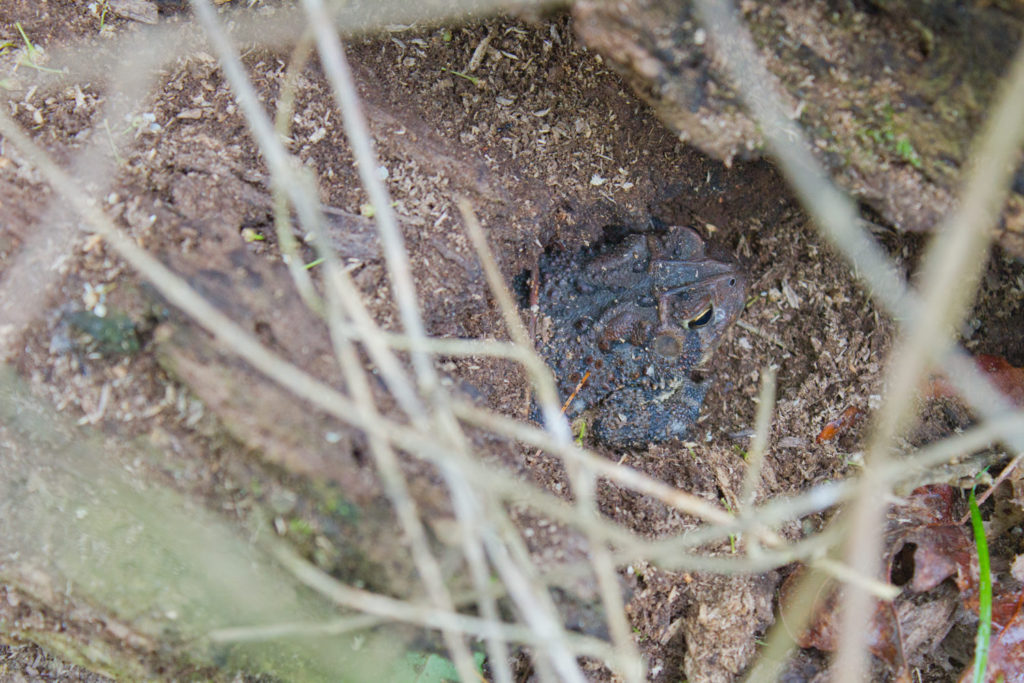 and create a water source like a bird bath or a pond.
and create a water source like a bird bath or a pond.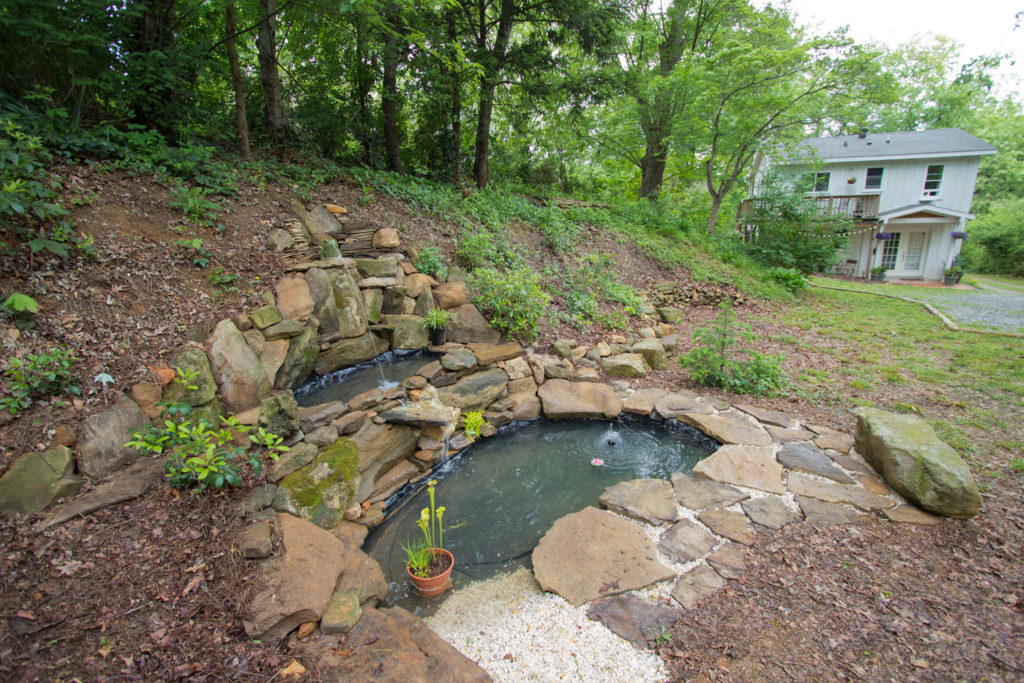
Now you are suddenly supporting an entire community of life. You see that frogs have magically appeared in your pond 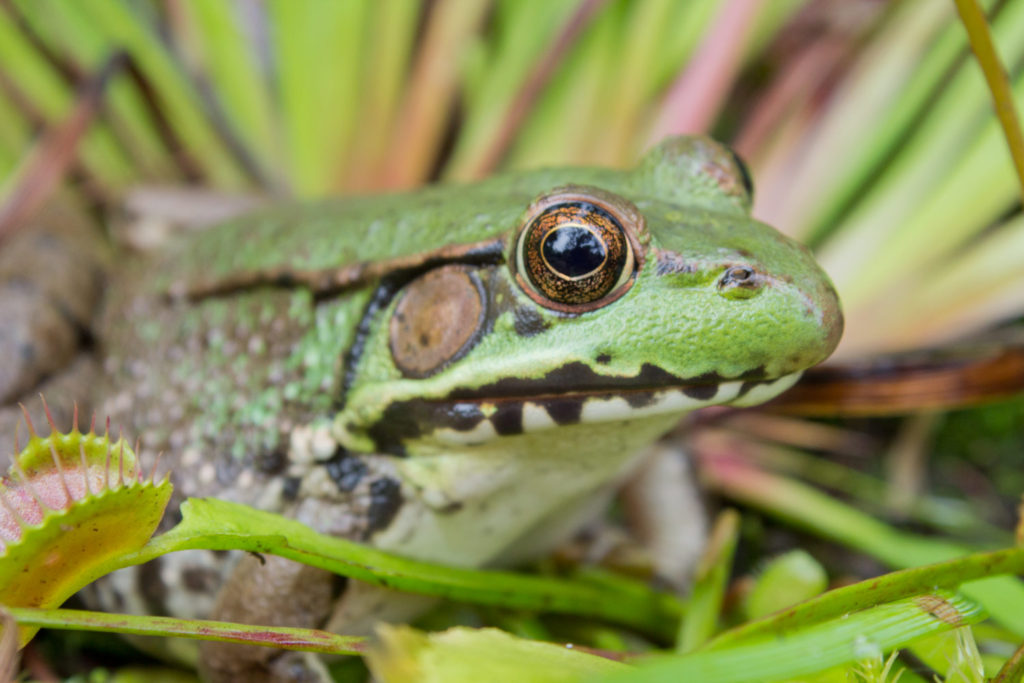 and they’ve laid eggs
and they’ve laid eggs 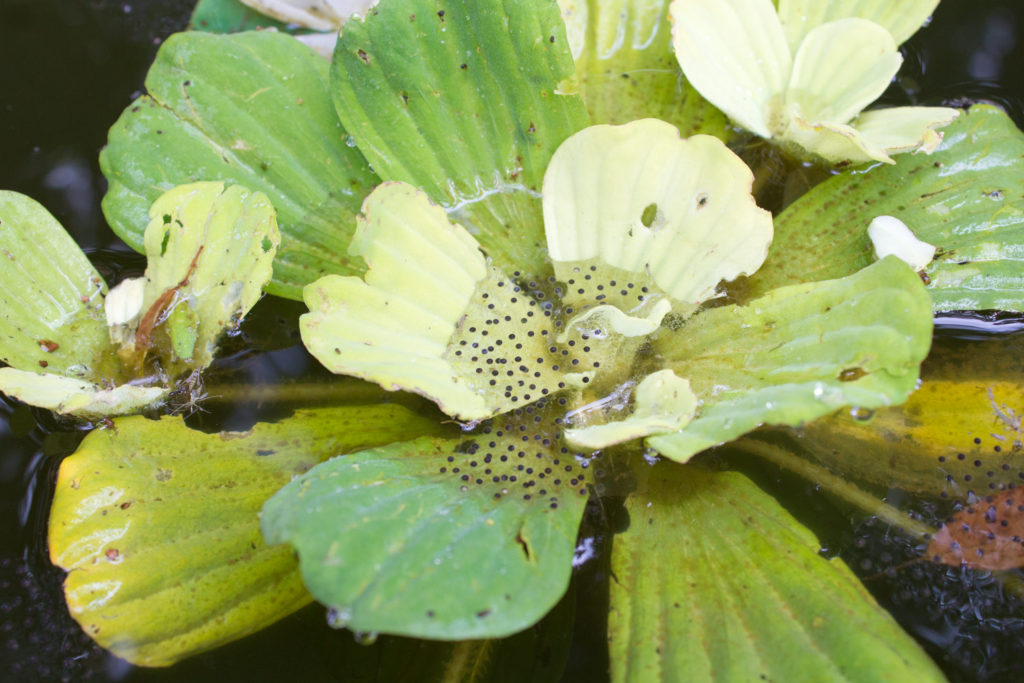 and they’ve turned into tadpoles. You learn the names of the bugs that arrive.
and they’ve turned into tadpoles. You learn the names of the bugs that arrive. 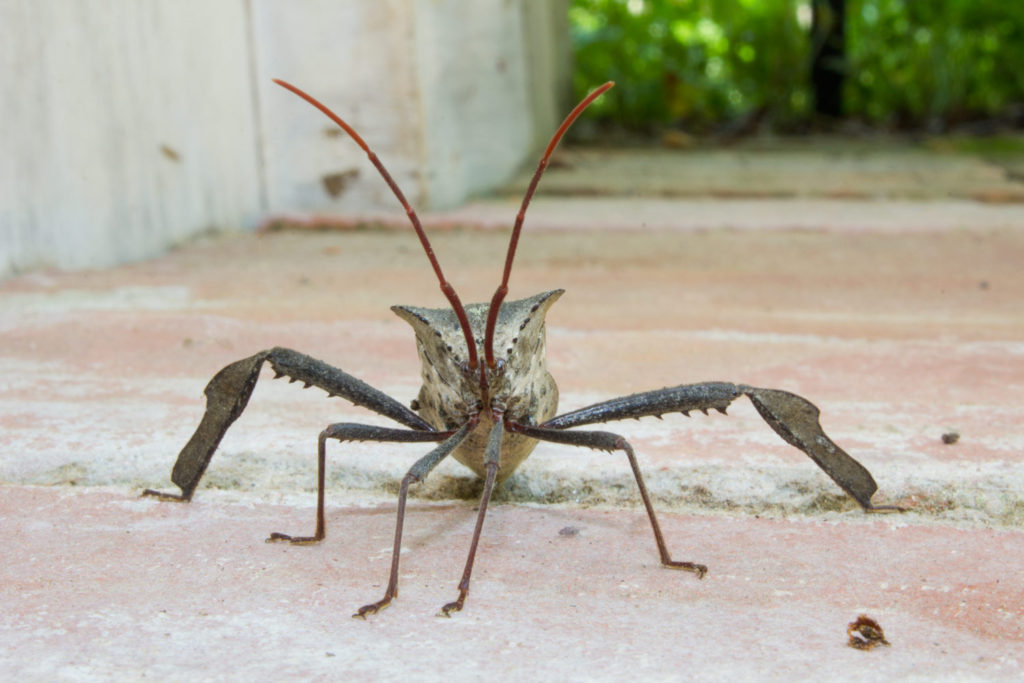 You watch the song birds begin to feed on those bugs and build nests and raise babies right next to your house.
You watch the song birds begin to feed on those bugs and build nests and raise babies right next to your house. 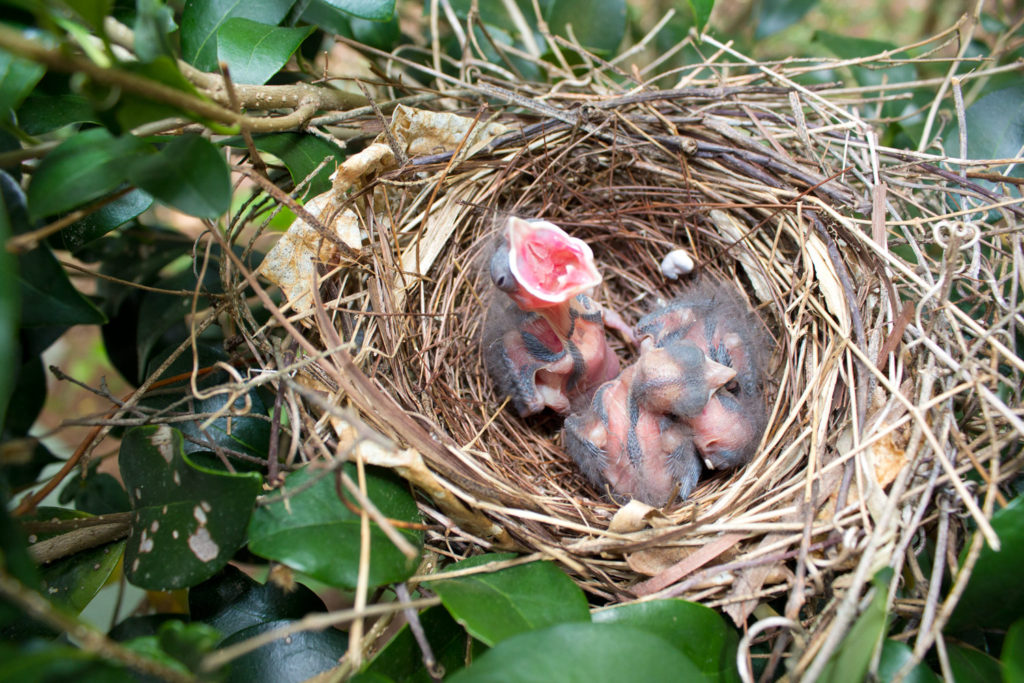 You see a hawk arrive to prey upon the song birds. You see the acorns falling from your new oak tree and then chipmunks arriving to harvest them for winter.
You see a hawk arrive to prey upon the song birds. You see the acorns falling from your new oak tree and then chipmunks arriving to harvest them for winter. 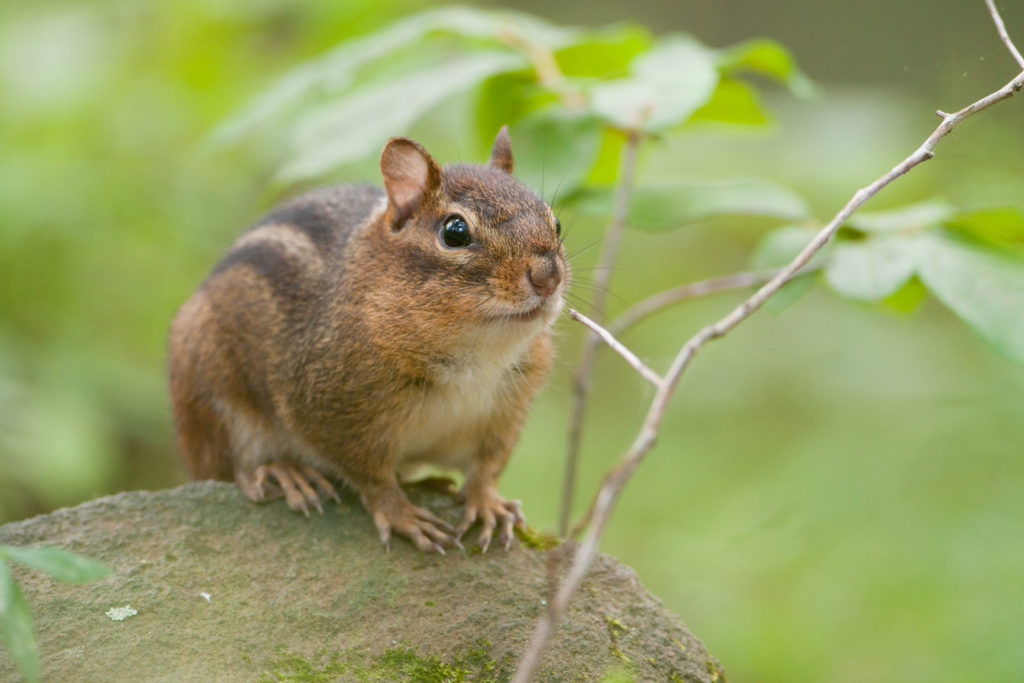 Then one day you see a bear raiding that chipmunk’s cache of nuts.
Then one day you see a bear raiding that chipmunk’s cache of nuts. 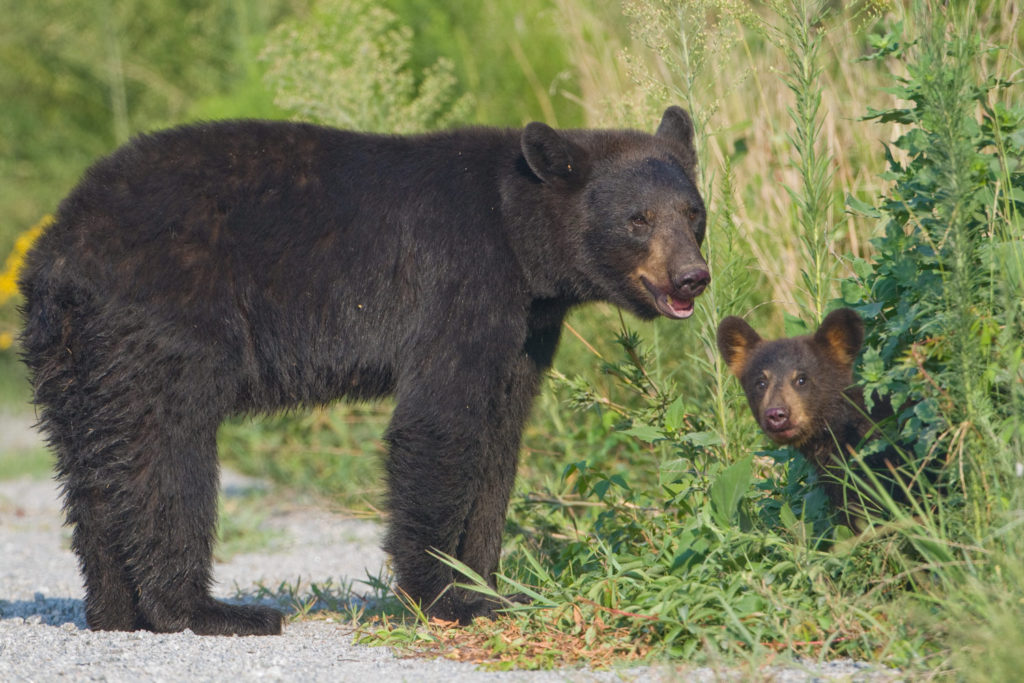 Then you examine the pile of poo left behind by the bear and see the beetles feeding upon it, starting the cycle all over again.
Then you examine the pile of poo left behind by the bear and see the beetles feeding upon it, starting the cycle all over again.
And all the while you watch, enthralled to see the spectacle of life parading in front of you, and you feel an overwhelming sense of respect and admiration and belonging. And you want to pass that on to others.
So you take another photo, and you share your amazing discoveries. This, in my mind, is what nature photography can do for the world. I know it all sounds a bit Utopian, but this is how it really happened for me and I believe it can happen to millions more.
You don’t have to have expensive equipment. Nowadays we are all photographers. The average cell phone today can take excellent quality photos. 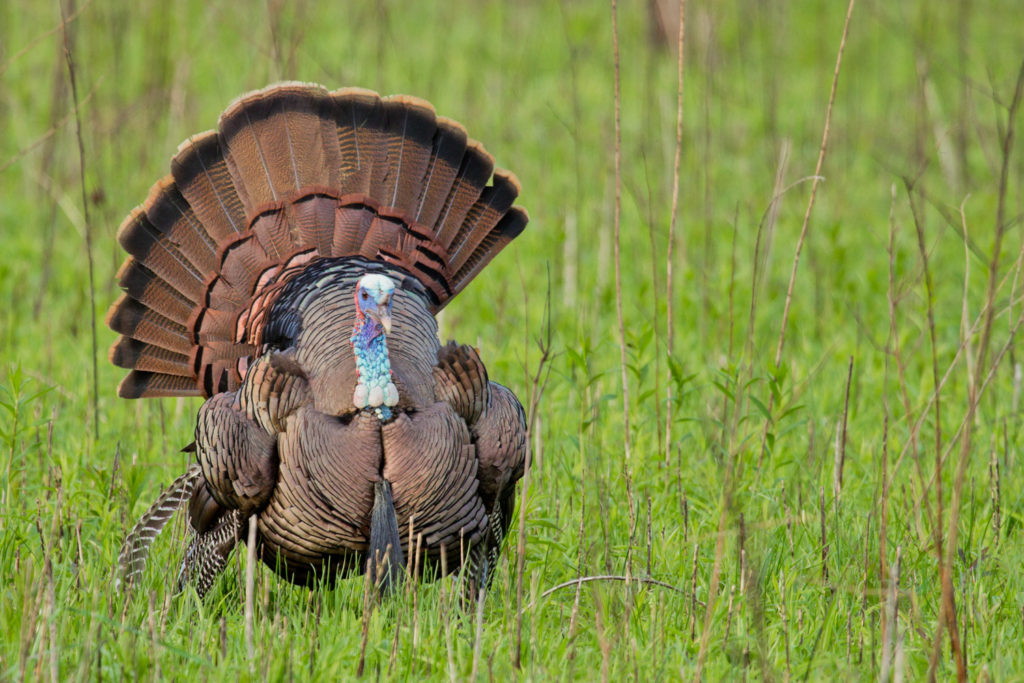 A standard consumer level SLR camera can take technically perfect photos in 90% of situations on completely automatic settings.
A standard consumer level SLR camera can take technically perfect photos in 90% of situations on completely automatic settings.
If there’s just one thing that this lecture inspires you to do, I want it to be this. Take your camera, go outside your house and photograph one living thing in your neighborhood.
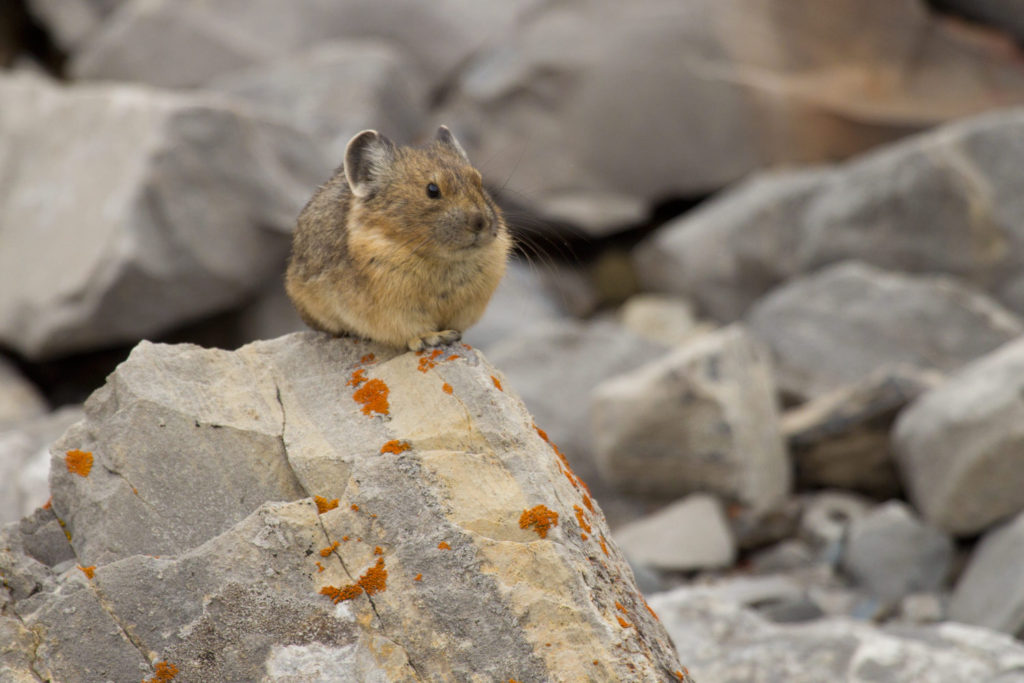
Whether it’s an insect, a tree, a mushroom, a bird, a frog, or an elephant. Then go home, look it up online and figure out what species it is as best you can, and learn one interesting fact about it. Now post it on your favorite social media platform and share what you learned. Then see what happens next.
Whether you share what you’ve experienced on social media or you start your own blog, you’ll then begin to see how your personal experience can transform into mass influence.
The way I see it, there are two ways that photography and blogging can support conservation through mass influence. One is from the bottom up and the other is from the top down.
When I say something is working from the “bottom up”, I mean that it is changing people’s core values and therefore, their behaviors. This could also be referred to as a “pull” scenario. People make changes because they want to and they are pulled toward a better vision.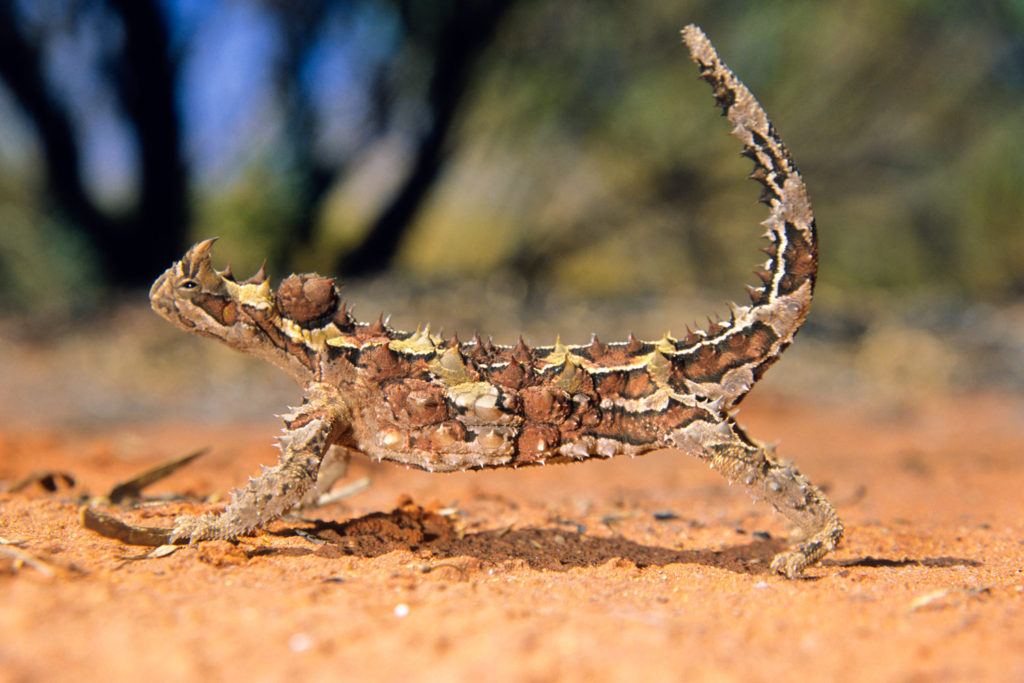
The other type of change happens from the “top down” meaning from a policy level. These could be laws that are enforced by government, or policies enforced by corporations and organizations. This could also be called a “push” system, which attempts to force people to comply with behaviors that support conservation.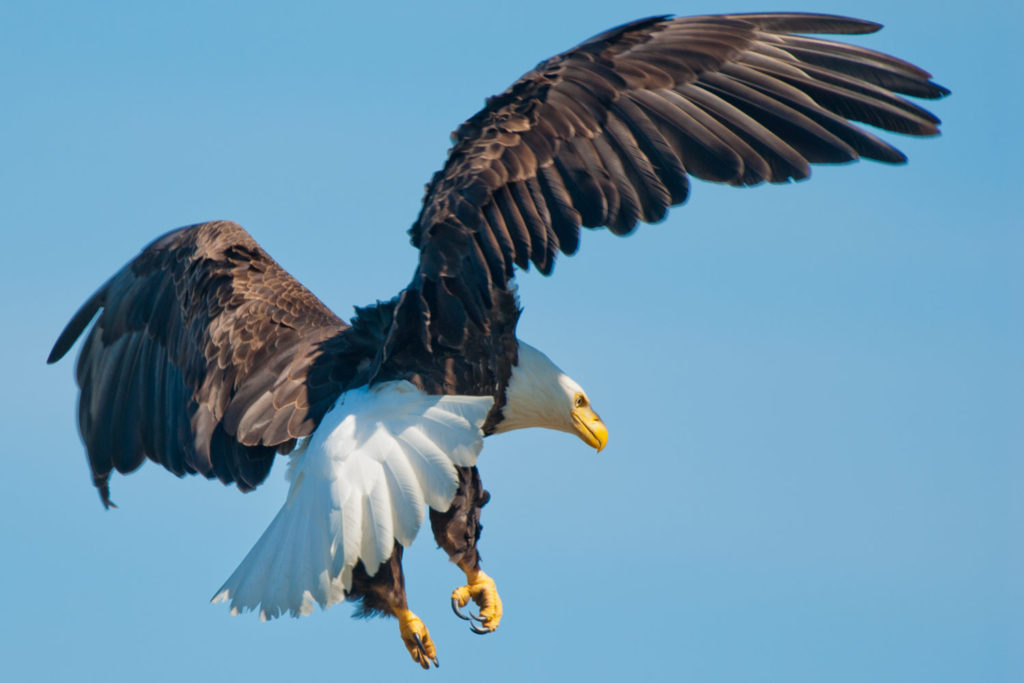
While I believe that the bottom-up method is the only true long-term solution for preserving Earth’s biodiversity, I believe that top-down enforcement may be the only way to get us through the short term conservation crises we now face.
Here’s an example.
Rhinos are disappearing from southern Africa at an alarming rate. 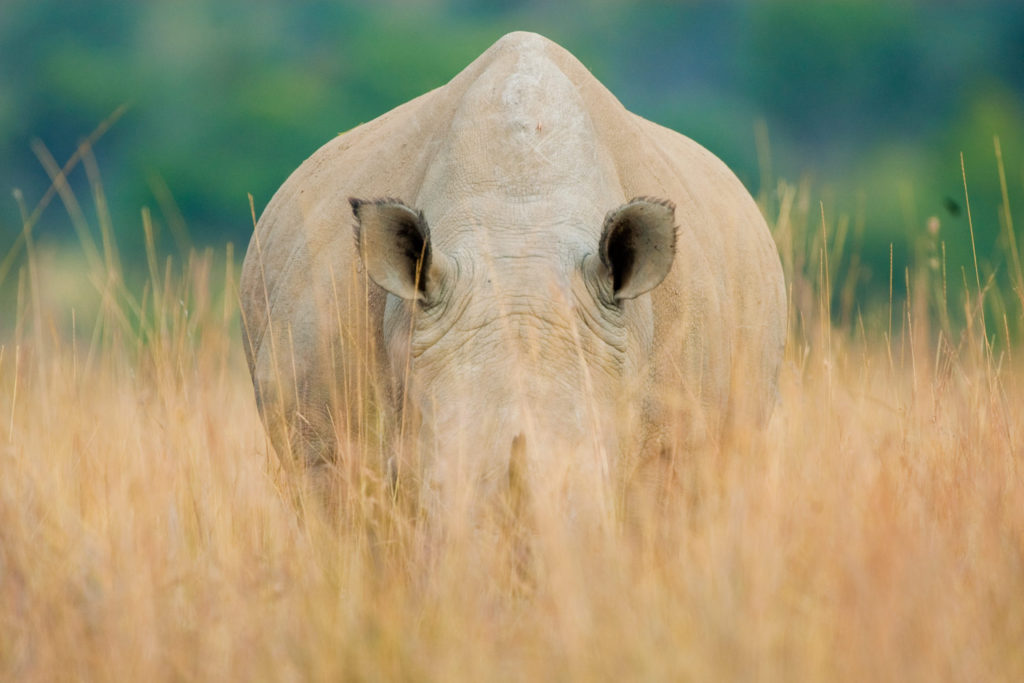 This is not a case of indirect habitat loss. These are humans going out and shooting them to chop off their horns and sell them as traditional medicine in Asian markets.
This is not a case of indirect habitat loss. These are humans going out and shooting them to chop off their horns and sell them as traditional medicine in Asian markets.
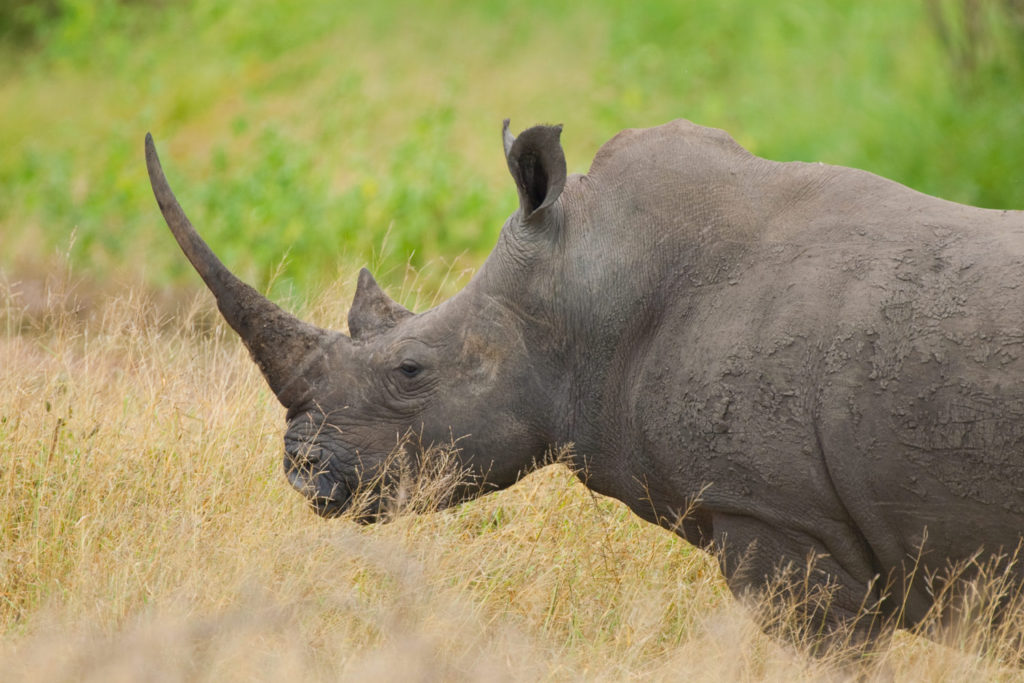 In 2008, 83 rhinos were killed by poachers in South Africa. Every year since then, that number has gone up exponentially. Last year, in 2015, 1,338 rhinos were poached in South Africa. With only 25,000 rhinos left on the whole continent of Africa, this is a substantial portion of the population being killed each year by humans.
In 2008, 83 rhinos were killed by poachers in South Africa. Every year since then, that number has gone up exponentially. Last year, in 2015, 1,338 rhinos were poached in South Africa. With only 25,000 rhinos left on the whole continent of Africa, this is a substantial portion of the population being killed each year by humans. 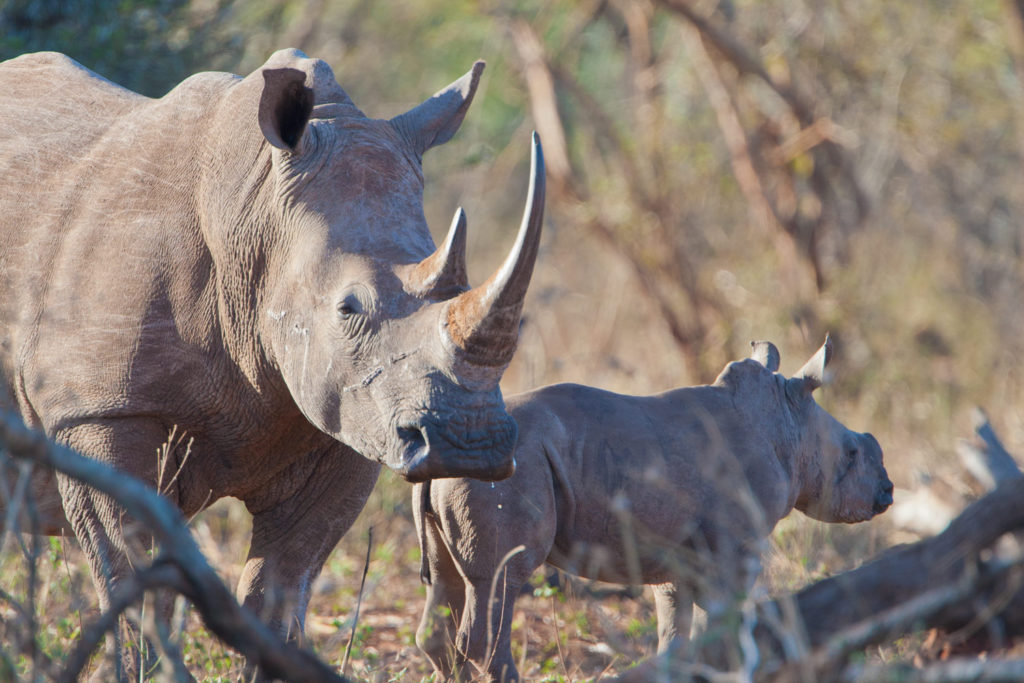 Without any change in this trend, they are likely to disappear from the world forever within 20 years.
Without any change in this trend, they are likely to disappear from the world forever within 20 years.
The first and most obvious way of approaching this crisis is with a top down approach. Make strict laws against rhino poaching and enforce them with as much power as possible. This is exactly what has happened and now rhino poachers may even be shot on sight by armed wildlife rangers. Also stricter laws concerning the trafficking of rhino horn have been enacted.
Miraculously, the rate of rhino poaching finally began to slow this year, with slightly fewer deaths reported in the first quarter of 2016 than for the same period in the previous year. It’s safe to assume that this is a direct result of a top-down conservation approach.
While this type of conservation is absolutely crucial to keep the rhino from suddenly going extinct, this is only treating the symptoms and not the disease.
The root problem is the demand for rhino horn. 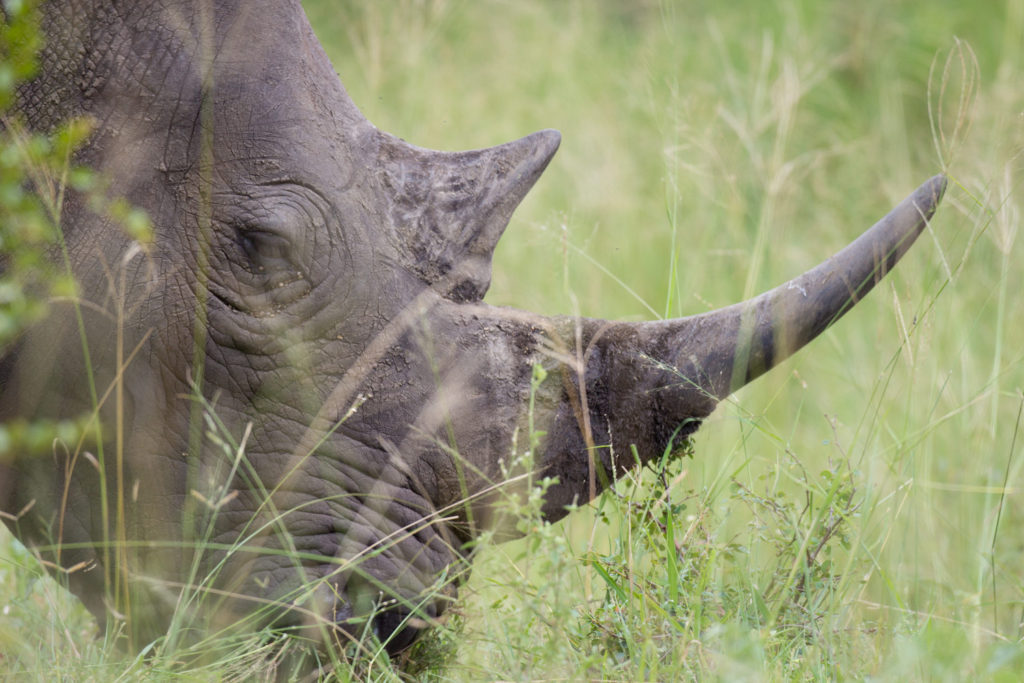 The estimated street value for a gram of rhino horn is higher than a gram of cocaine or even a gram of gold. As long as someone is willing to pay $65,000 for a kilogram of rhino horn, then some other much poorer person will always be willing to risk his life to try to get that much money.
The estimated street value for a gram of rhino horn is higher than a gram of cocaine or even a gram of gold. As long as someone is willing to pay $65,000 for a kilogram of rhino horn, then some other much poorer person will always be willing to risk his life to try to get that much money.
The problem will never go away unless a serious campaign of bottom-up conservation convinces people that rhino horn is actually completely useless as a traditional medicine. When people learn to care about rhinos they will eventually believe that a rhino horn is more valuable on a rhino’s head than it is snorted up your nose. 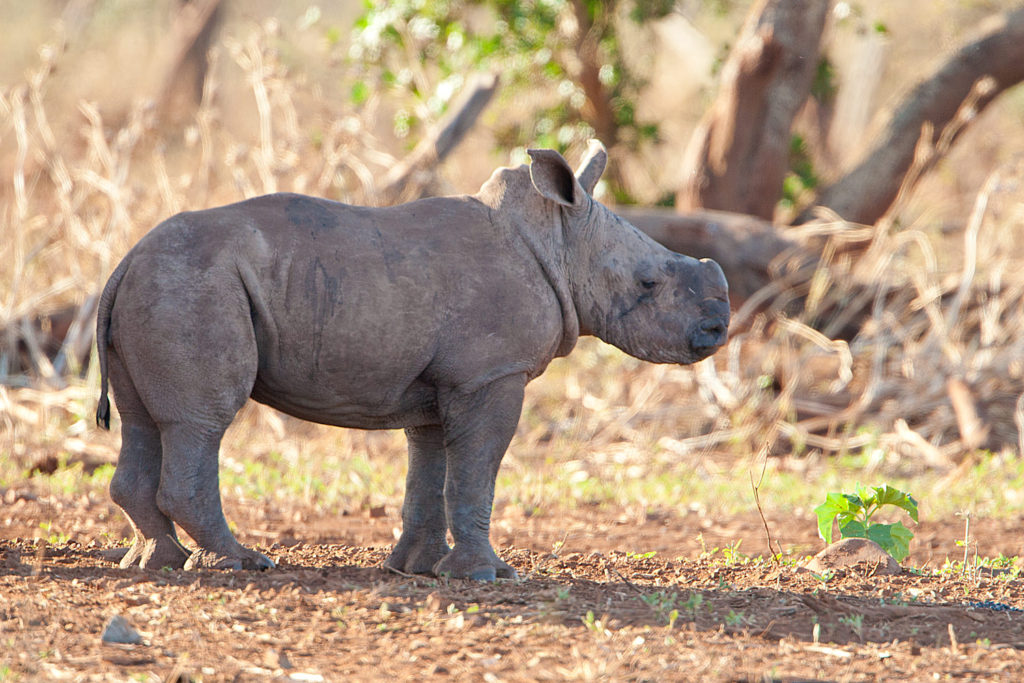 Yes, this kind of idea can be spread through traditional marketing like TV and magazine advertisements. But when we see ads it still feels like the message is being pushed upon us.
Yes, this kind of idea can be spread through traditional marketing like TV and magazine advertisements. But when we see ads it still feels like the message is being pushed upon us.
When we pick up ideas from social media and blogs, it feels like the message is coming from the common people, like a wave that is passing through society. That’s when the message sticks.
Blogs excel at bottom-up messaging. And this is where I believe they have the greatest impact, in changing ideas and behaviors.
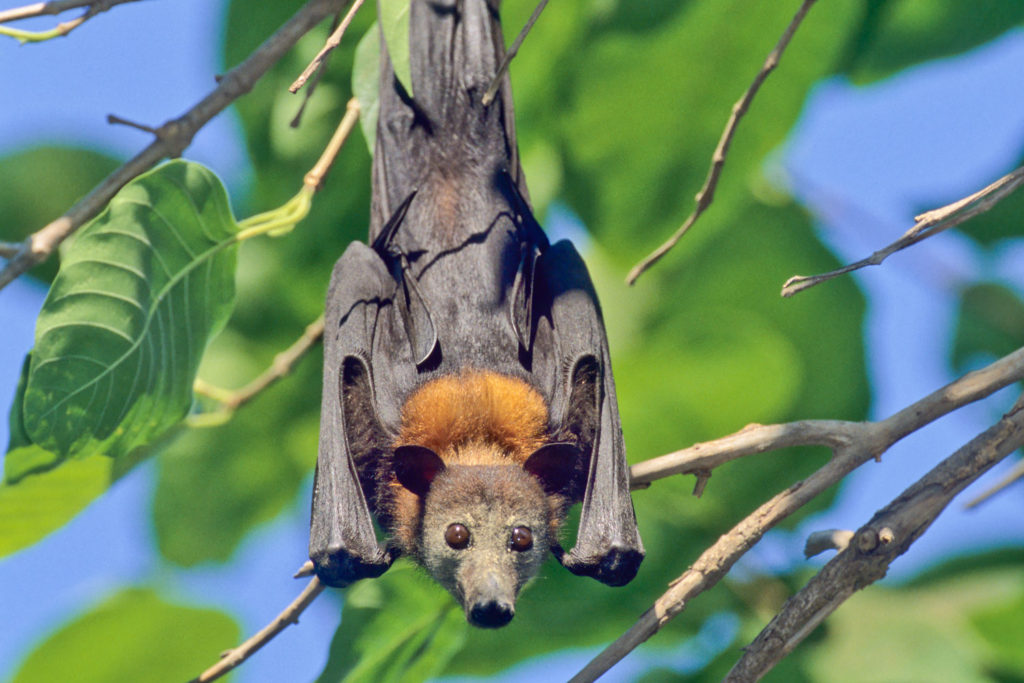 It is certainly possible for blogs to affect top down change, especially if they reach people in a position of power, but these days I believe social media has even more strength than blogs to send messages to decision makers. The angry facebook post, youtube video, or tweet has replaced the angry call to your local government official. When public outcry is unanimous, officials react. And today public outcry happens on social media.
It is certainly possible for blogs to affect top down change, especially if they reach people in a position of power, but these days I believe social media has even more strength than blogs to send messages to decision makers. The angry facebook post, youtube video, or tweet has replaced the angry call to your local government official. When public outcry is unanimous, officials react. And today public outcry happens on social media.
Keep in mind that no individual blog is likely to change the world by itself. Even blogs that have a big reach only receive about a hundred thousand readers a month. Compare that to a big news website like the Huffington Post which gets about a hundred million readers a month (one thousand times more).
However, the cumulative impact of blogs is far greater than news websites when you consider the 150 million or so that exist at any one time. The trick is getting bloggers with reach to work together to send a particular message that helps conservation of wildlife and biodiversity.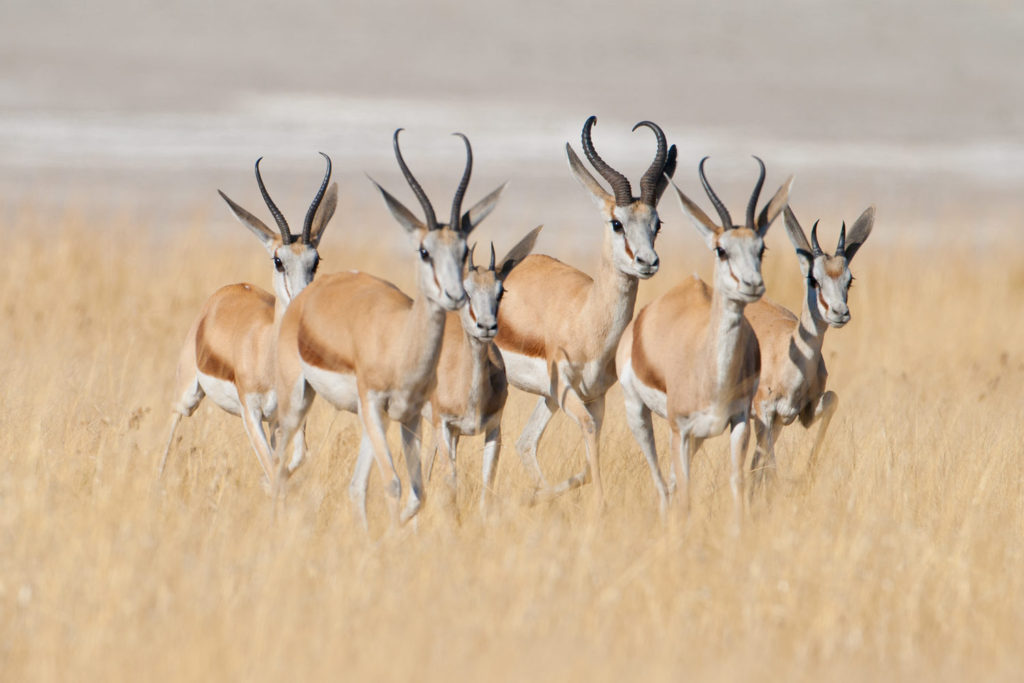
Categories of Blogs that can Affect Conservation
Virtually any kind of blog can affect biodiversity conservation because each of our daily decisions has a huge cumulative impact on the planet. Food bloggers can promote the use of organic foods to reduce deadly pesticides in the environment, or reducing meat consumption because livestock ranching is destroying natural habitat at alarming rates. 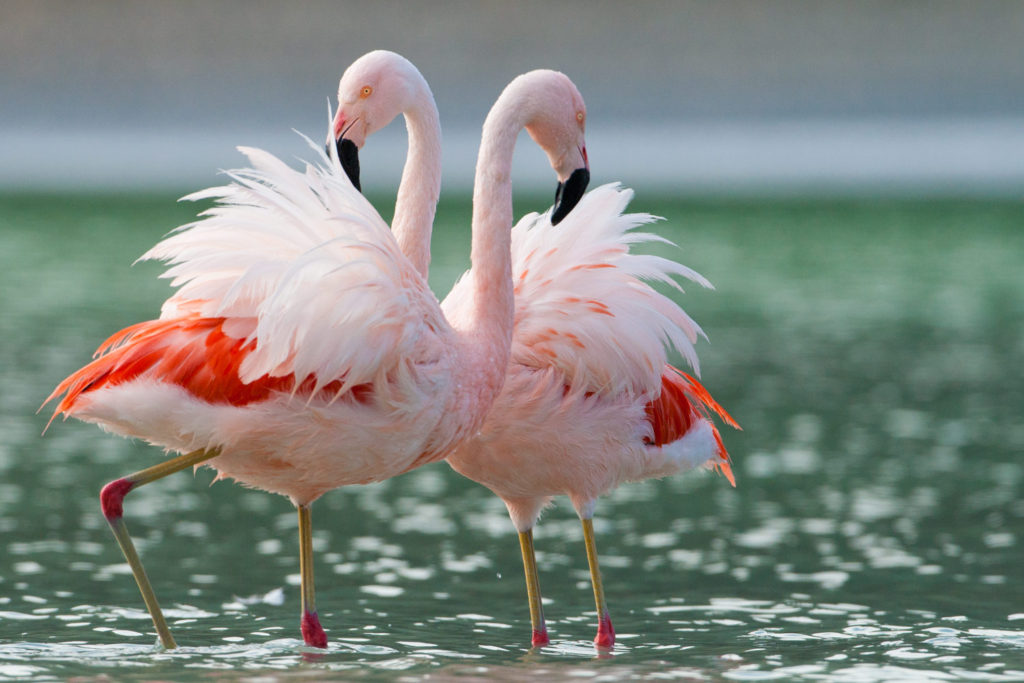 Car bloggers can choose to promote the cars that get the best gas mileage or electric vehicles instead of sports cars and hummers. Real Estate bloggers can focus on tiny homes and efficient living. Fashion bloggers can cry out against animal testing of cosmetics, or the slaughter of wild animals for fur coats.
Car bloggers can choose to promote the cars that get the best gas mileage or electric vehicles instead of sports cars and hummers. Real Estate bloggers can focus on tiny homes and efficient living. Fashion bloggers can cry out against animal testing of cosmetics, or the slaughter of wild animals for fur coats. 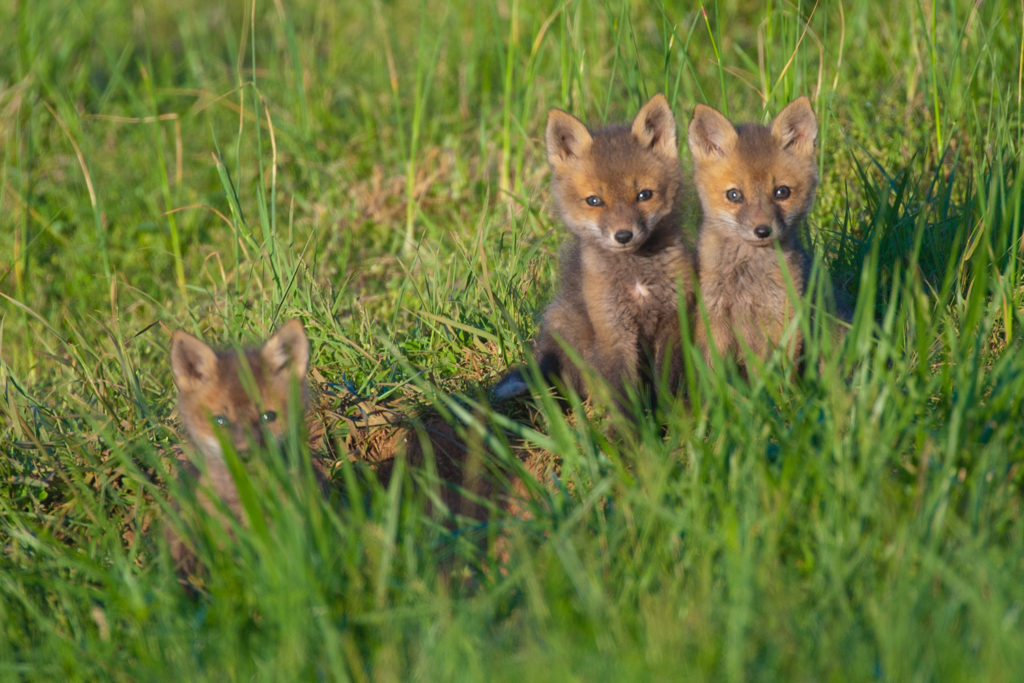 Technology bloggers can talk about the need for electronics that only use wildlife safe minerals. Each one of our cellphones requires a mineral called Coltan, and most of the world’s coltan comes from illegal mining operations in the Democratic Republic of Congo where impoverished miners kill Western Lowland Gorillas for meat. So even buying the wrong kind of cell phone can contribute to the death of some of our most beloved wildlife, like the gorilla.
Technology bloggers can talk about the need for electronics that only use wildlife safe minerals. Each one of our cellphones requires a mineral called Coltan, and most of the world’s coltan comes from illegal mining operations in the Democratic Republic of Congo where impoverished miners kill Western Lowland Gorillas for meat. So even buying the wrong kind of cell phone can contribute to the death of some of our most beloved wildlife, like the gorilla.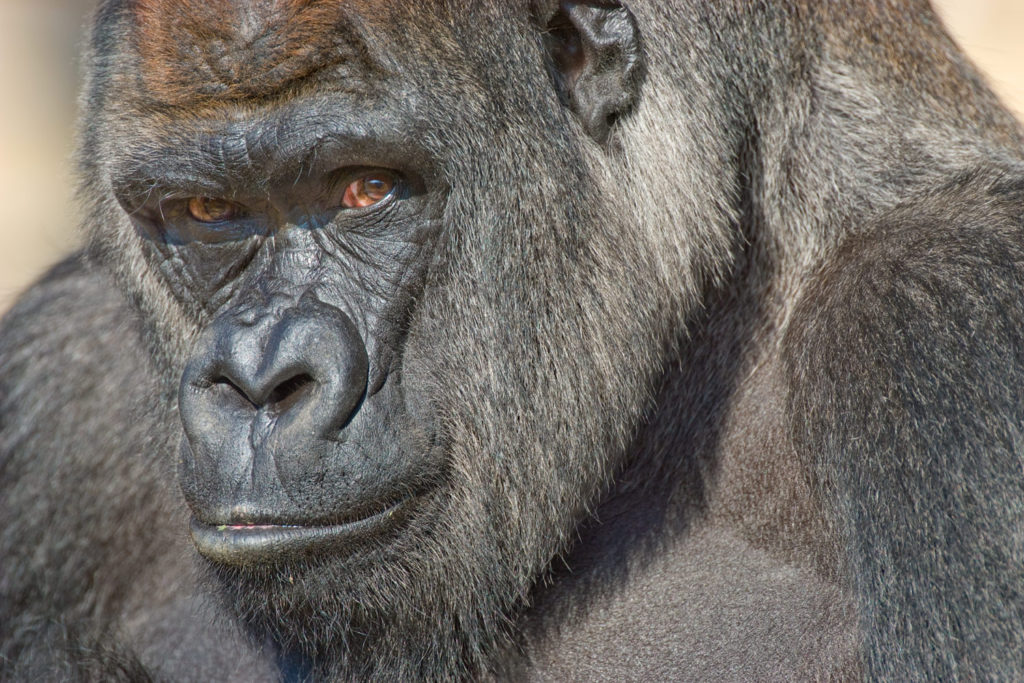
Any kind of blogging can make a difference to conservation. My passion is traveling to see animals in their natural habitat, so that’s what I blog about.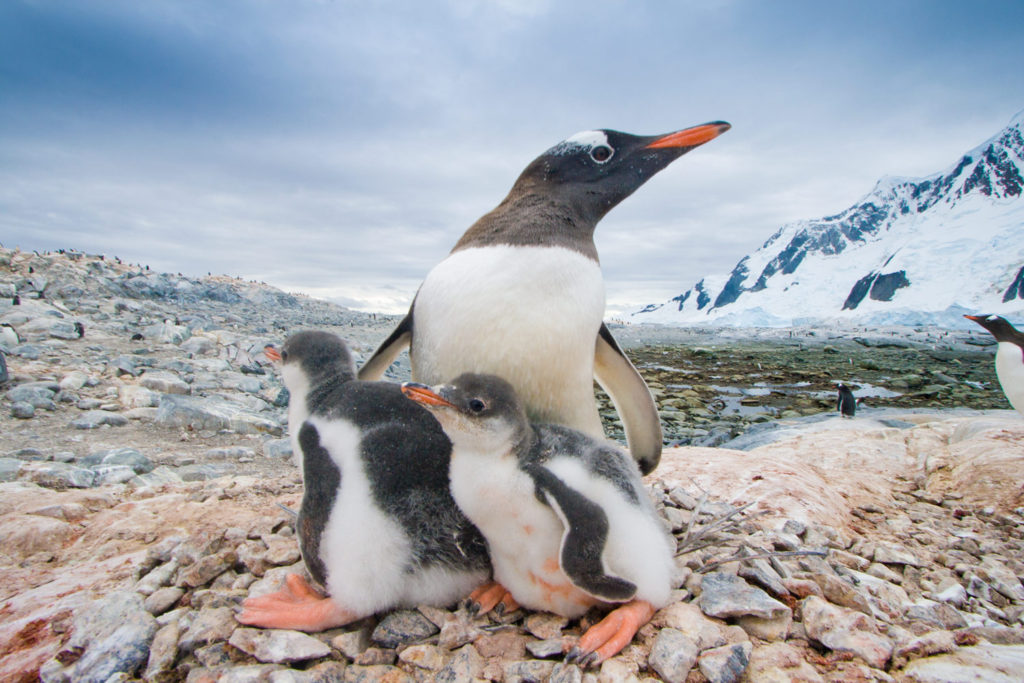
My wife and I started Travel For Wildlife.com four years ago and our primary goal is to promote conservation through sustainable wildlife tourism.
What is sustainable wildlife tourism?
Well wildlife tourism is pretty self-explanatory. It’s people going somewhere to see animals in the wild.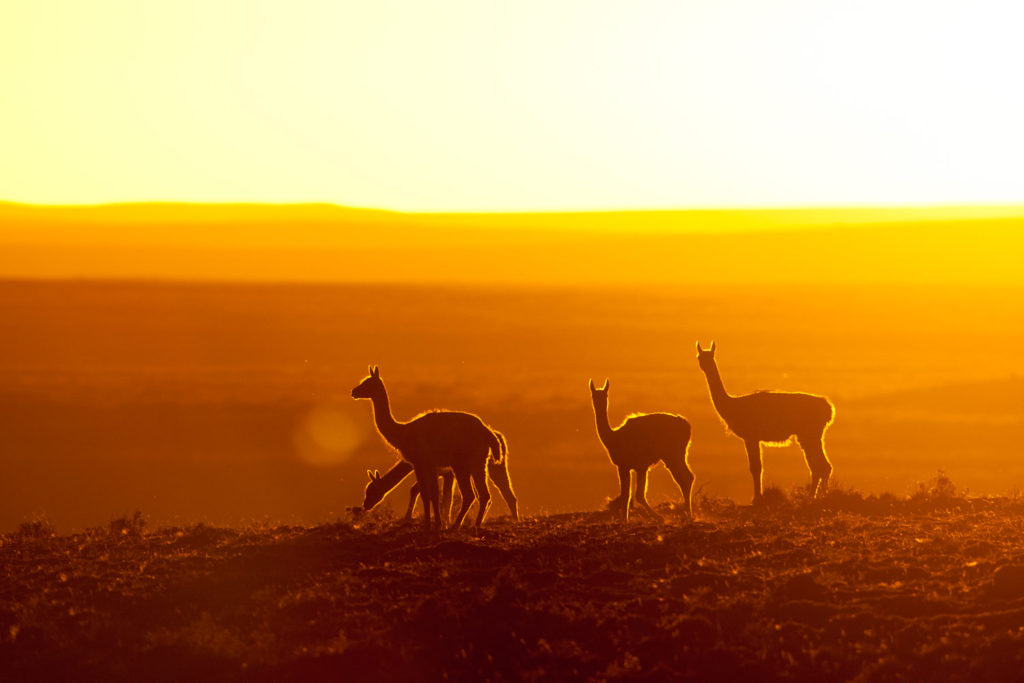
The word sustainable is a little more slippery. Words like eco-friendly, green, responsible, and sustainable get tossed around a lot. And once these words become common, they get abused and their meanings get diluted. That’s why the terms “eco” and “green” have already fallen out of fashion. They popped up long enough ago that big companies started calling their products eco-this and green-that in order to sell them to the environmentally conscious crowd.
Today, the newer terms “responsible” and “sustainable” are more in favor, but of course that will change too. They all, however, have the same basic underlying implication; that it does no harm to living things.
Sustainable could be considered to have a slightly more specific meaning, and that is: you could go on doing this forever and things would never get worse for any of the living things involved.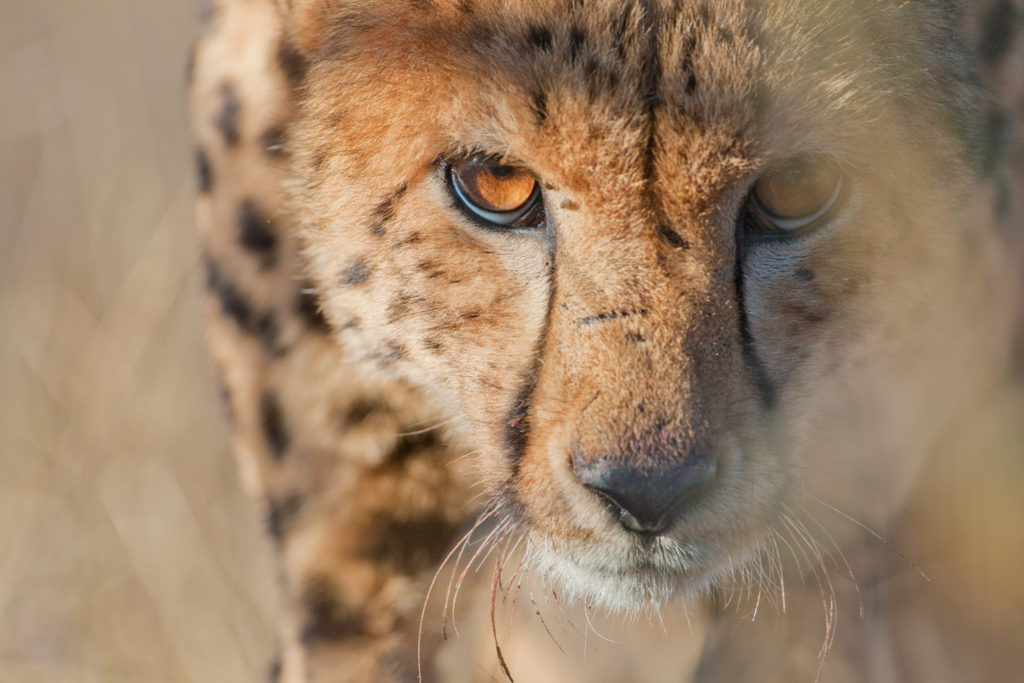
Now how does this apply to wildlife tourism? First of all, we have to acknowledge the inherent hypocrisy in the phrase “sustainable wildlife tourism”.
Tourism, of course, involves going somewhere. And in today’s world, going somewhere means burning fossil fuels by car, train, airplane, or boat. As we all know, transportation is one of the biggest contributors to greenhouse gases in our atmosphere, and therefore to global climate change. And global climate change is one of the biggest threats to biodiversity on our planet right now. When climates and ecosystems change faster than species can adapt to them, then species die. That’s pretty straightforward.
Yes, there are a few forms of transportation that don’t contribute to atmospheric carbon buildup. A sailboat is one excellent example (although sailors still use their motors pretty frequently). 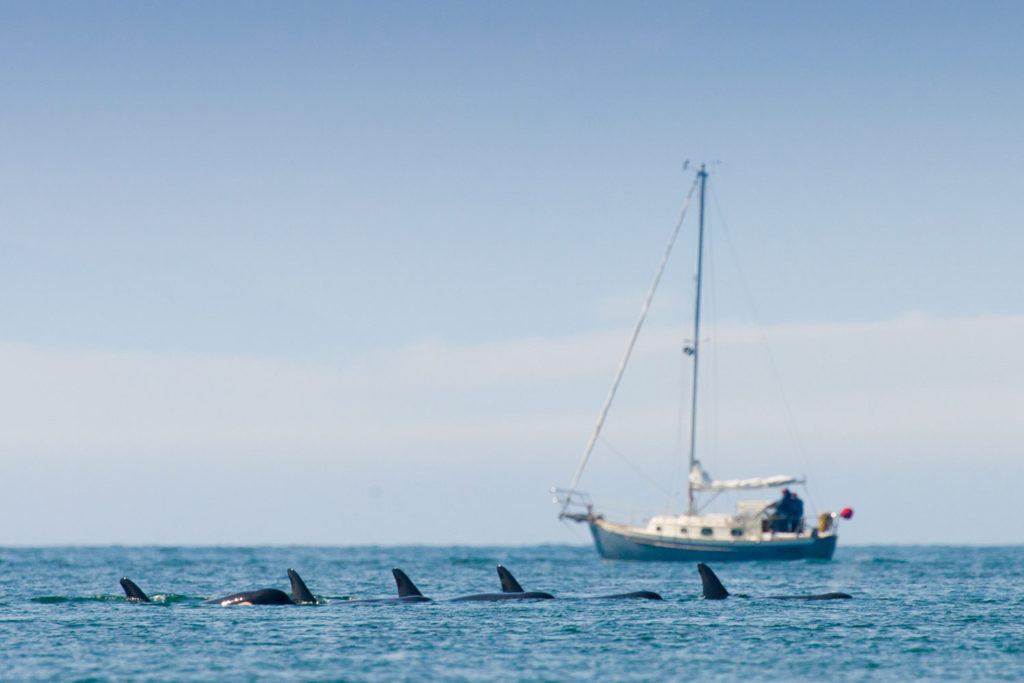 Other than that, your only good options are traveling under human power: hiking, biking, or kayaking.
Other than that, your only good options are traveling under human power: hiking, biking, or kayaking. 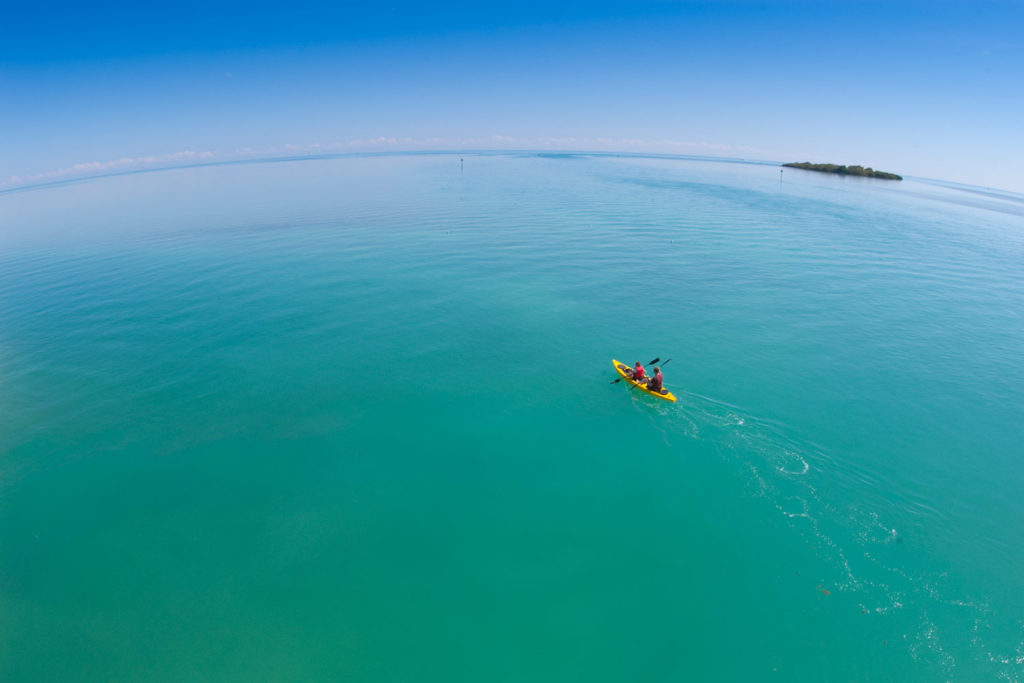 Sure, there are people who travel this way, but they make up a tiny fraction of the travel market.
Sure, there are people who travel this way, but they make up a tiny fraction of the travel market.
So how can we have the audacity to use the term “sustainable wildlife tourism” when virtually all current forms of travel are unsustainable by definition?
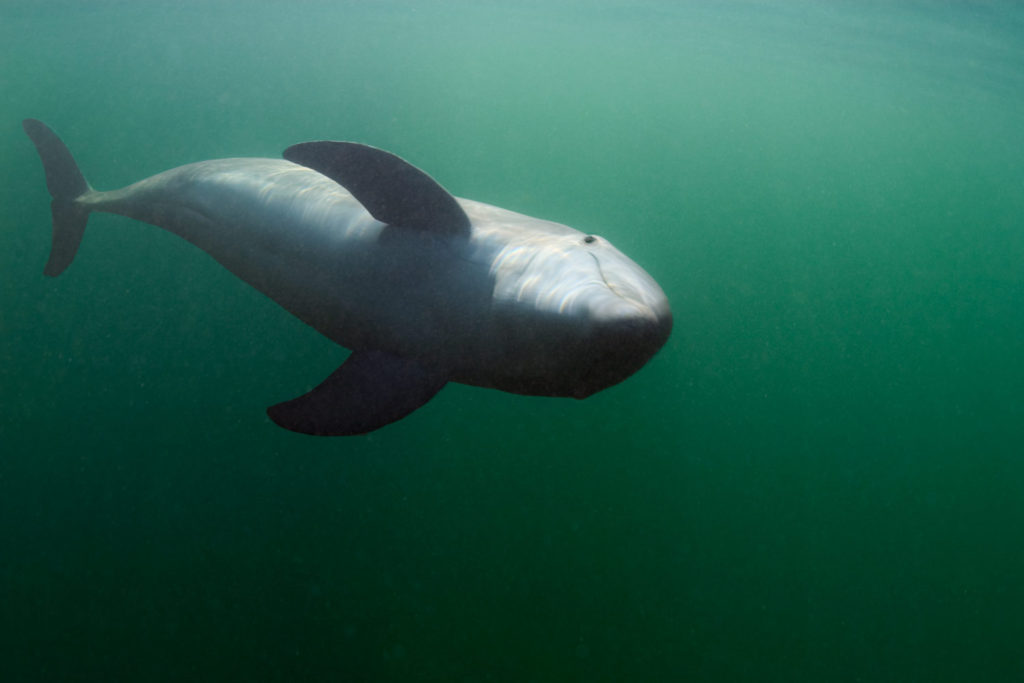 Good question. Personally I get a small twinge every time I use the phrase because a part of me knows it is a contradiction. Then how do I justify this to myself? By realizing that some travel options are much, much worse than others.
Good question. Personally I get a small twinge every time I use the phrase because a part of me knows it is a contradiction. Then how do I justify this to myself? By realizing that some travel options are much, much worse than others.
In my head, I amend the phrase to “most-sustainable wildlife tourism options”. As I’ve stated, the getting-from-here-to-there could generally be considered the most damaging aspect of travel. 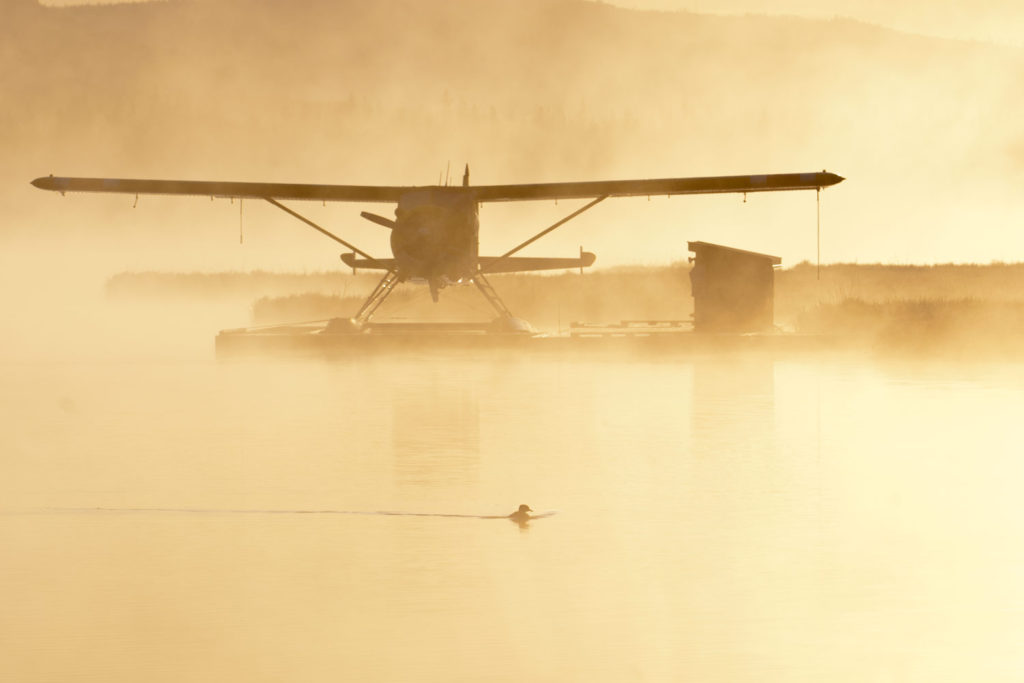 So first you do everything you can to minimize your impact from the transportation itself; drive instead of fly, or fly in more efficient airplanes, travel shorter distances and less frequently, seek alternate forms of transportation, etc. This all falls under the realm of smart traveling in general.
So first you do everything you can to minimize your impact from the transportation itself; drive instead of fly, or fly in more efficient airplanes, travel shorter distances and less frequently, seek alternate forms of transportation, etc. This all falls under the realm of smart traveling in general.
But when we talk about sustainable wildlife tourism, we’re talking about what happens on the ground after you’ve arrived. The destinations you choose, the lodging you stay in, the food you eat, the businesses you support, and, often the most important decision of all, the activities you partake in.
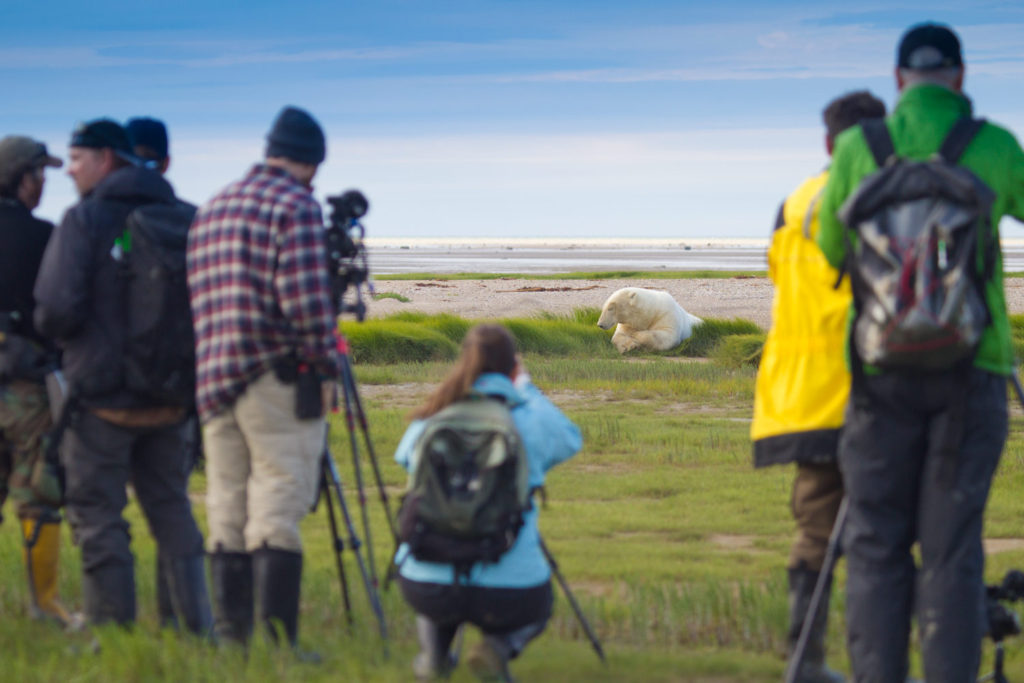 Here is where blogging can make a huge impact on conservation. By helping people make the smartest decisions possible when traveling. By helping them to choose the options that do the least possible damage to the animals and habitats they’re traveling to see. And even better still, helping people find wildlife tourism options that actually benefit wildlife and habitat.
Here is where blogging can make a huge impact on conservation. By helping people make the smartest decisions possible when traveling. By helping them to choose the options that do the least possible damage to the animals and habitats they’re traveling to see. And even better still, helping people find wildlife tourism options that actually benefit wildlife and habitat.
How can wildlife tourism benefit wildlife?
Eco-tourism is another word that has been tossed around so much that it has virtually no meaning anymore. We see plenty of tours that call themselves eco-tours simply because they happen outside, even if that tour is directly damaging to wildlife or habitats. But if we’re searching for the intended meaning of eco-tourism it would probably be something along the lines of tourism that is eco-friendly, that is, it does no damage to the ecology (the complex web of living things) of the place being visited.
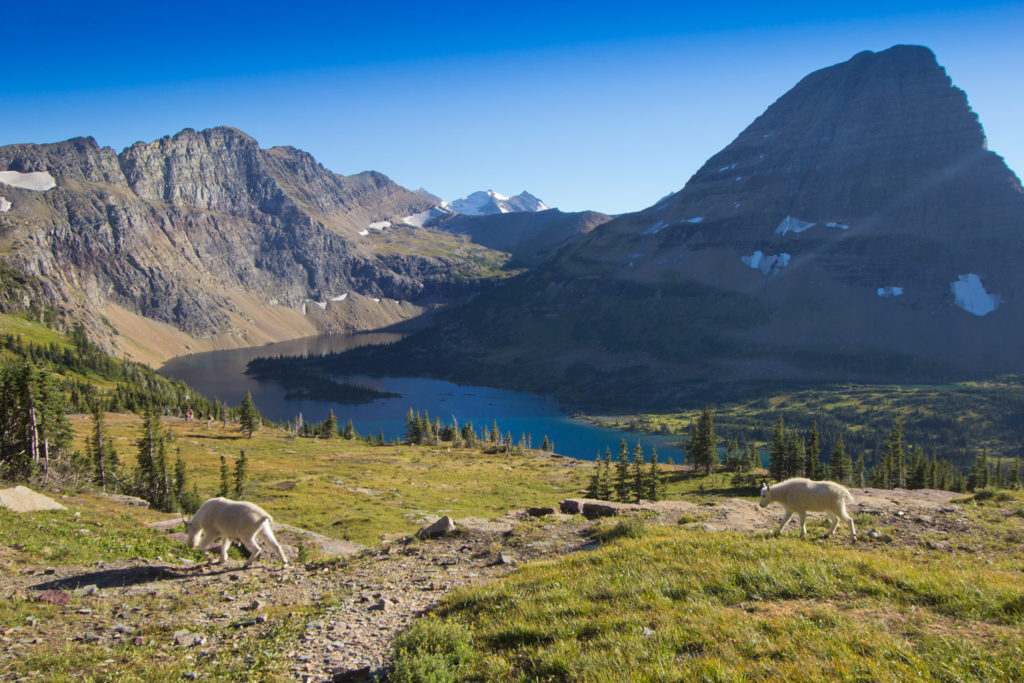 The more ambitious definition would be tourism that actually benefits the plants and animals in a particular area. How is this possible? The basic premise is a simple one: when humans have a good incentive to protect their local wildlife, they will. Sounds obvious enough right? The challenge is making the incentive to protect it more attractive than the current incentives to destroy it.
The more ambitious definition would be tourism that actually benefits the plants and animals in a particular area. How is this possible? The basic premise is a simple one: when humans have a good incentive to protect their local wildlife, they will. Sounds obvious enough right? The challenge is making the incentive to protect it more attractive than the current incentives to destroy it.
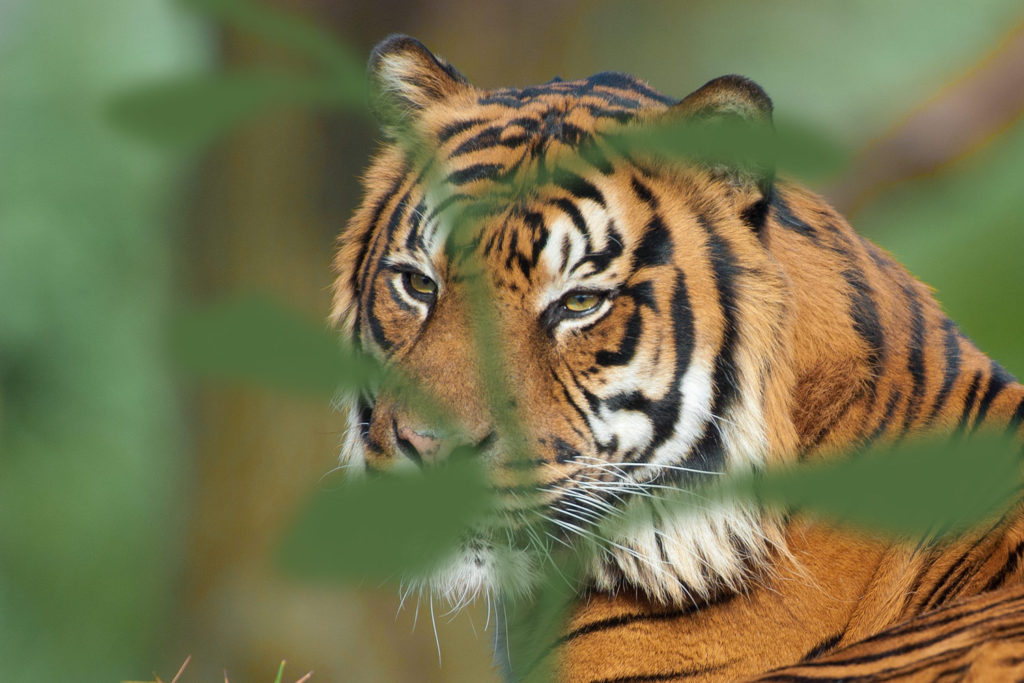 Let’s say you live on the edge of a tract of rainforest in the center of Sumatra. You’re an average local, living in a tiny village where employment opportunities are extremely limited. The only way you know to make money to support your family is to take part in the illegal logging activities in the nearby national park. The wood you cut is used to supply Indonesia’s huge paper pulp and plywood export industry, so the demand is constant and the money from it allows you to survive. You may realize that these same woods you’re cutting are the last refuge to Sumatra’s tigers and elephants and rhinos. But having food for your baby is certainly more important to you than the vague notion of destroying habitat for some animal that you’ll probably never see.
Let’s say you live on the edge of a tract of rainforest in the center of Sumatra. You’re an average local, living in a tiny village where employment opportunities are extremely limited. The only way you know to make money to support your family is to take part in the illegal logging activities in the nearby national park. The wood you cut is used to supply Indonesia’s huge paper pulp and plywood export industry, so the demand is constant and the money from it allows you to survive. You may realize that these same woods you’re cutting are the last refuge to Sumatra’s tigers and elephants and rhinos. But having food for your baby is certainly more important to you than the vague notion of destroying habitat for some animal that you’ll probably never see.
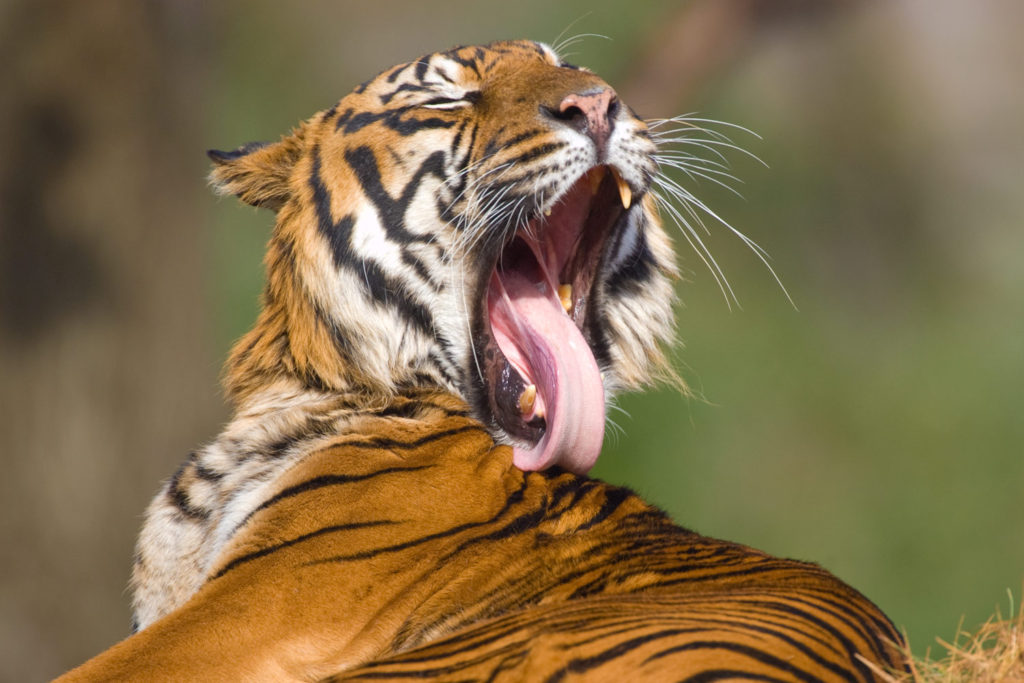 Now let’s say you live on the edge of a tract of rainforest in the center of Sumatra but your village has initiated an eco-tourism program. Now your village has a lodge and a cooperative of independent guest houses. There is a small restaurant and a shop that sells local crafts, and a training program for local guides and park rangers. You start to see that people are traveling across the world just to see your neighborhood and the animals that live there. It not only gives you a more lucrative source of income, but it gives you a sense of pride in the place you live. You want to show people the wonders of your corner of the world and you want to protect it for generations to come so that your children can have the same opportunities.
Now let’s say you live on the edge of a tract of rainforest in the center of Sumatra but your village has initiated an eco-tourism program. Now your village has a lodge and a cooperative of independent guest houses. There is a small restaurant and a shop that sells local crafts, and a training program for local guides and park rangers. You start to see that people are traveling across the world just to see your neighborhood and the animals that live there. It not only gives you a more lucrative source of income, but it gives you a sense of pride in the place you live. You want to show people the wonders of your corner of the world and you want to protect it for generations to come so that your children can have the same opportunities.
Ideally this system is not only sustainable, it actually restores habitat and helps return endangered species to the landscape. This type of tourism, in fact, benefits conservation.
Often this is easier said than done. A careful balance must be maintained so that the tourism itself doesn’t become too big and harmful. So that the development of infrastructure (hotels, roads, airports) doesn’t become just as damaging as the logging that came before it. So that overwhelming numbers of aggressive tourists don’t show up and scare the tigers away from their last refuge. So that abusive attractions don’t pop up to entertain the tourists, like the cruel practice of capturing wild elephants, breaking their spirits, and forcing them to give rides to tourists. 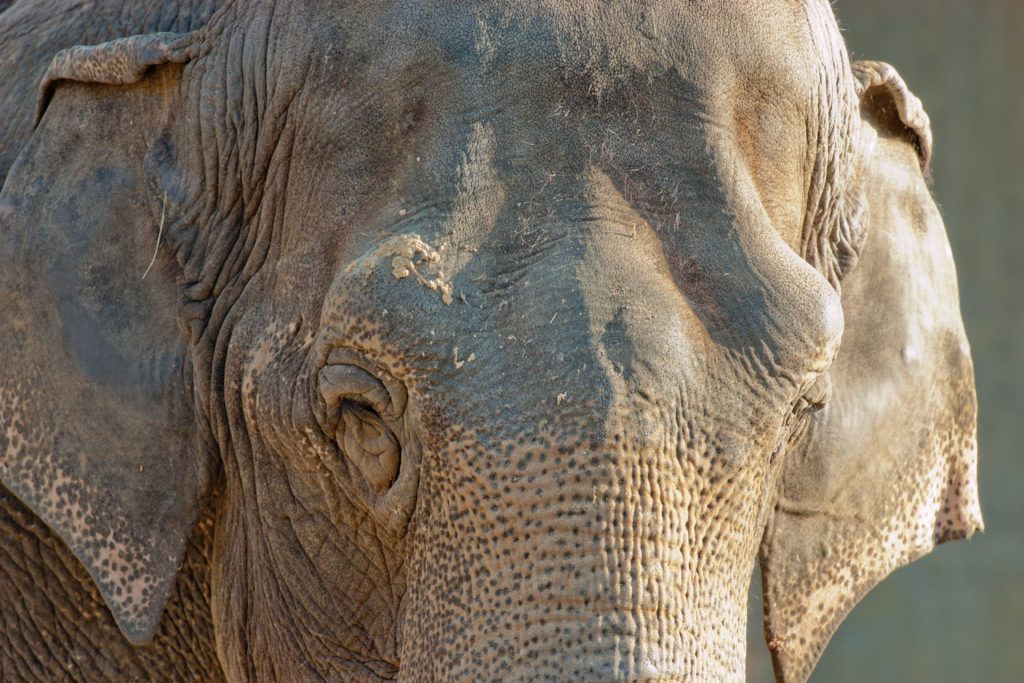 Which brings us to our next subject.
Which brings us to our next subject.
How can photography and blogging HURT conservation?
Aggressive photographers.
Wildlife photography has its downfalls. Like any activity, people can be irresponsible and wildlife photography can often cause far more damage than good.
Here’s one small example. Kruger National Park is a gigantic park in South Africa. Here you can see what is probably the most diverse array of wildlife of any park in all of Africa. 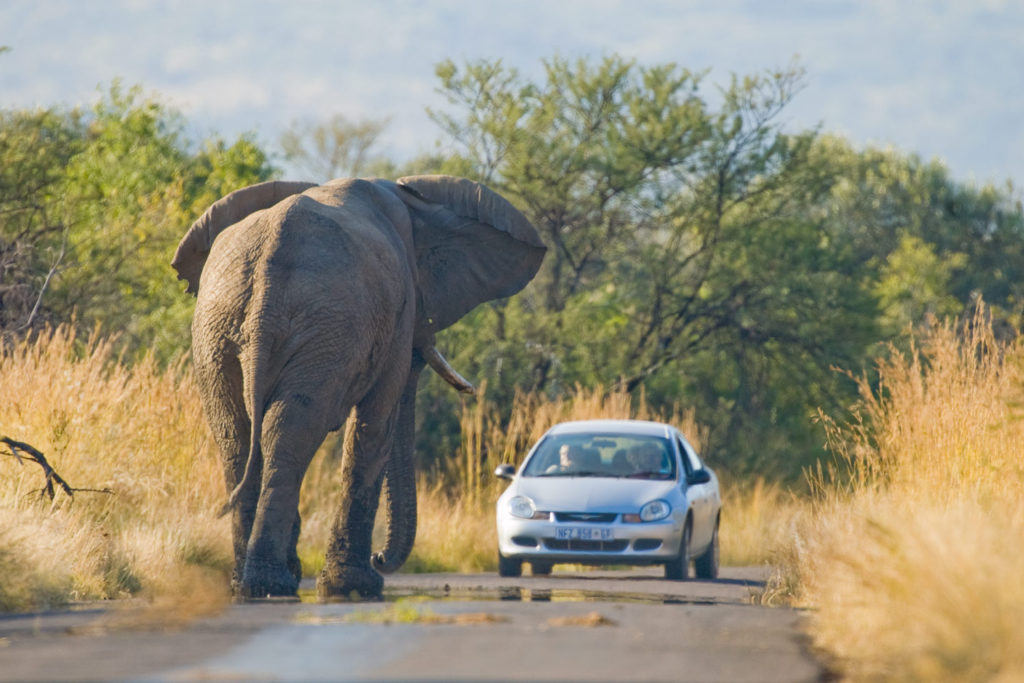 The diversity of large mammals alone is extraordinary, and this includes big predators. One of the greatest prizes of all is to see the elusive leopard in the wild.
The diversity of large mammals alone is extraordinary, and this includes big predators. One of the greatest prizes of all is to see the elusive leopard in the wild.
Inside Kruger there are several large guest camps that are essentially fenced-in villages where visitors can stay in small chalets or tent camp without lions or leopards getting in to eat them. These camps are surrounded by tall fences and electrified wires.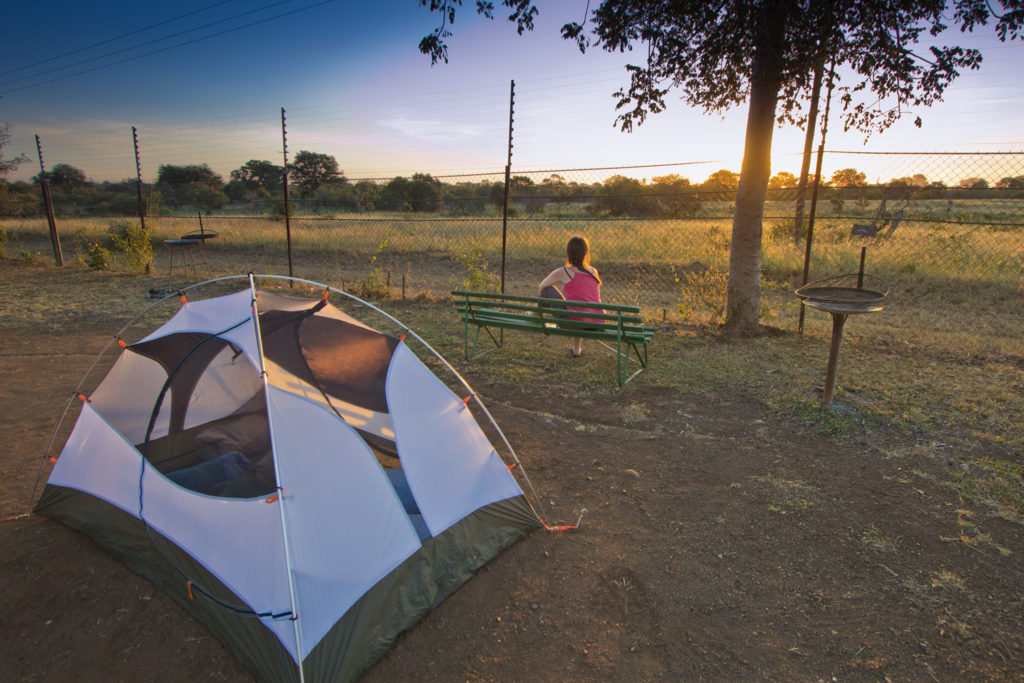
Visitors spend the day driving around in their cars and searching the bush for elusive sightings.
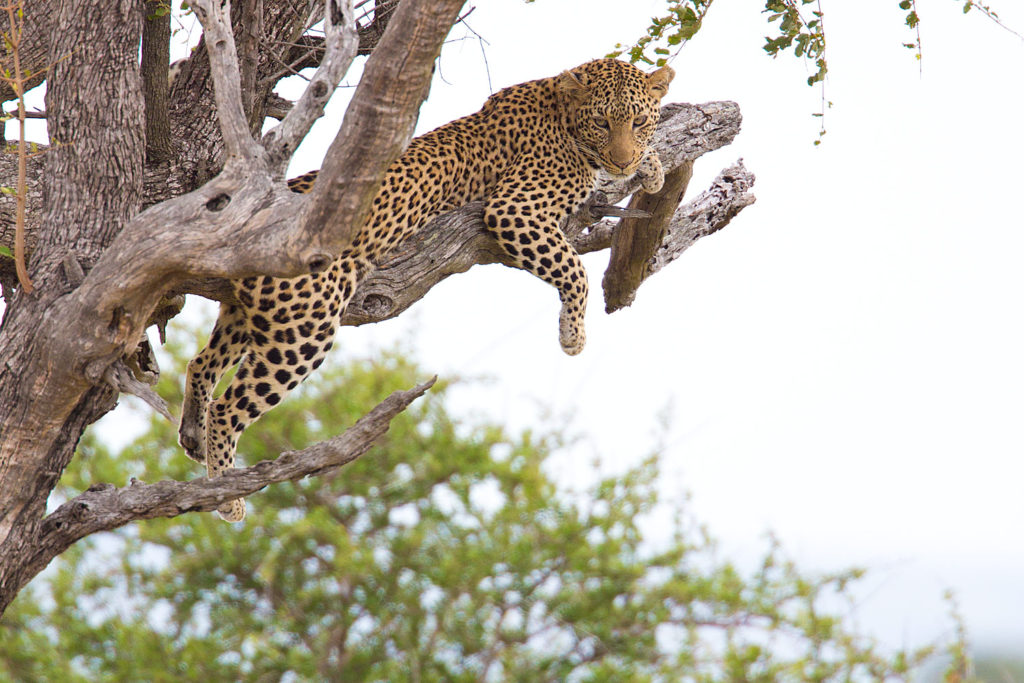 One day, a leopard was spotted just outside of one of these camps near an entrance gate. Of course everybody wanted to get a look at this leopard because they are so rarely seen. Cars began to crowd around it as everyone did their best to get their prize photo. But soon the leopard was trapped against the fence by a wall of cars. In a desperate attempt to escape, it leapt toward the electrified fence, became entangled in the wire and was electrocuted to death right in front of the eager photographers.
One day, a leopard was spotted just outside of one of these camps near an entrance gate. Of course everybody wanted to get a look at this leopard because they are so rarely seen. Cars began to crowd around it as everyone did their best to get their prize photo. But soon the leopard was trapped against the fence by a wall of cars. In a desperate attempt to escape, it leapt toward the electrified fence, became entangled in the wire and was electrocuted to death right in front of the eager photographers.
This is an extreme example but similar examples of irresponsible photography abound. Birders chasing rare birds until they are frightened away from their nesting grounds. 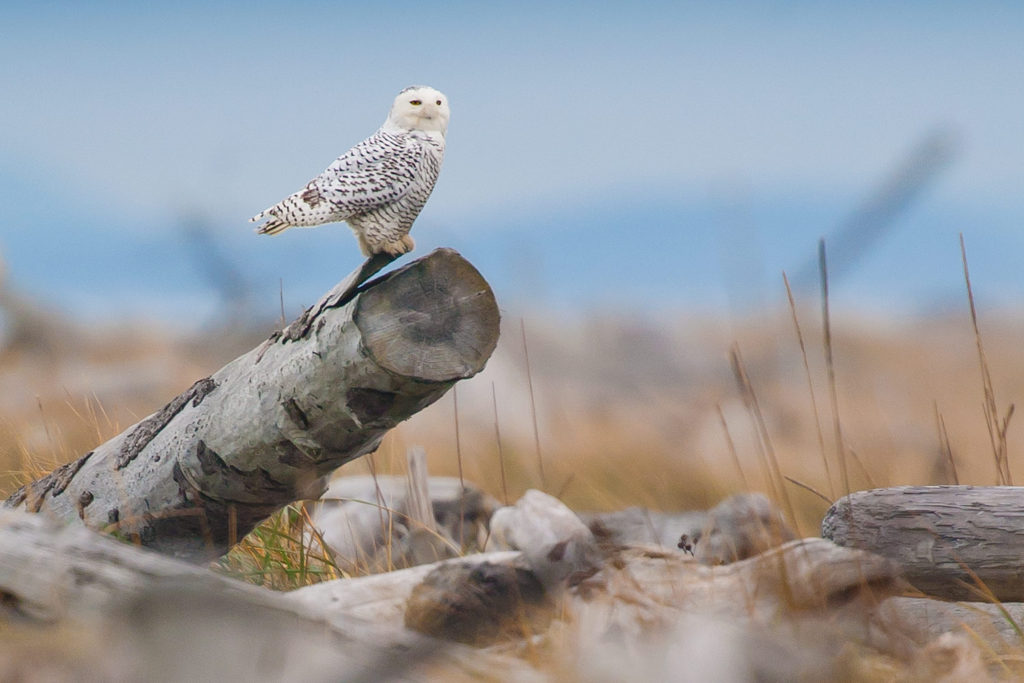 People feeding bears to get a photo and then the bear becomes aggressive so it “has” to be shot.
People feeding bears to get a photo and then the bear becomes aggressive so it “has” to be shot.
Wildlife photography can become an aggressive activity when the photographer cares more about their photograph than they do about the well-being of their subject. Our cardinal rule for wildlife photography, my wife’s and mine, is that if we are changing the behavior of the animal, then we are too close. This is certainly the most common infraction among photographers.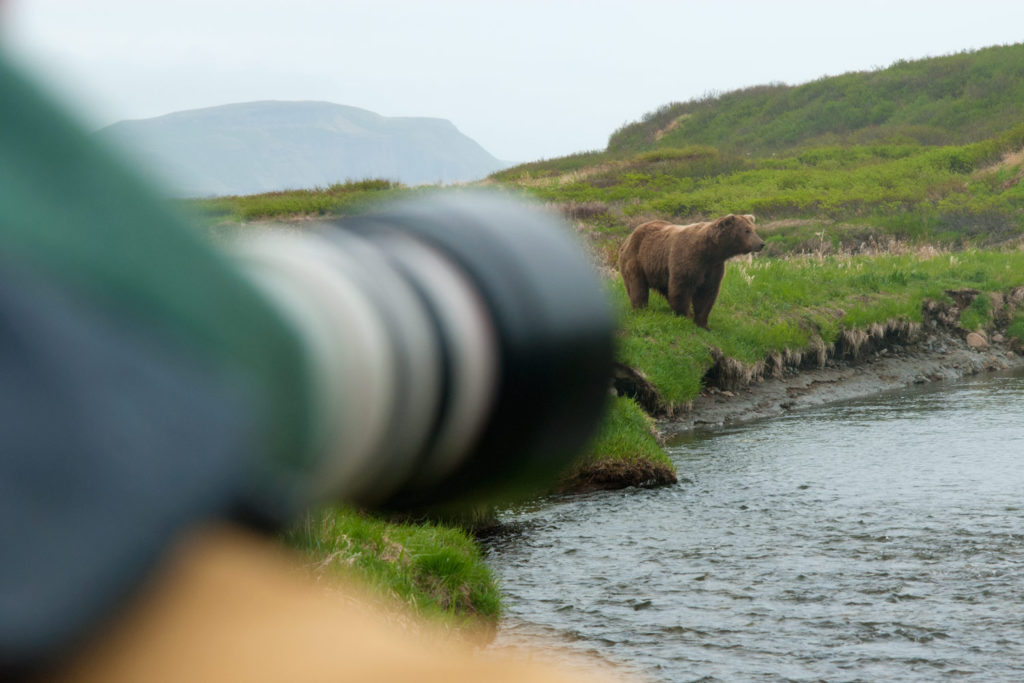
When you get too close, you make an animal stop what it’s doing because it has to keep an eye on you. 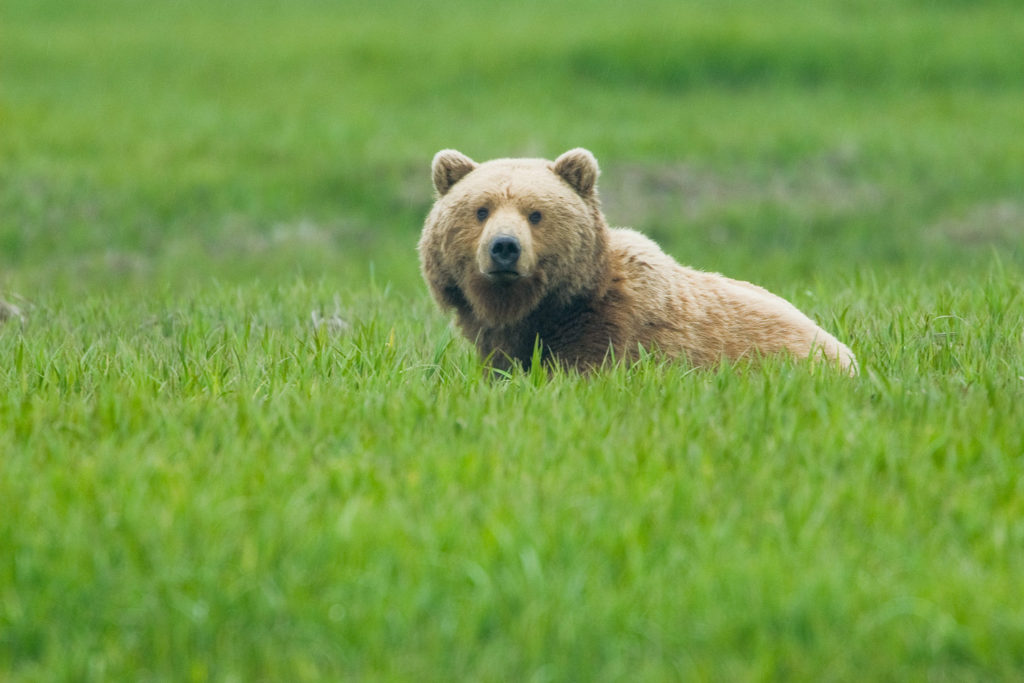 If it was feeding, then you are depriving it of energy, and it only has so much time in a day to collect that energy. Perhaps those ten seconds won’t have a huge impact on the animal, but the cumulative effect of, let’s say in a national park where hundreds of people may come across the same animal, could literally mean the difference between life and death if they are no longer able to pack on enough fat to survive the winter.
If it was feeding, then you are depriving it of energy, and it only has so much time in a day to collect that energy. Perhaps those ten seconds won’t have a huge impact on the animal, but the cumulative effect of, let’s say in a national park where hundreds of people may come across the same animal, could literally mean the difference between life and death if they are no longer able to pack on enough fat to survive the winter.
If you get even closer still, you cause the animal to run. 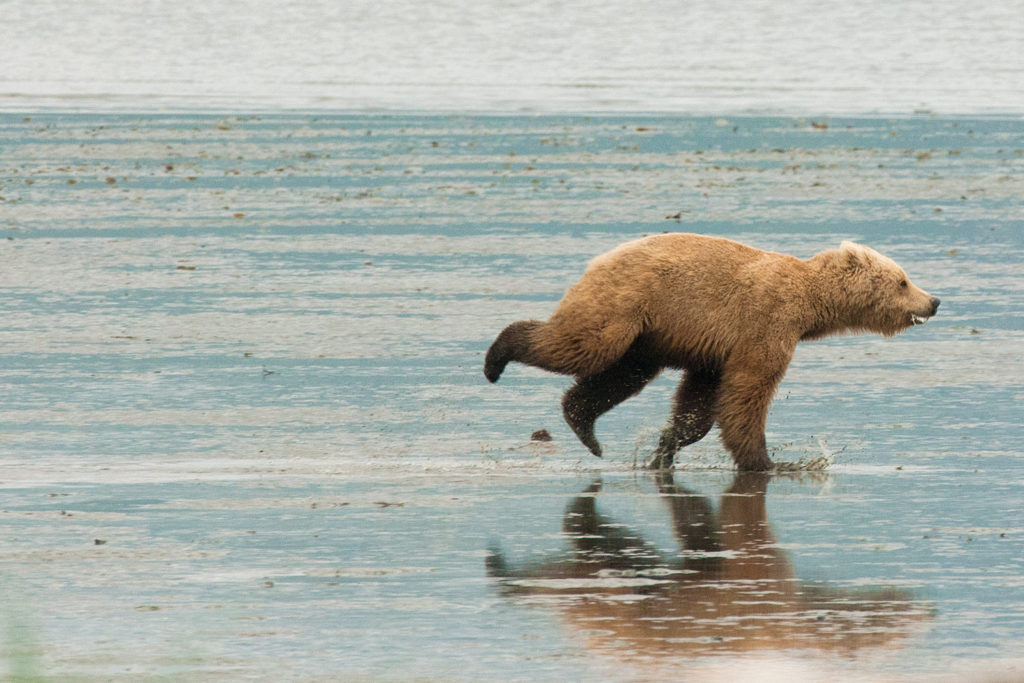 This actually makes them use up their energy. Maybe that animal needs her energy to produce enough milk to feed her babies back at the den and you are actually harming an entire family.
This actually makes them use up their energy. Maybe that animal needs her energy to produce enough milk to feed her babies back at the den and you are actually harming an entire family.
If you get even closer still, especially if you’re dealing with a mother protecting her young, you may give an animal no choice but to attack. 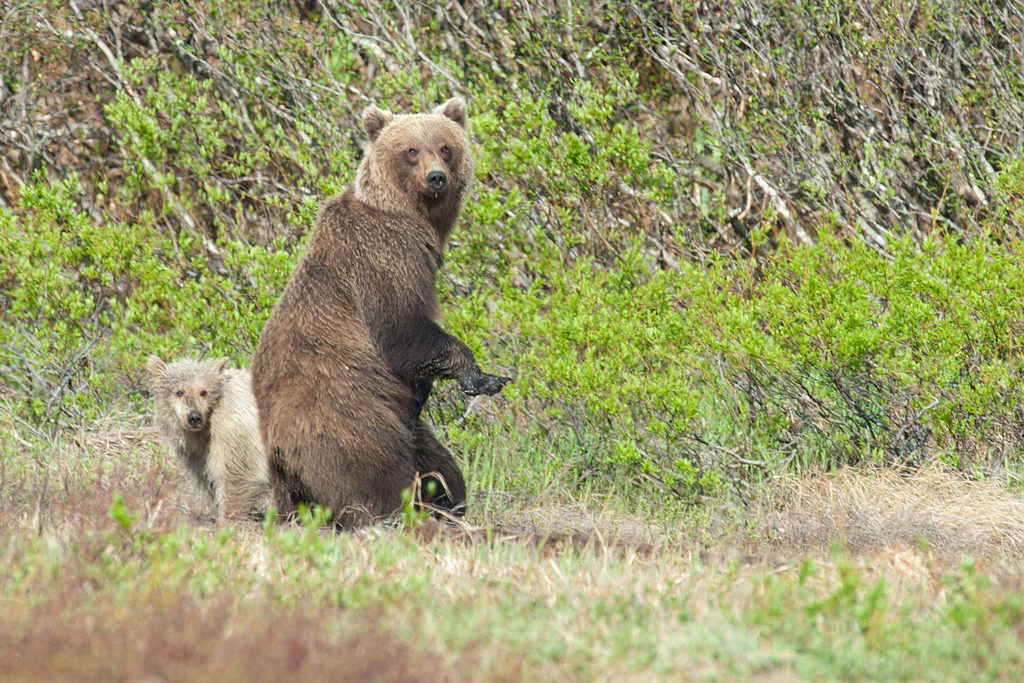 When we’re dealing with larger animals, this is obviously dangerous to you because you may get killed, but it is also dangerous to the animal you just provoked. For example if you get too close to a bear or an elk and it attacks you, it will be labeled a “problem animal” and will often end up being shot to prevent further attacks.
When we’re dealing with larger animals, this is obviously dangerous to you because you may get killed, but it is also dangerous to the animal you just provoked. For example if you get too close to a bear or an elk and it attacks you, it will be labeled a “problem animal” and will often end up being shot to prevent further attacks.
This is also very bad for the conservation of the entire species. One of the main obstacles to bear conservation is people’s belief that bears are dangerous. When a bear attack makes the news because some idiot got too close or tried to feed them, then this reinforces the idea in the minds of the public that bears are dangerous. When people are afraid of bears, then they don’t support the idea of reintroducing them into their former habitats. But I can tell you from a lot of personal experience, bears are not vicious killers. 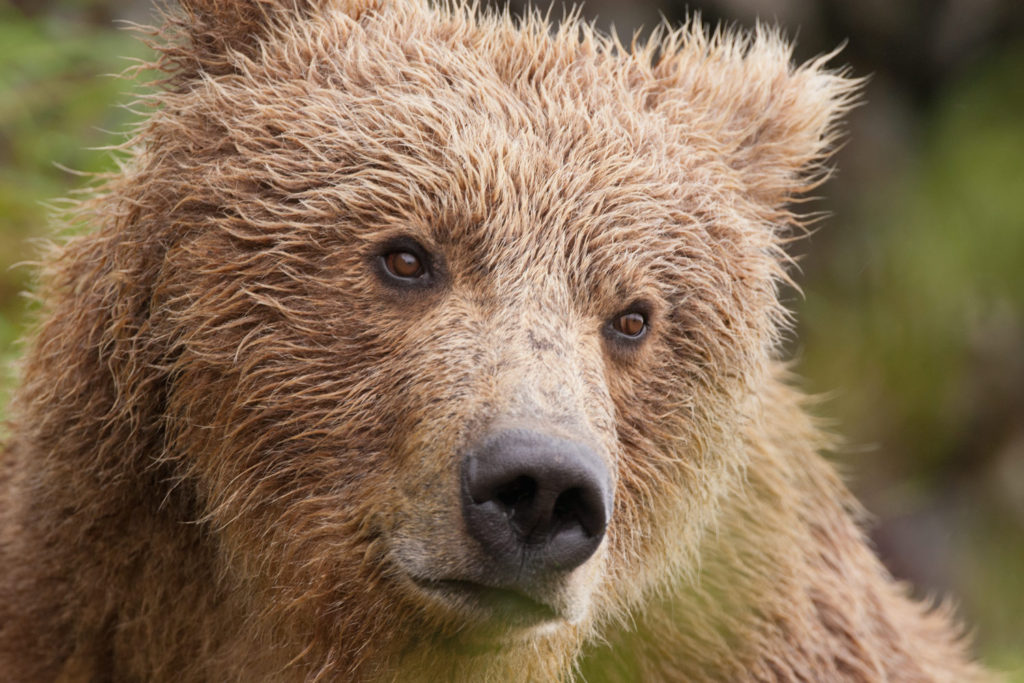 They may occasionally defend themselves when they have to, but without a doubt it is the humans that are the vicious killers. It is our irresponsible behavior that causes conflict with bears.
They may occasionally defend themselves when they have to, but without a doubt it is the humans that are the vicious killers. It is our irresponsible behavior that causes conflict with bears.
The Wildlife Selfie.
Perhaps the worst emerging problem with wildlife photography is the wildlife selfie. Ugh. This one really kills me. I’ve seen it over and over. People pulling out their phone, getting closer and closer, and trying to get a photo of themselves next to a wild animal so they can post it on facebook.
Look, I get it. We all love animals, we want to be close to them, we want to interact with them, and we want to show other people how cool we are because we got close to this amazing animal. We’ve all done it. I’ve done it.
I crept up close to a leopard seal in Antarctica because it has a reputation for being a scary animal. I took a picture of myself next to this leopard seal and I posted it online and I thought to myself, “look how cool I am!”
But even if you figured out a way to get that photo that had absolutely no negative impact on the animal, you are encouraging other people to try to get that same photo. And they probably don’t give a crap what’s in the best interest of that animal. They’re going to walk out into the field right next to it and they’re going to either force it to run away over and over all day until it can’t feed itself, or they’re going to get bitten and cause that animal to put down for being a problem animal. At the very least they’ll be annoying to an individual who is just trying to go about his or her business.
Is it possible to post a wildlife selfie that doesn’t promote bad behavior among humans? Possibly, if you explicitly describe the circumstances under which it was taken, and make it clear that the animal was at a safe distance and its behavior wasn’t changed. But we don’t always read the caption under a photo do we?
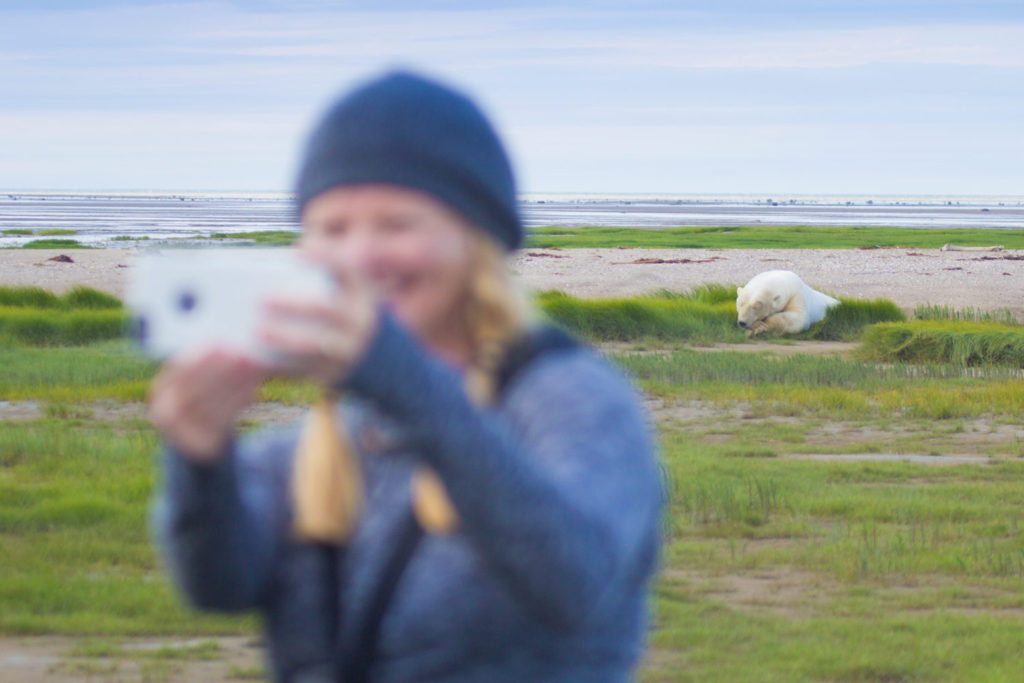
But say you really want your wildlife selfie so you convince yourself that a captive animal might be better. This is even worse! Take something as seemingly innocent as posing with an adorable slow loris on the street in Thailand. You pay the handler some money and get to hold this cute little creature while your friend takes your photo. This is pop music super star Rhianna posing with a slow loris in Thailand in 2013 on Instagram. 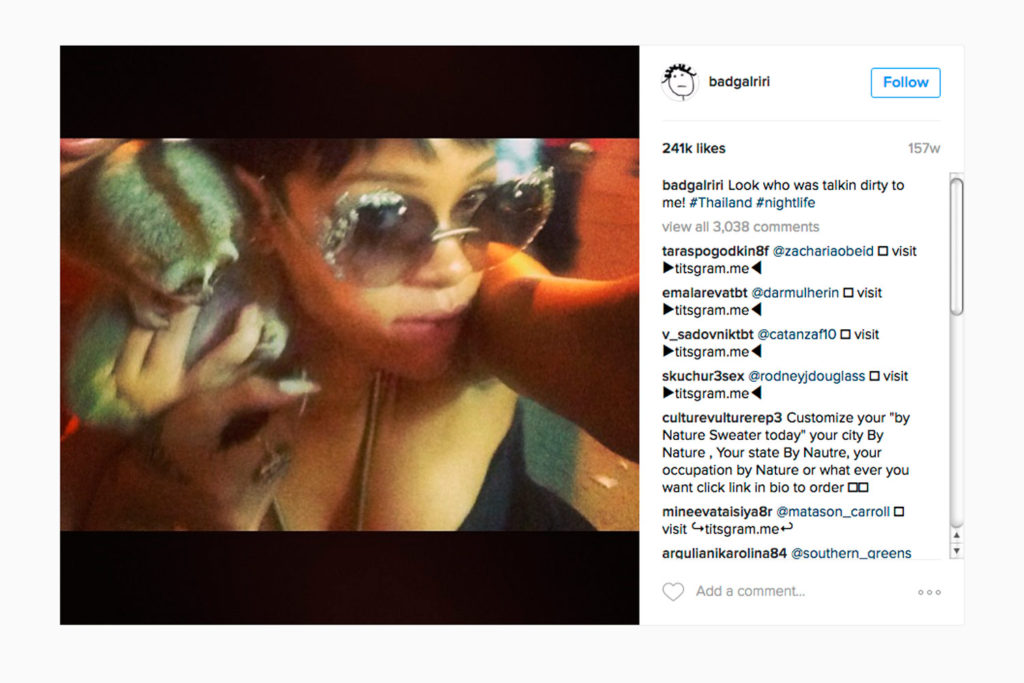 But what you don’t think about is that this little animal was stolen from the wild as a baby, taken away from its mother, had its teeth ripped out so it can’t bite you, and spends its miserable life being carried around noisy overpopulated areas, drugged, and forced to pose with tourists. Is this how you would like to live?
But what you don’t think about is that this little animal was stolen from the wild as a baby, taken away from its mother, had its teeth ripped out so it can’t bite you, and spends its miserable life being carried around noisy overpopulated areas, drugged, and forced to pose with tourists. Is this how you would like to live?
Your cute photo then makes a hundred other people want to do the same thing and the disgusting practice grows and grows.
(The good news with this particular story is that soon after this photo was posted, police in Phuket arrested the two people who were using captive lorises as photo props.)
Now take the lion petting industry in South Africa.
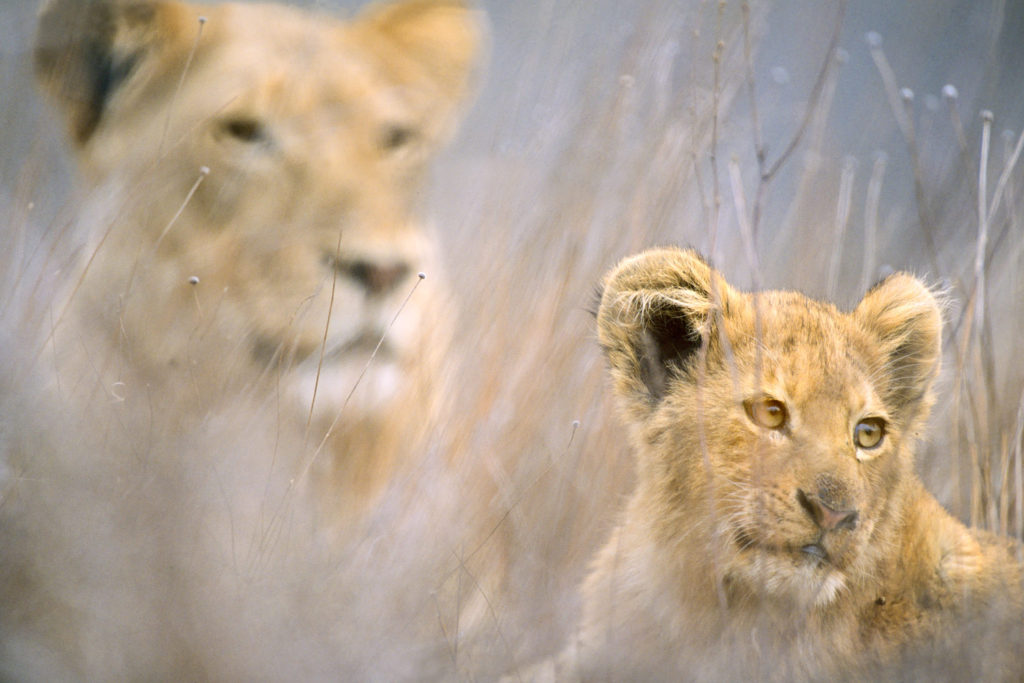
In these tourist attractions, thousands of lions are born in captivity, taken from their mothers as tiny kittens, drugged, and forced to pose with tourists for that oh-so-important facebook photo. Then when the lions get too big to be handled by the tourists, they are kept in atrocious conditions until they can be sold to the canned hunting industry where rich white guys get to pay money to shoot them. There is huge money in this business and every step of it is horrifying. The worst part is that they often convince tourists that their operation is contributing to conservation. This is pure evil and it all comes from our desire for a wildlife selfie.
This isn’t a new problem. This is me when I was six years old in a mall in Rochester, New York where I grew up. 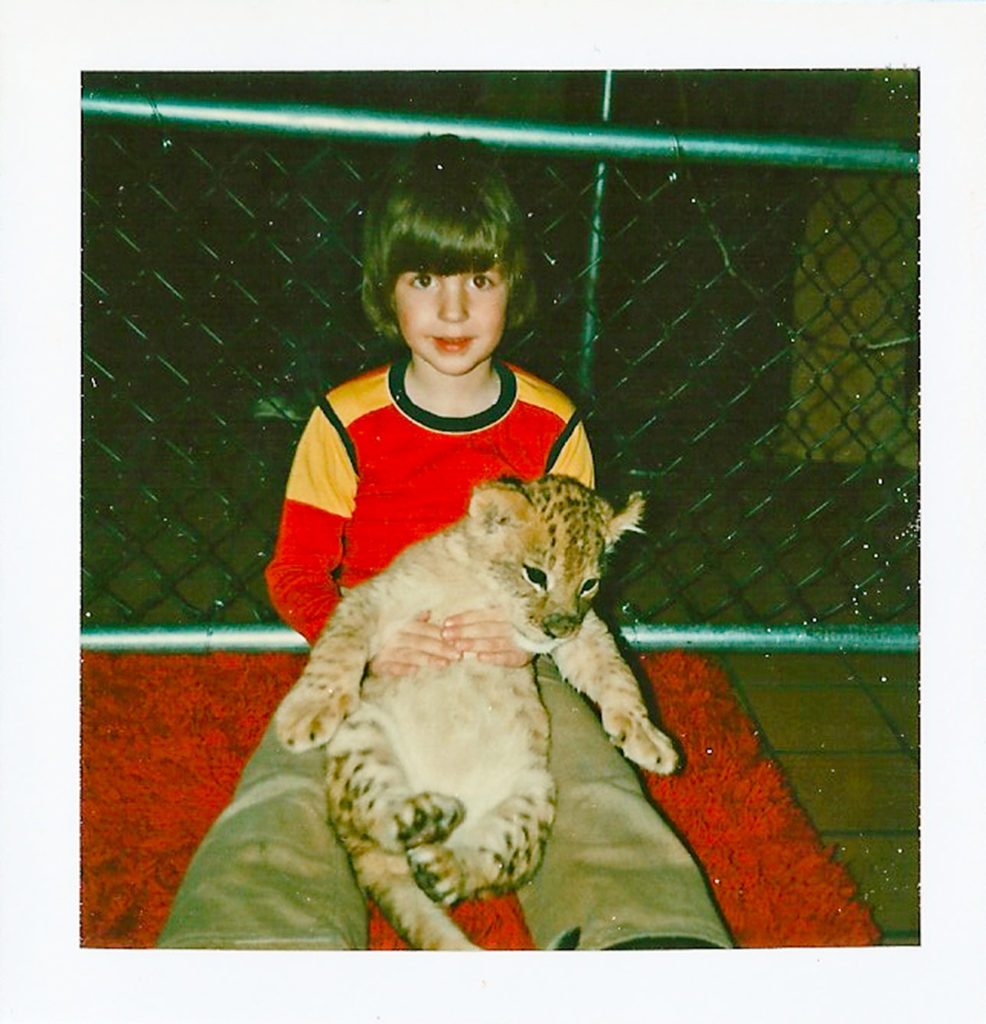 I posed with a poor drugged lion cub and I smiled for the camera. Now I look back at this photo and I feel sick to my stomach. I see this poor innocent wild animal being used as a photo prop and it makes me want to throw up. This is not wildlife photography and it is not fun. It is the worst kind of animal exploitation. If you actually care about animals, don’t do it.
I posed with a poor drugged lion cub and I smiled for the camera. Now I look back at this photo and I feel sick to my stomach. I see this poor innocent wild animal being used as a photo prop and it makes me want to throw up. This is not wildlife photography and it is not fun. It is the worst kind of animal exploitation. If you actually care about animals, don’t do it.
Irresponsible Blogging
Irresponsible blogging can have the same negative impact as irresponsible photography. It can encourage people to participate in activities that are harmful to wildlife and their habitats. We never promote activities that involve feeding wild animals to lure them, like feeding crocodiles or baited shark cage diving. There are other great ways to see sharks in the wild.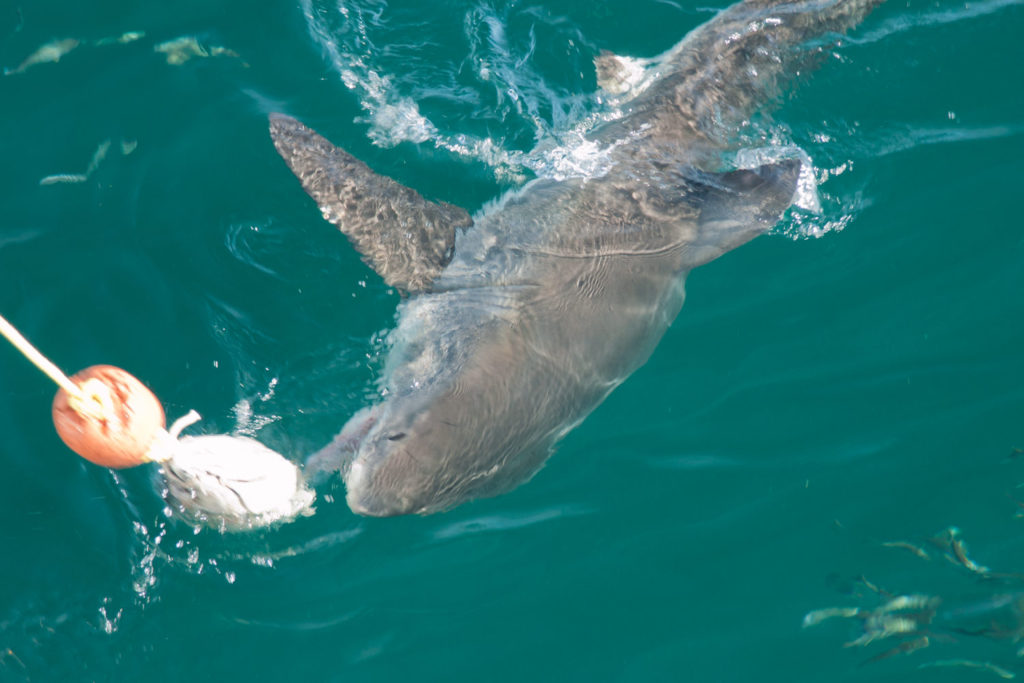 We don’t promote captive animal attractions like swim-with-dolphin facilities. There are far better ways to see dolphins in the wild.
We don’t promote captive animal attractions like swim-with-dolphin facilities. There are far better ways to see dolphins in the wild.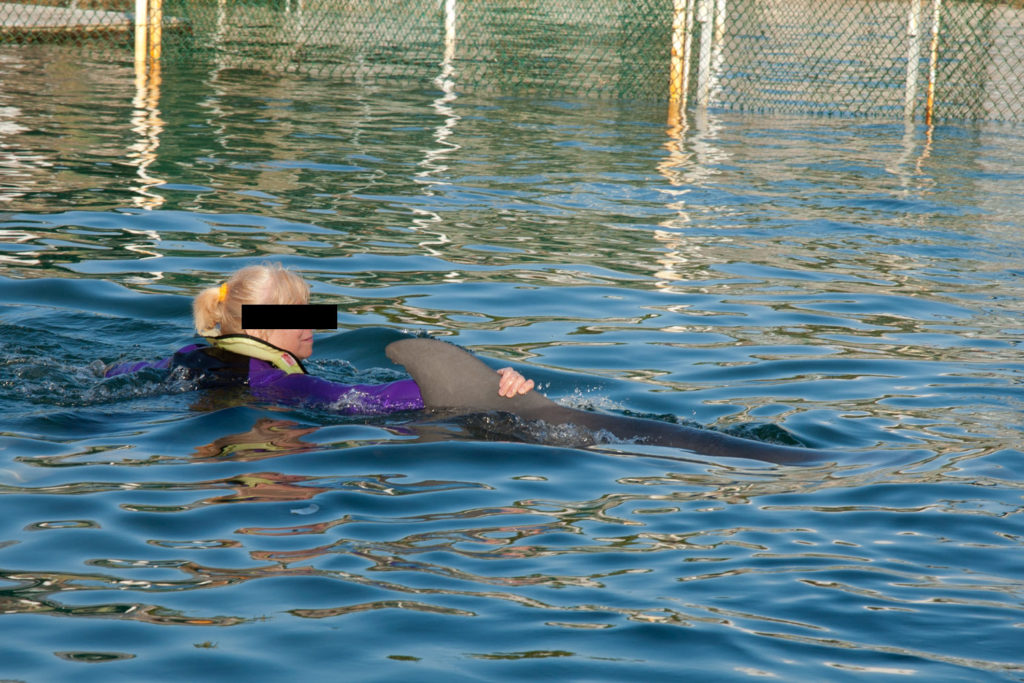 We never promote attractions where tourists ride captive wild animals like elephant rides. These are just some of the more obvious ones.
We never promote attractions where tourists ride captive wild animals like elephant rides. These are just some of the more obvious ones.
Bloggers that promote these activities are actively working against conservation. Sometimes it is merely out of ignorance, and sometimes they just don’t care. But in either case, they cause these abusive practices to spread.
But to package these activities as a “green” or “eco” because they’ve received a free trip represents a real danger to the integrity of all responsible bloggers. When you call yourself green and have a big reach and people are depending on you to help them choose the most environmentally friendly tourism options, you suddenly have the power to do more harm than good.
Summary
I believe that people want to do the right thing. Sometimes we just need a little help figuring out what that is, and we all have the ability to learn and evolve and change along the way. When handled responsibly, these two little things, photos and words, can make a huge positive impact on our beliefs and behaviors and, therefore, on our amazing community of life.
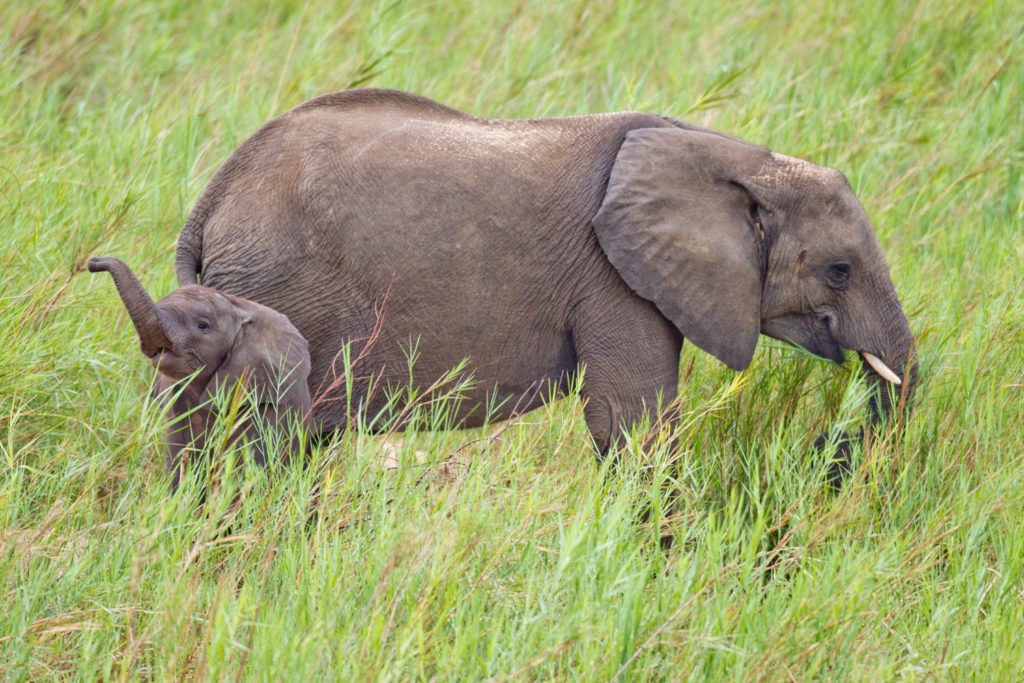
Do you all remember your homework assignments?
1) Get out of your house and take a photo of some living thing, in your yard or neighborhood.
2) Go home and try to figure out what species you’re looking at. Read about it and learn something interesting, because there is something interesting about every single living thing on this planet.
3) Post your photo, the name of the species, and your interesting fact on your favorite social media platform. Tell people where you saw it.
Remember, don’t get so close that you change its behavior, and avoid the wildlife selfie. But do have fun exploring and connecting with nature and then share it with someone else. Then see what happens next!
Did you enjoy this article? Then pin this image!
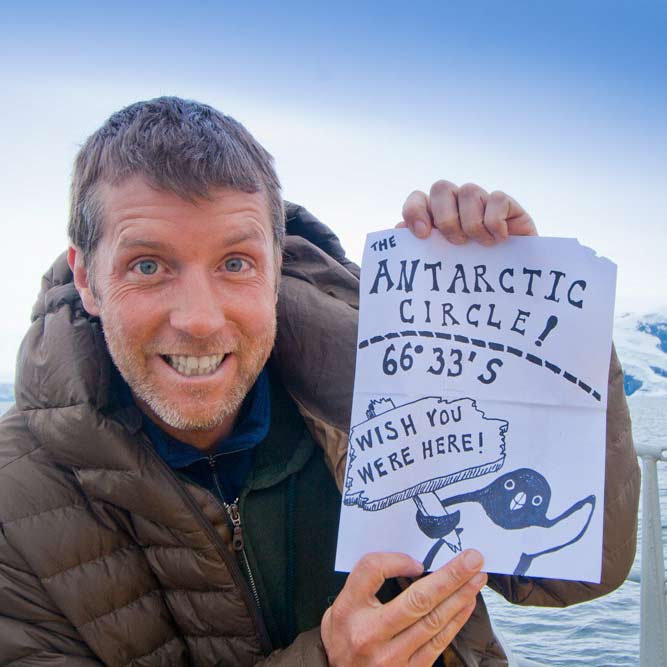
Hal Brindley
Brindley is an American conservation biologist, wildlife photographer, filmmaker, writer, and illustrator living in Asheville, NC. He studied black-footed cats in Namibia for his master’s research, has traveled to all seven continents, and loves native plant gardening. See more of his work at Travel for Wildlife, Truly Wild, Our Wild Yard, & Naturalist Studio.

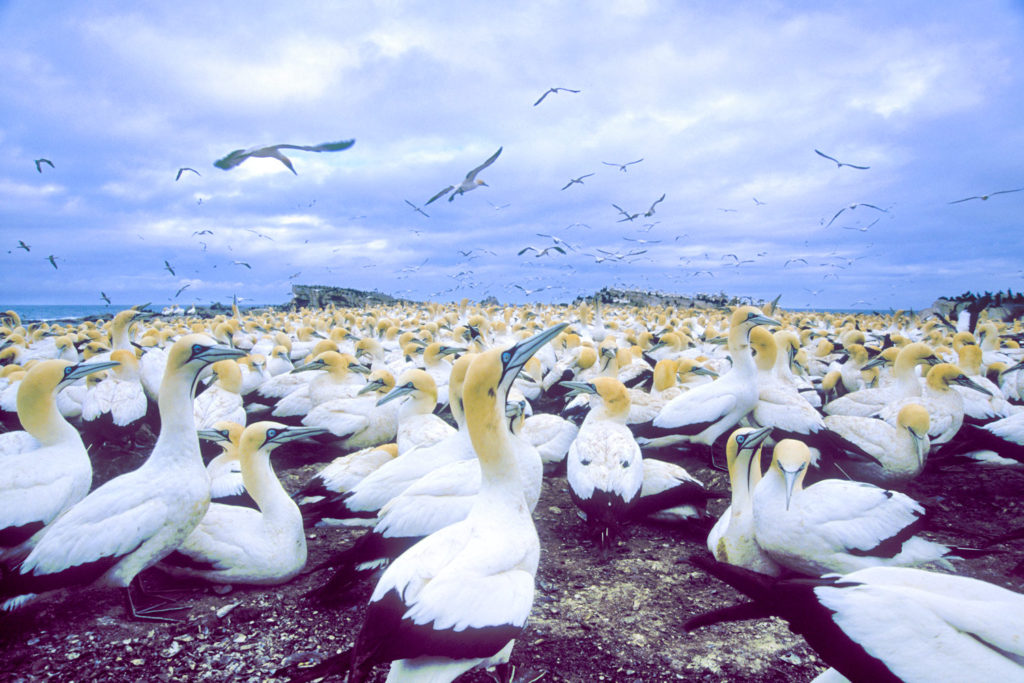
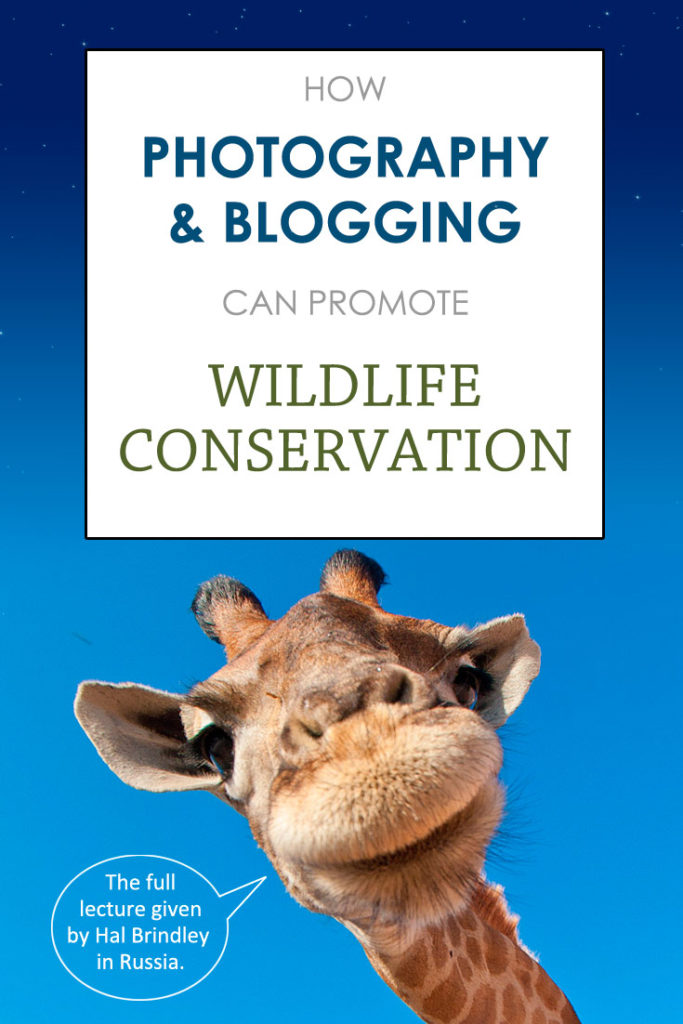
Priyantha de Alwis
Tuesday 18th of January 2022
Super . You had written already what I was thinking in parts and try to merge together. In Sri Lanka, we have a sizable population of leopards. In weekends [specially in Yala national park] more than 400 safari vehicles roam looking for this elusive cat. We know, with the help of research findings, that majority of tourists hate this leopard watching with an army of safari jeeps competing each other. But life goes on as bad as ever for leopards.
cristina garcia
Tuesday 25th of January 2022
Oh yeah, I think that 400 vehicles seem way too many. Not great for anyone's experience, specially the leopard.
Hal Brindley
Monday 30th of April 2018
Thanks Dillon, glad you enjoyed it! I checked out your blog and it's really great work too! Keep it up! -Hal